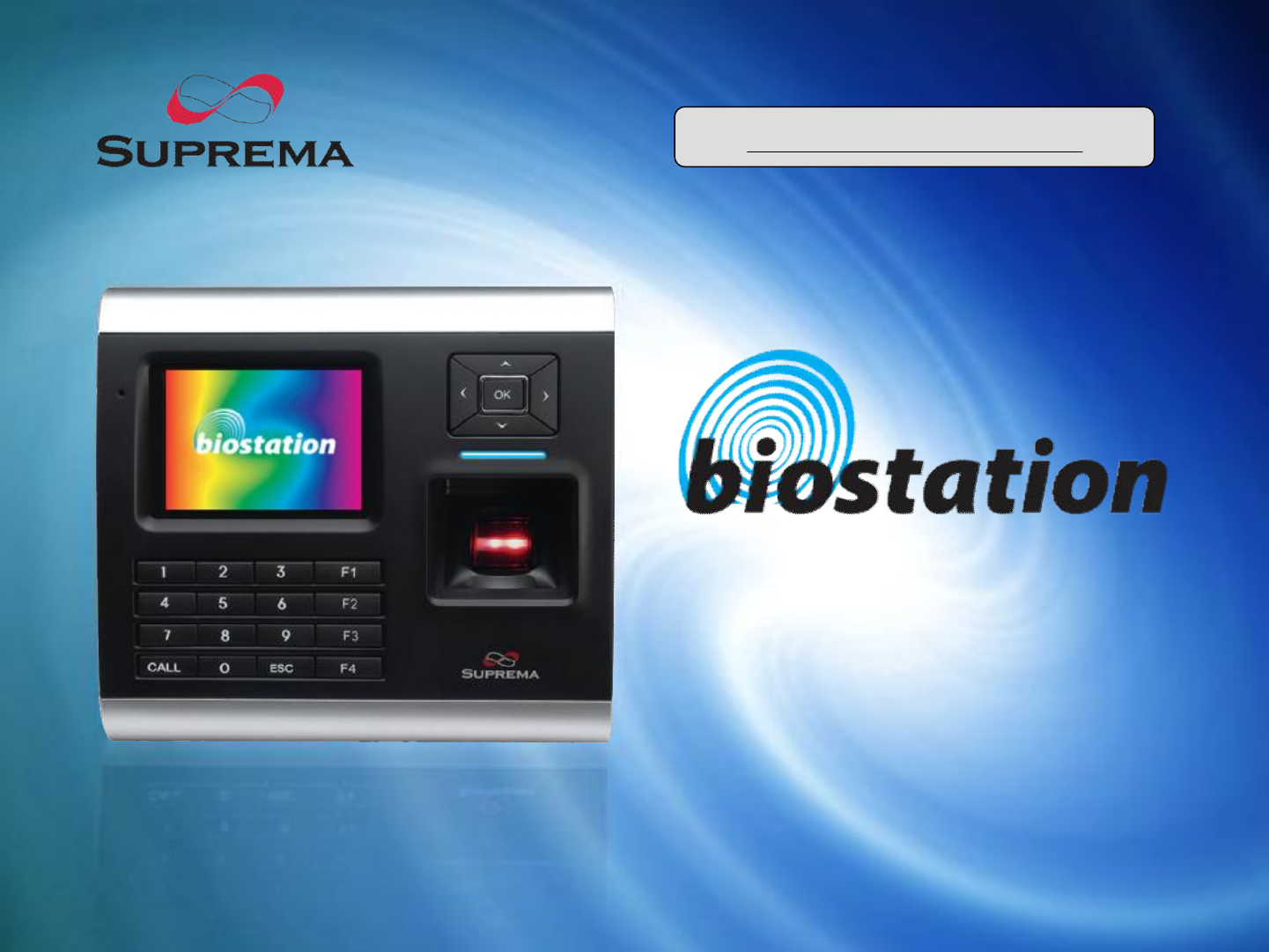User manual
CAUTION: Changes or modifications not expressly approved by the manufacturer
responsible for compliance could void the user’s authority to operate the equipment
WAR NING
This device complies with part 15 of the FCC Rules. Operation is subject to the
following two conditions: (1) This device may not cause harmful interference, and (2)
this device must accept any interference received, including interference that may cause
undesired operation.
INFORMATION TO USER:
This equipment has been tested and found to comply with the limit of a Class B digital
device, pursuant to Part 15 of the FCC Rules. These limits are designed to provide
reasonable protection against harmful interference in a residential installation. This
equipment generates, uses and can radiate radio frequency energy and, if not installed
and used in accordance with the instructions, may cause harmful interference to radio
communications. However, there is no guarantee that interference will not occur in a
particular installation; if this equipment does cause harmful interference to radio or
television reception, which can be determined by turning the equipment off and on, the
user is encouraged to try to correct the interference by one or more of the following
measures:
1. Reorient / Relocate the receiving antenna.
2. Increase the separation between the equipment and receiver.
3. Connect the equipment into an outlet on a circuit difference from that to which
the receiver is connected.
4. Consult the dealer or an experienced radio/TV technician for help
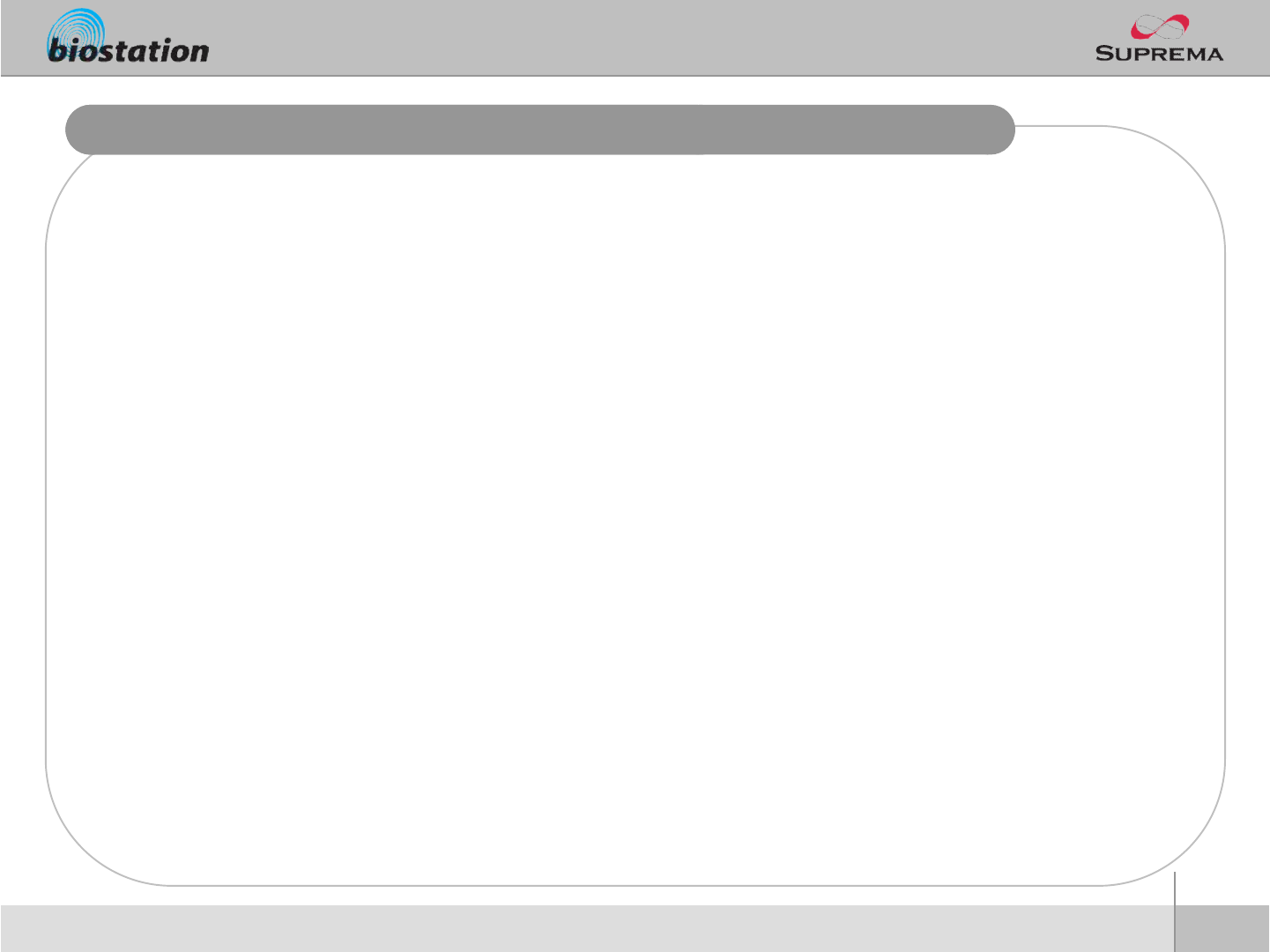
2
ⒸCopyright 2006 Suprema Inc.
Innovative Fingerprint Terminal for Access Control and Time Attendance
nFingerprint recognition, now look and feel!
lFeatures 2.5" 16M color LCD to display multimedia contents including animation and photos.
nInvincible speed and capacity
lDelivers fingerprint identification speed to perform 3,000 matches in 1 second and internal memory
storing up to 50,000 fingerprints and 500,000 event logs.
nNo more wiring!
lProvides various external interfaces including Wi-Fi wireless LAN for easy access to the internal
user info and event log from a remote PC. (Optional)
nData into your USB drive
lUsing USB memory, copies and backs up user info and event log data very easily.
nWorld’s best fingerprint recognition algorithm
lWorld’s most reliable fingerprint solution that ranked No. 1 in an international fingerprint algorithm
contest (FVC2004 & FVC2006) with the lowest error rate.
nVarious fingerprint sensors
lSupports various fingerprint sensors, including optical, capacitive, and thermal swipe, so users can
choose the most suitable fingerprint sensor for their application.
nRF Card Support!
lRF module is built in a Terminal itself. Fingerprint, card, and password can be selected as the
authentication method for each user.
nReal Time Network operation through Server!
lConnected to the BioAdmin Server, terminals can be managed in real time.
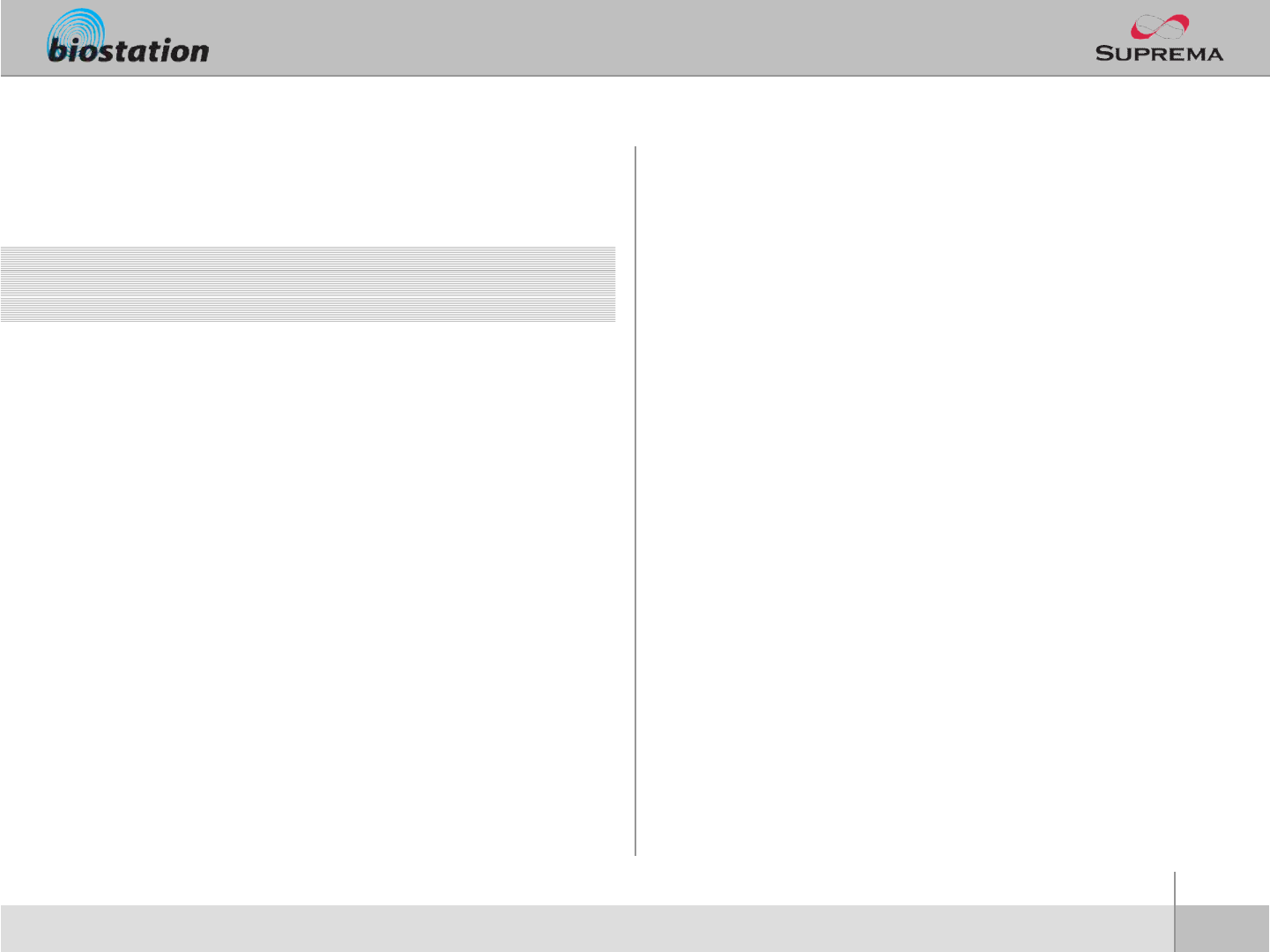
3
ⒸCopyright 2007Suprema Inc.
Contents
Before start
lSafety precautions 5
lGlossary 7
lBasics of fingerprint recognition 8
lHow to place a finger 9
lProduct Contents 11
lName of each part 13
lInstallation 15
lCable spec. 16
For administrators (Basic functions)
lEnter Admin menu 18
lUsing Admin menu 19
lOperation mode setting 20
lNetwork setup
–TCP/IP 23
–Wireless LAN 24
–Server 25
–USB 27
lUser management
–Enroll New User 28
–Check User Info 32
–Edit User Info 33
–Delete User 34
–Delete All Users 35
–Check User DB 36
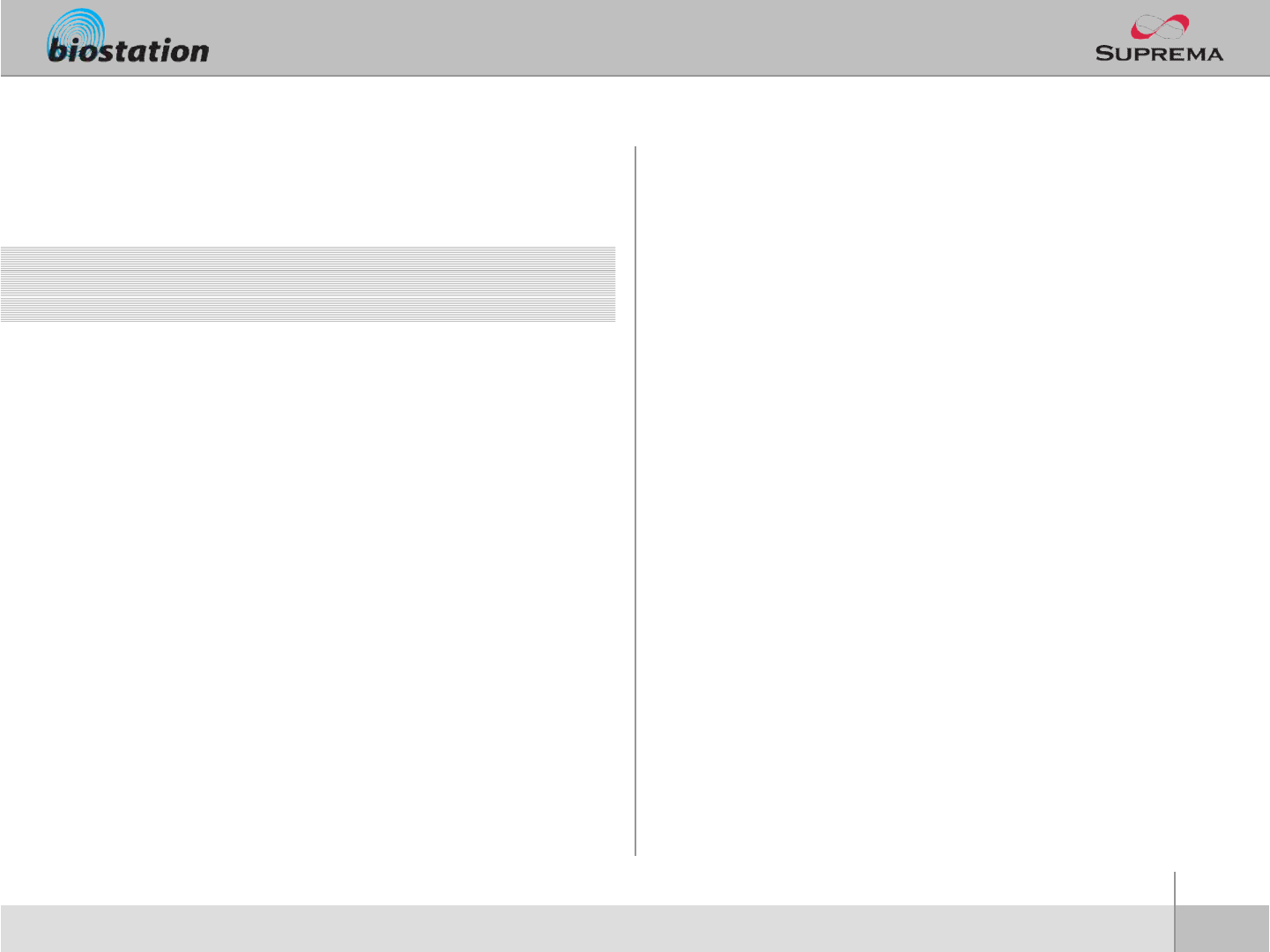
4
ⒸCopyright 2007Suprema Inc.
Contents
For Administrators (Advanced functions)
lDisplay & sound setting 38
lDevice setup
–Fingerprint Setting 40
–I/O Setting 43
–Door Relay Setting 45
–Zone 48
–Sub Zone 49
–APB Zone 50
–Change Master Password 51
–View Device Info 52
–Device Reset 53
–Factory Default 54
lLog
–Check log 55
–Filter log 56
–Delete entire log 57
lUSB memory 58
For General Users
lOpen door
–Access using 1:N mode 61
–Access using 1:1 mode 62
lUsing T&A event
–T&A event using 1:N mode 64
–T&A event using 1:1 mode 65
–Using extended T&A events 66
lView user’s Access/T&A event records 67
lAuthentication procedure as per operation mode 68
lAuthentication procedure for T&A event 69
Appendix
lSpecifications 70
lTroubleshooting 71
lDevice cleaning 72
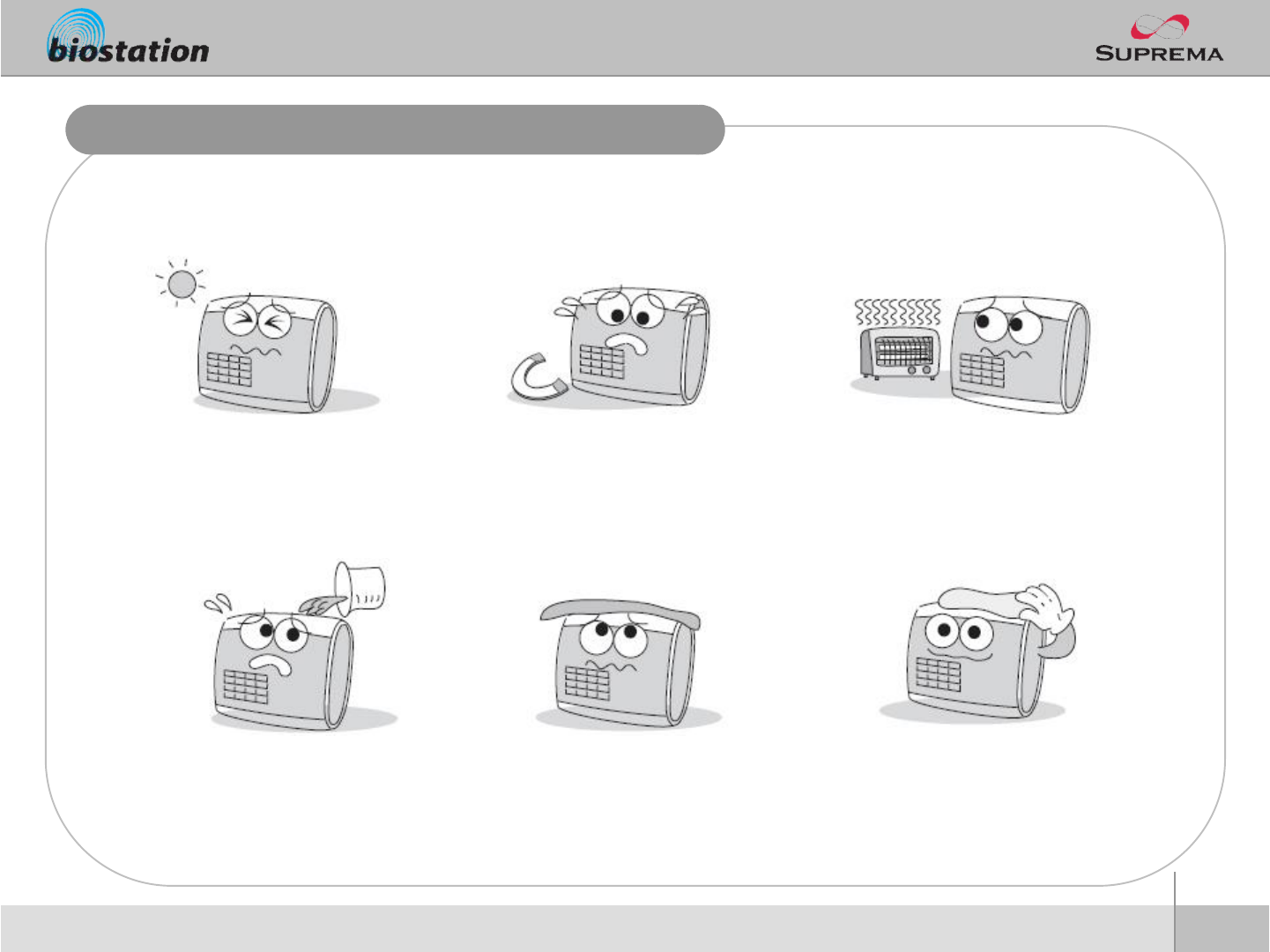
5
ⒸCopyright 2006 Suprema Inc.
Safety precautions
nThe list below is to keep user’s safety and prevent any loss. Please read carefully before
use.
Do not install the device in a
place subject to direct sun light,
humidity, dust or soot.
Do not place a magnet near the
product. Magnetic objects such a
s magnet, CRT, TV, monitor or
speaker may damage the device
.
Do not place the device next to
heating equipments.
Be careful not to let liquid like
water, drinks or chemicals leak
inside the device.
Clean the device often to remove
dust on it.
In cleaning, do not splash water
on the device but wipe it out with
smooth cloth or towel.
Before Start
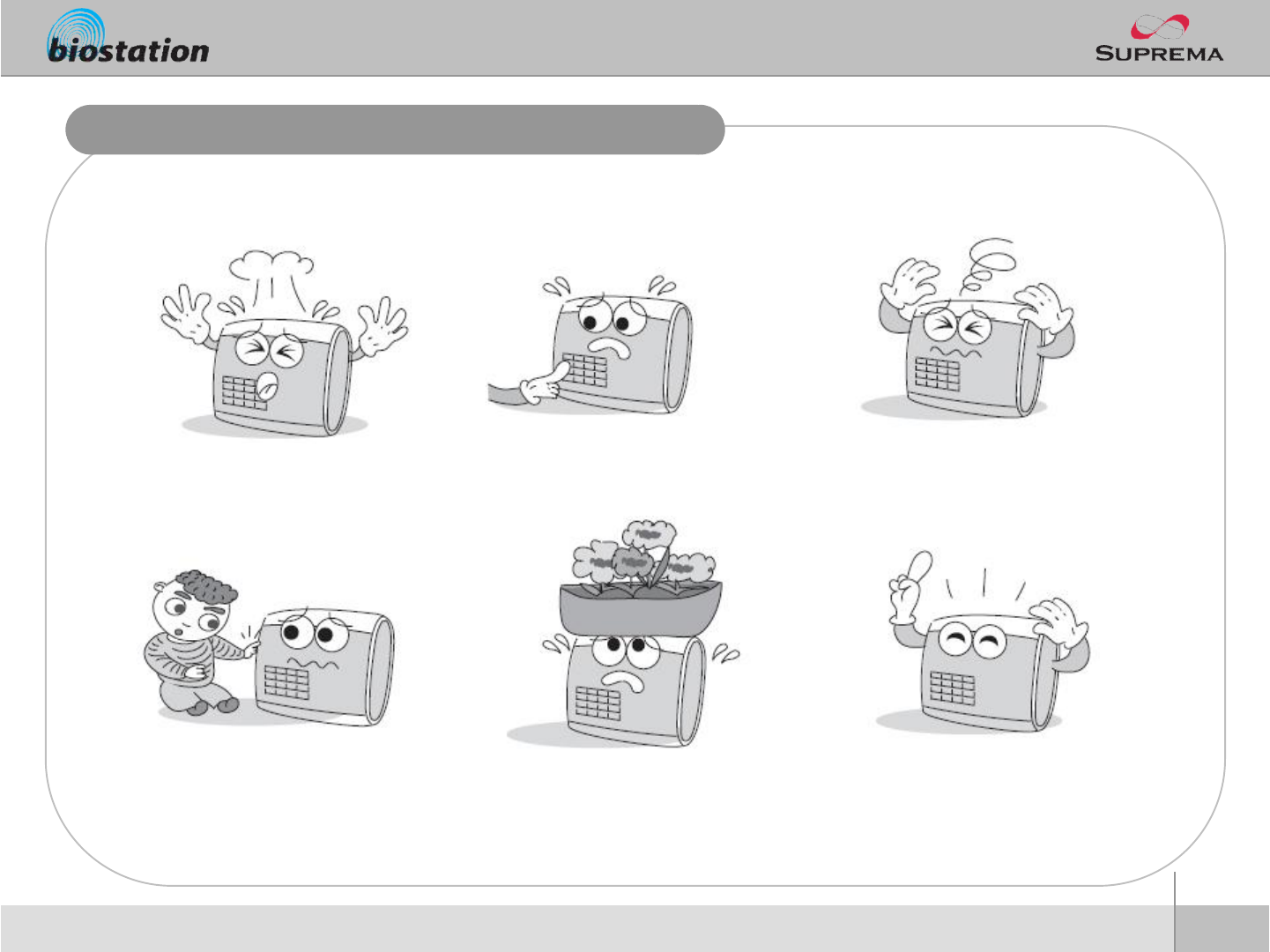
6
ⒸCopyright 2006 Suprema Inc.
Safety precautions
nThe list below is to keep user’s safety and prevent any loss. Please read carefully before
use.
Do not drop or damage the
device.
Do not press two buttons at the
same time.
Do not disassemble, repair or
alter the device.
Do not let children touch the
devicewithout supervision.
Do not use the device for any
other purpose than specified.
Contact your nearest dealer in
case of a trouble or problem.
Before Start
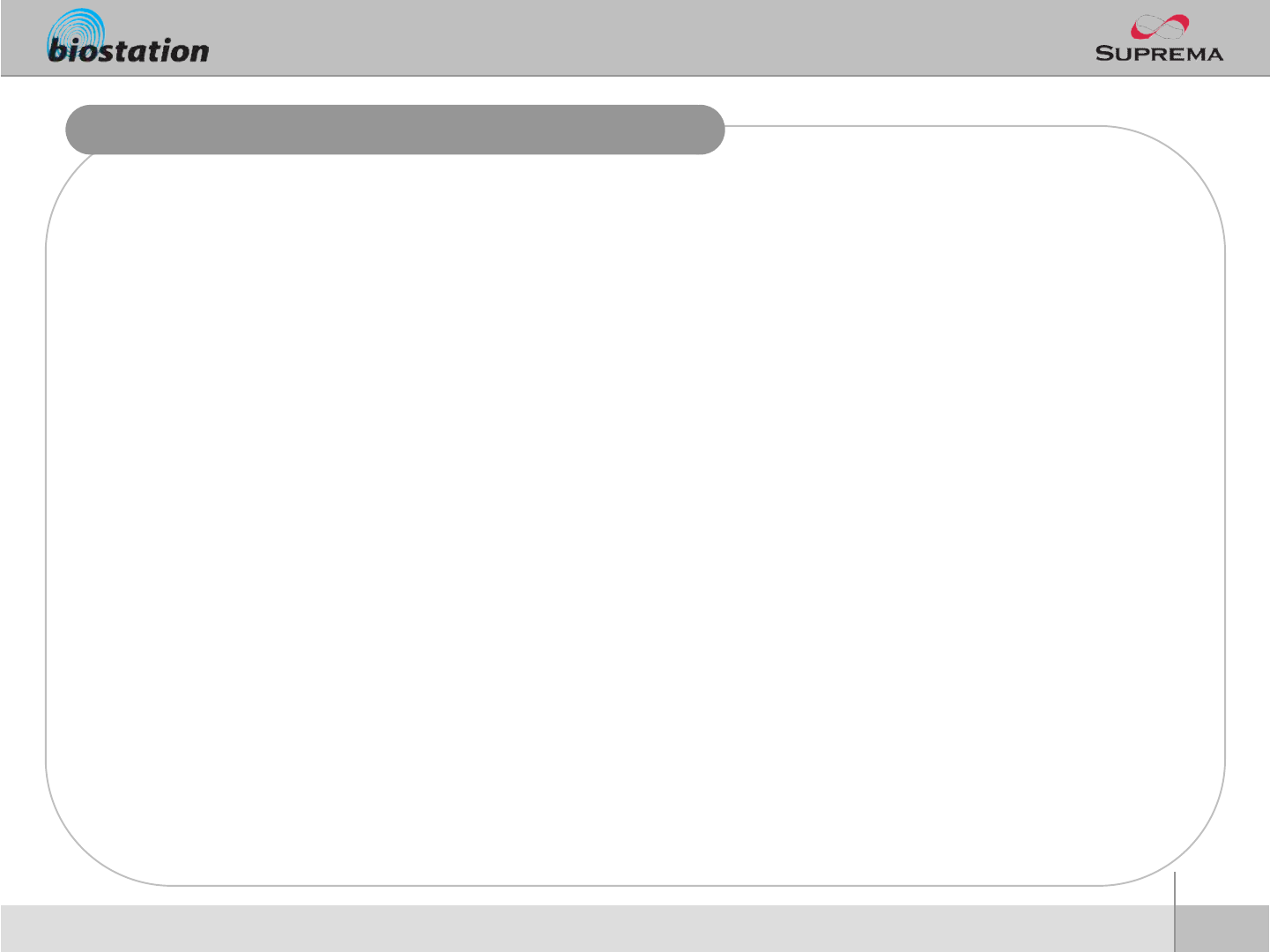
7
ⒸCopyright 2006 Suprema Inc.
Glossary
nAdministrator
lA special user who are authorized to manage the settings and user information of a device.
Administrators can enroll or delete users and change settings ofthe device.
n1:1 Mode
lIn 1:1 mode, a user should enter his/her user ID first. After then, the user is requested to place a
finger or enter a PIN. In this mode, user’s scanned fingerprint is matched against only one
fingerprint specified by the user ID.
n1:N Mode
lIn 1:N mode, a user places his/her finger without entering any ID. Then the device compares the
user’s scanned fingerprint with the whole enrolled fingerprints in its internal database.
nFingerprint Enrollment
lA process of extracting features of a fingerprint image obtainedfrom a fingerprint sensor and
saving them into the internal memory of a device. The fingerprint data is called a fingerprint
template.
Before Start
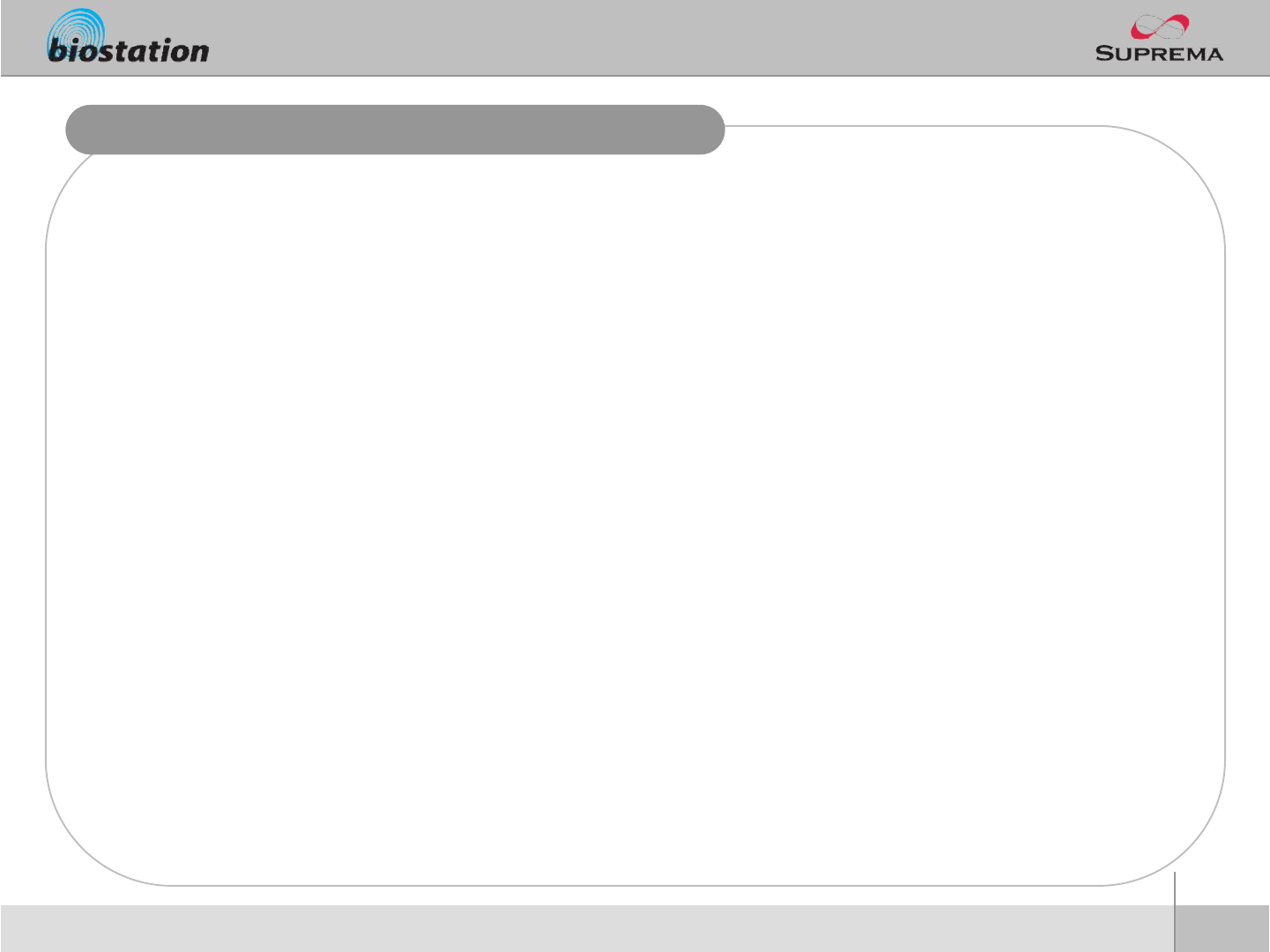
8
ⒸCopyright 2006 Suprema Inc.
Basics of fingerprint recognition
nWhat is fingerprint recognition?
lFingerprint is an individual’s own biometric information and does not change throughout his/her life.
Fingerprint recognition is a technology that verifies or identifies an individual using such fingerprint
information.
lFree from the risk of theft or loss, fingerprint recognition technology is being widely used in security
systems replacing PIN or cards.
nProcess of fingerprint recognition
lFingerprint consists of ridges and valleys. Ridge is a flow of protruding skin in a fingerprint while
valley is a hollow between two ridges. Each individual has different pattern of ridges and valleys
and finger recognition makes use of such originality and uniqueness of these patterns.
lFingerprint sensor generates 2-dimentional fingerprint image using different technology. According
to the sensing technology, fingerprint sensors are classified into optical, capacitive, or thermal.
lFingerprint template is a collection of numeric data representing the features of a fingerprint.
Fingerprint templates are saved inside the memory of BioStation and used for identification.
nSecure way to protect personal information
lTo avoid privacy concern, Suprema’s fingerprint products do not save fingerprint images itself. Itis
impossible to reconstruct a fingerprint image from a fingerprinttemplate which is just numeric data
of the features of a fingerprint.
Before Start
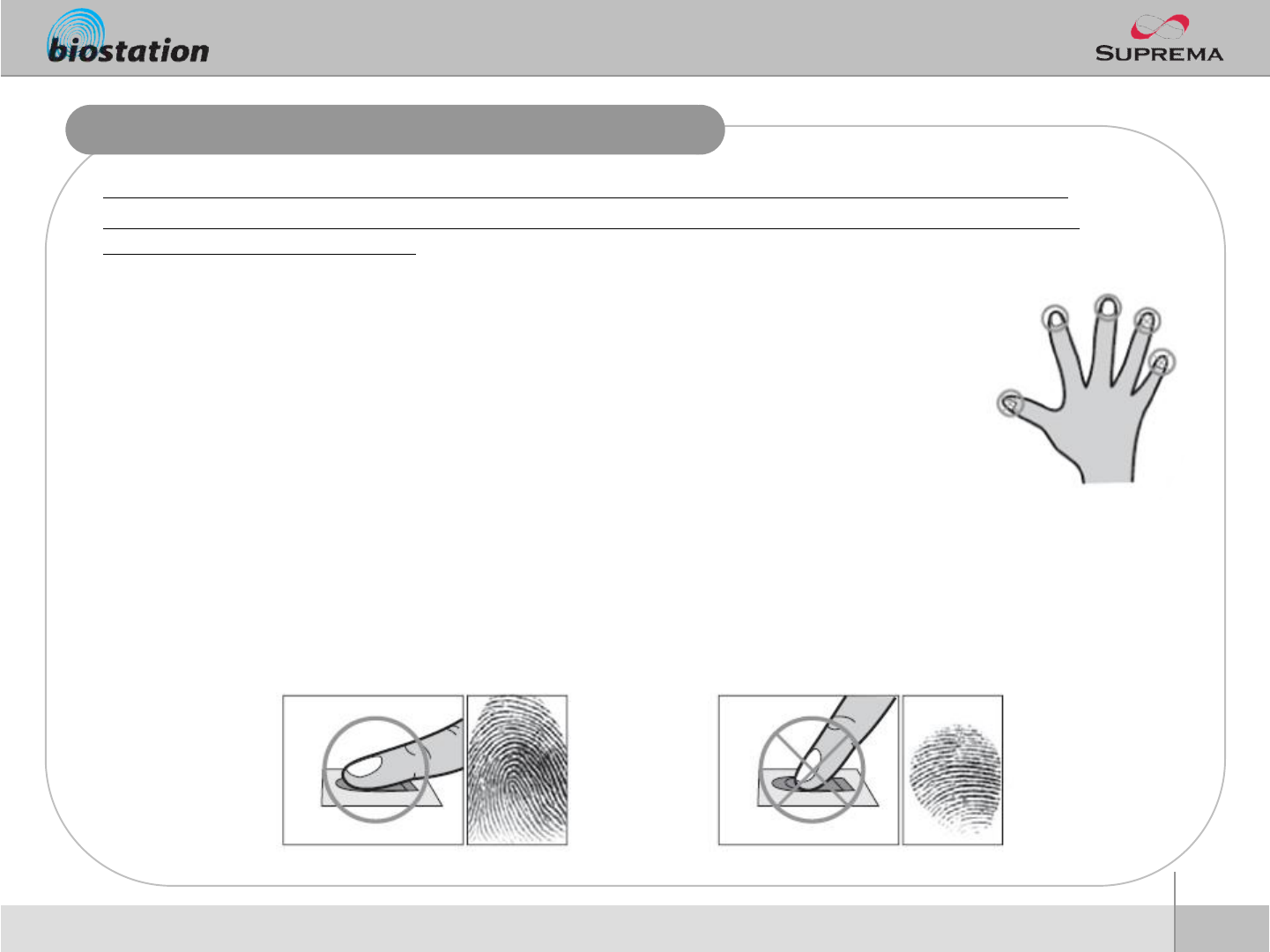
9
ⒸCopyright 2006 Suprema Inc.
How to place a finger
nSelect a finger to enroll
lIt is recommended to use an index finger or a middle finger.
lThumb, ring or little finger is relatively more difficult to place in a correct position.
nHow to place a finger on a sensor
lPlace a finger such that it completely covers the sensor area with maximum contact.
lPlace core part of a fingerprint to the center of a sensor.
§People tend to place upper part of a finger.
§The core of a fingerprint is a center where the spiral of ridgesis dense.
§Usually core of fingerprint is the opposite side of the lower part of a nail.
§Place a finger such that the bottom end of a nail is located at the center of a sensor.
lIf a finger is placed as in the right picture, only a small areaof a finger is captured. So it is
recommended to place a finger as shown in the left picture.
Suprema’s fingerprint products show an outstanding recognition performance regardless of the user’s fingerprint
skin condition or the way of fingerprint positioning. However, following tips are recommended to get more optimal
fingerprint recognition performance.
Before Start
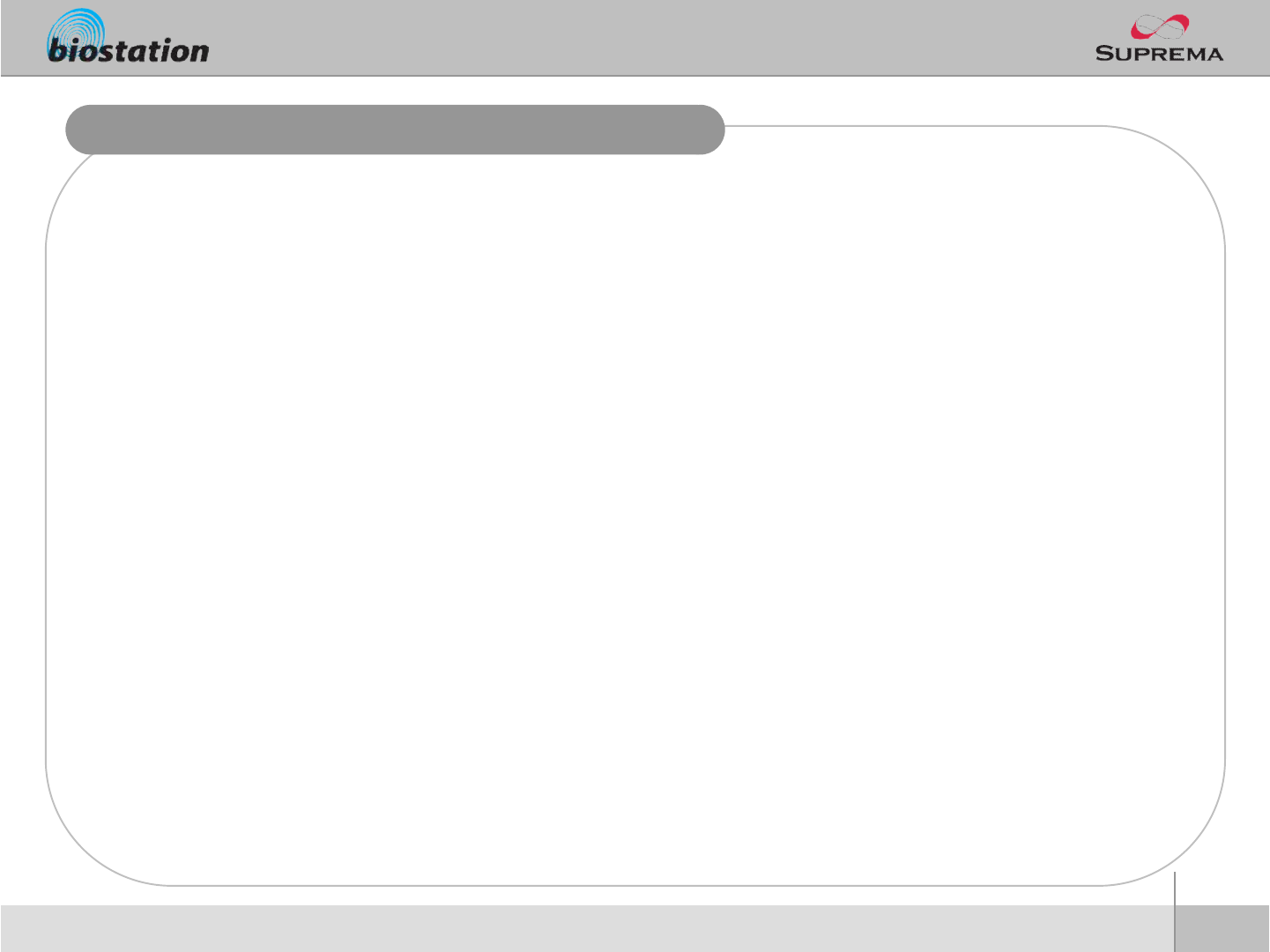
10
ⒸCopyright 2006 Suprema Inc.
How to place a finger
nTips for different fingerprint conditions
lSuprema’s fingerprint products are designed to scan fingerprint smoothlyregardless of the
conditions of a finger skin. However, in case a fingerprint is not read well on the sensor, please
refer to the followings tips.
§If a finger is stained with sweat or water, scan after wiping moisture off.
§If a finger is covered with dust or impurities, scan after wiping them off.
§If a finger is way too dry, place after blowing warm breath on the finger tip.
nTips for fingerprint enrollment
lIn fingerprint recognition, enrollment process is very important. When enrolling a fingerprint, please
try to place a finger correctly with care.
lIn case of low acceptance ratio, the following actions are recommended.
§Delete the enrolled fingerprint and re-enroll the finger.
§Enroll the same fingerprint additionally.
§Try another finger if a finger is not easy to enroll due to scaror worn-out.
lFor the case when an enrolled fingerprint cannot be used due to injury or holding a baggage, it is
recommended to enroll more than two fingers per user.
Before Start
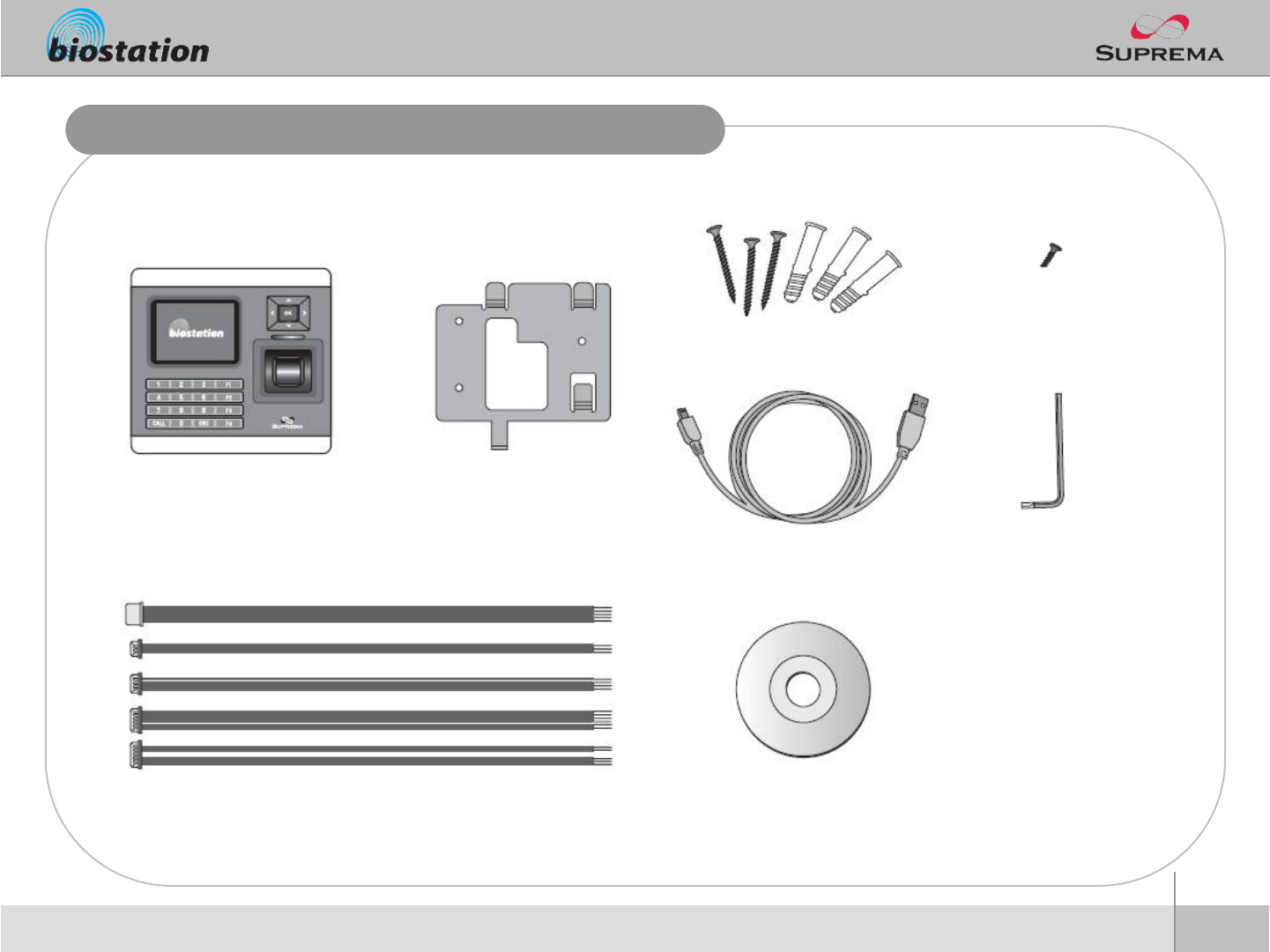
11
ⒸCopyright 2006 Suprema Inc.
Product Contents
nBasic Contents
Product Contents
BioStation fingerprint terminal Wall mounting metal bracket
USB cable
Wallmounting
screwsand holders-3 ea Star-shape screw for fixing
main body
Star-shape small wrench
5pin, 3pin, 6pin, 4pin, 7pin cable –1 ea Software CD
Before Start
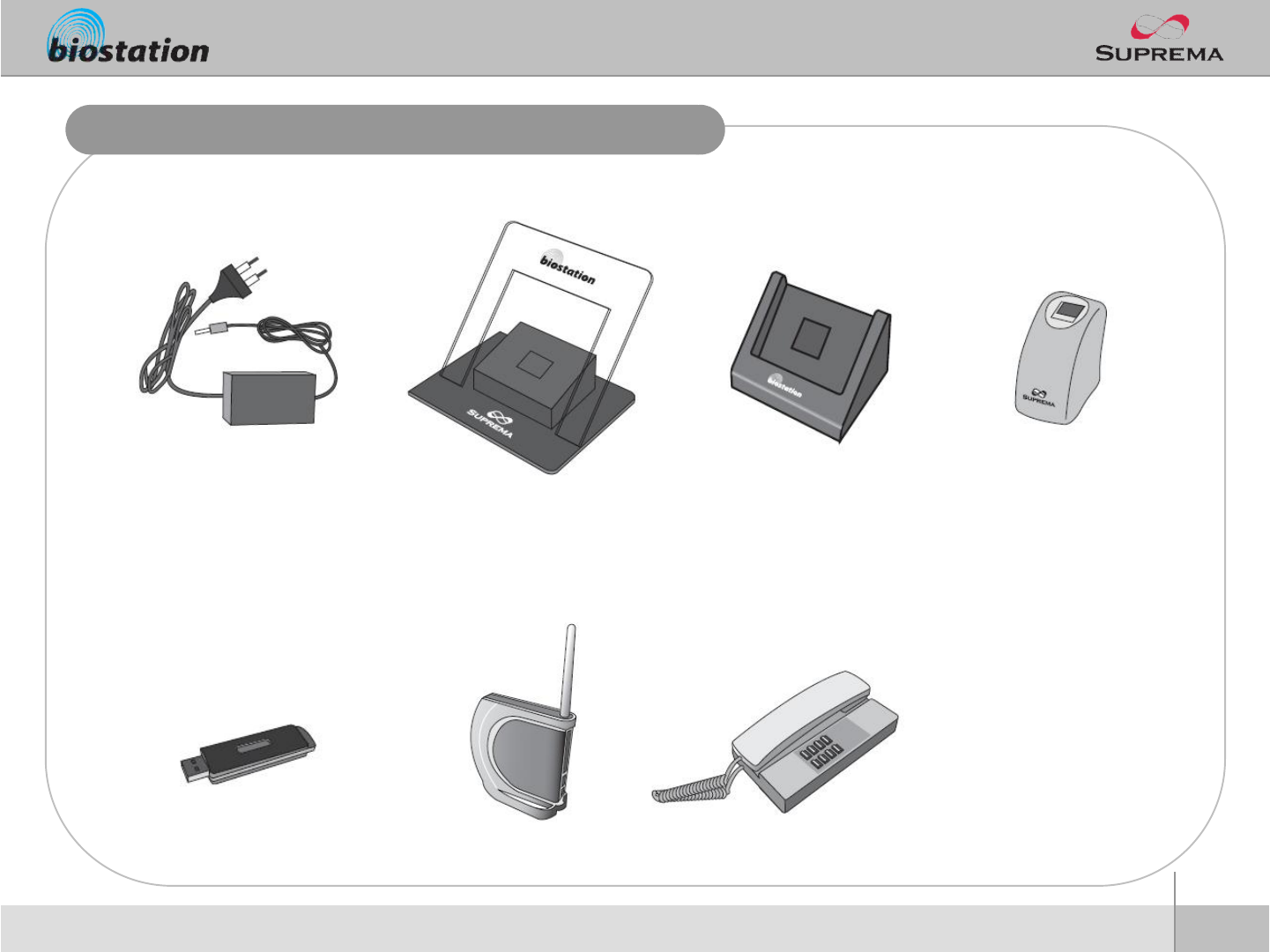
12
ⒸCopyright 2006 Suprema Inc.
Product Contents
nOptional accessories
Plastic stand type B USB fingerprint scanner
for enrollmenton PC
12V power adaptor Plastic stand type A
Before Start
InterphoneUSB memory Wireless LAN Access Point
lRecommended power supply
12V ±10%, at least 2500mA for BioStationalone installation.
Comply with standard IEC/EN 60950-1(CE Certification)
To share the power with other devices, use a power supply with higher current ratings.
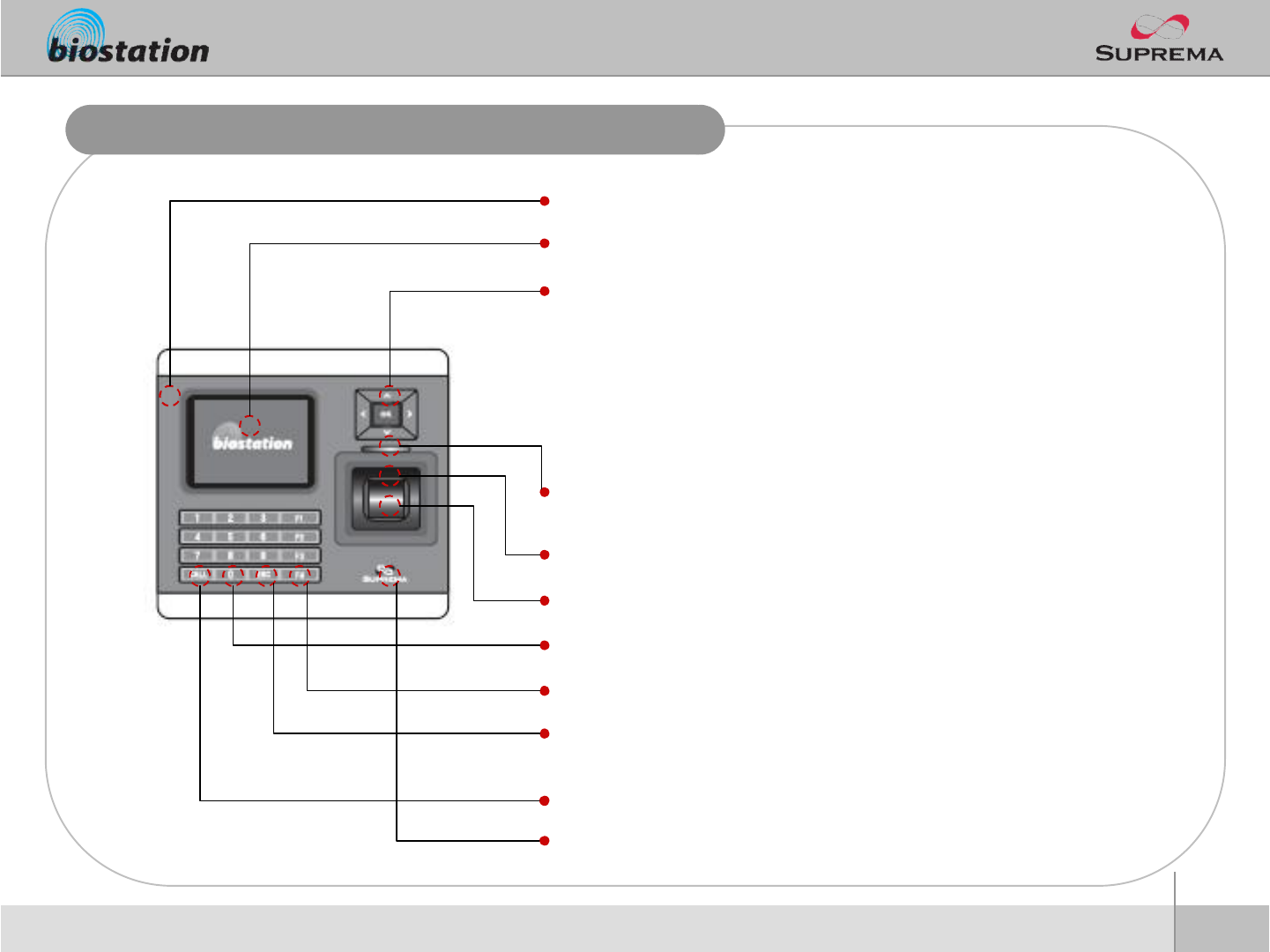
13
ⒸCopyright 2006 Suprema Inc.
Name of each part
nFront
Microphone
Used when connected to interphone.
Color LCD
Displays terminal status (T&A mode, notice, etc.) and current time.
Navigation key
▼: Move down in Admin menu or view detailed T&A function key
▲: Move up in Admin menu or hide detailed T&A function key
►: Show the next setting value in Admin menu or input a dot (.) when
entering IP address
◄: Show the previous setting value in Admin menu or delete a numeric
when entering user ID or PIN
OK : Confirm the selected setting or initiate a fingerprint scanning
manually.
LED
Blue LED is turned on with power supplied and flickers when waiting
for fingerprint scanning.
Speaker
Outputs various sound effects, music, and voices.
Fingerprint sensor
Place a finger here to scan fingerprint.
Numeric key 0~9
Used to enter user ID or PIN.
Function key
Used to input a T&A event and initiate fingerprint scanning.
ESC key
Used to enter Admin menu from initial display or return to the previous
menu from Admin menu.
CALL key
When connected to interphone, press this button to ring the interphone.
RF card reading part (RF model only)
Place RF card here to read
Before Start
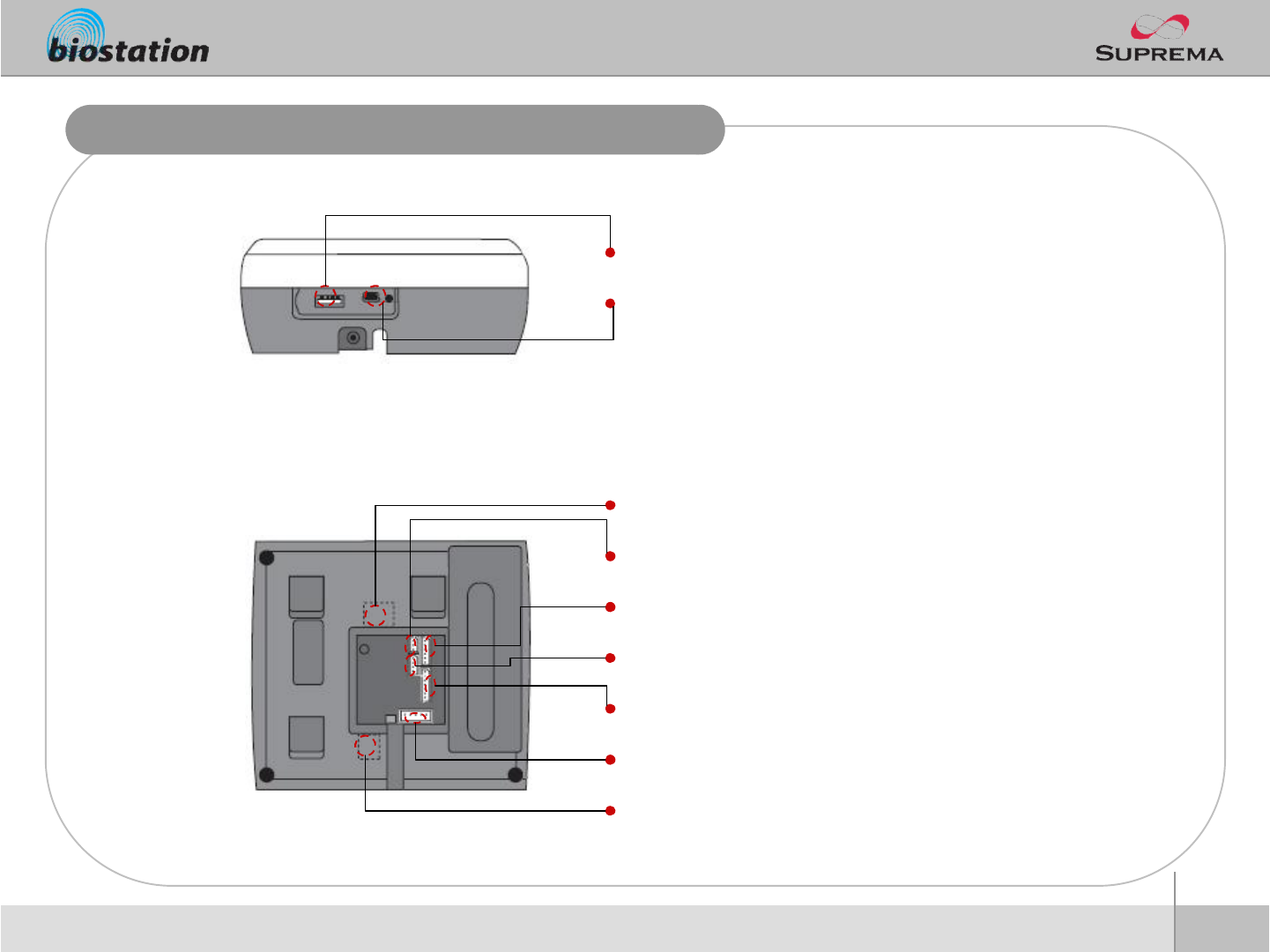
14
ⒸCopyright 2006 Suprema Inc.
Name of each part
nBottom
nRear
Slot for USB memory device : USB type A
Slot for PC USB connection : Mini USB
Ethernet cable connector : RJ45
3pin cable connector -Door
6pin cable connector –Input/Output or Wiegand
4pin cable connector -RS485
7pin cable connector -RS232 or BEACon
5pin cable connector –Power and doorphone
12V power adaptor
Before Start
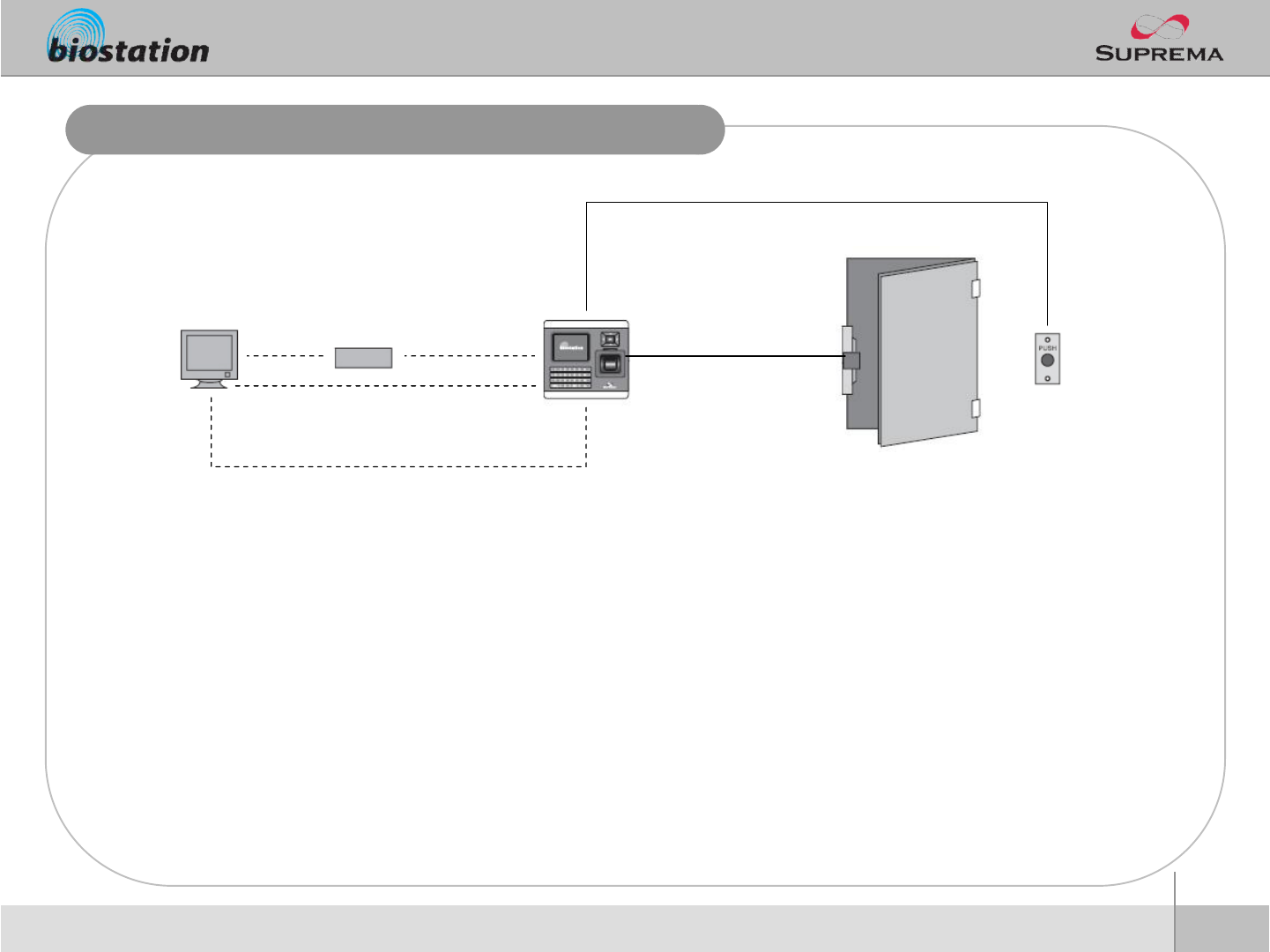
15
ⒸCopyright 2006 Suprema Inc.
Installation
nInstallation example
nRCT Battery Replace
CAUTION
RISK OF EXPLOSION IF BATTERY IS REPLACE BY AN INCORRECT TYPE.
DISPOSE OF USED BATTERIES ACCORDING TO THE INSTRUCTIONS.
Recommend Battery Type : CR2032 Type lithium Ion Battery
Exit Button
Door Lock
PC
Network hub
6pin cable
3pin cable
7pin cable
Ethernet
USBUSB
RS232
Before Start
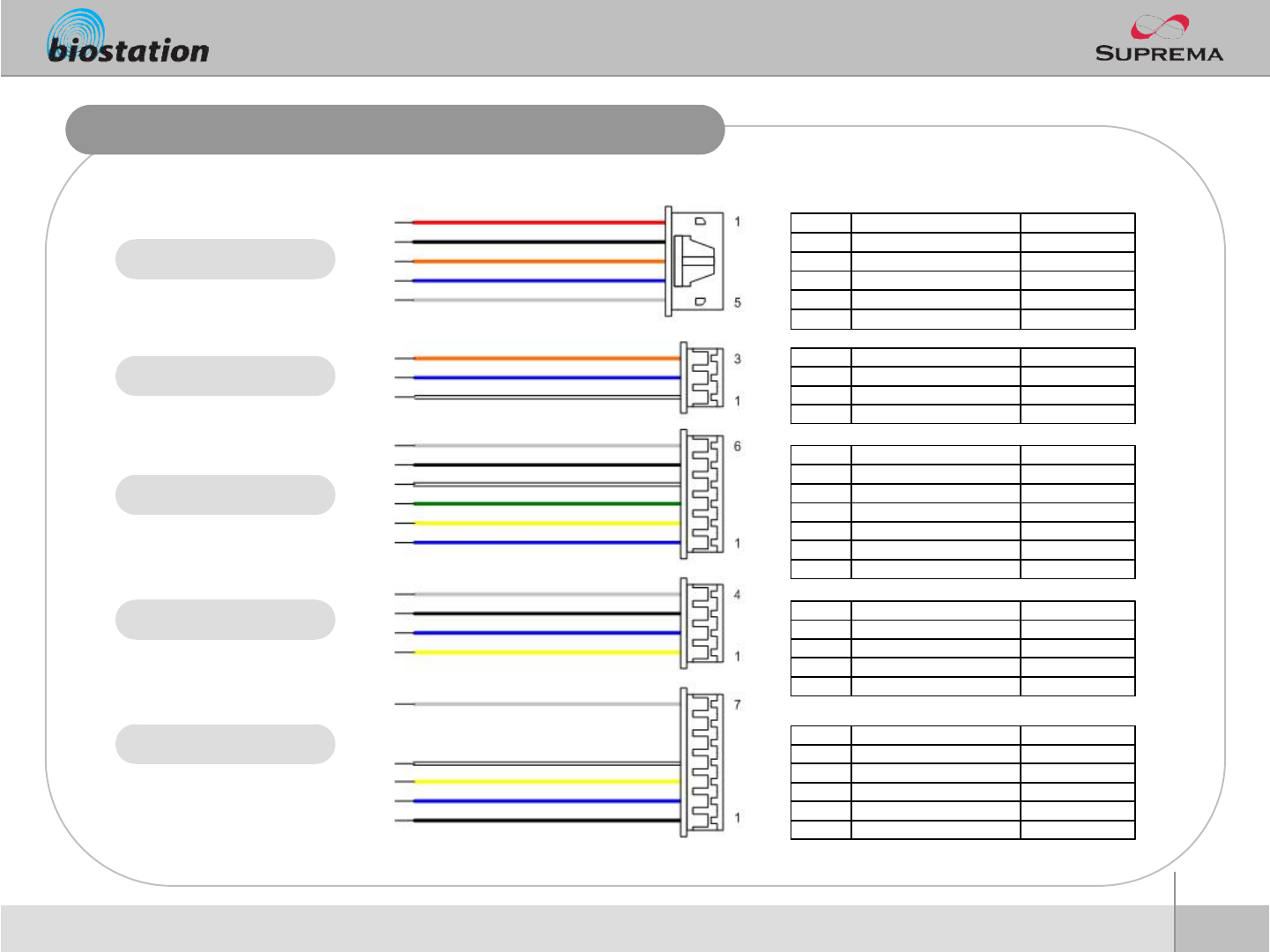
16
ⒸCopyright 2006 Suprema Inc.
Cable spec.
GRAYSHIELD GND5
BLUEDoorphoneData4
ORANGEDoorphoneAudio3
BLACKPOWER -2
REDPOWER + (12Vdc)1
WIREPIN DESCRIPTIONPIN
Power & Doorphone
Relay
TTL I/Oor Wiegand
RS485
RS232
ORANGENORMAL CLOSE3
BLUECOMMON2
WHITENORMAL OPEN1
WIREPIN DESCRIPTIONPIN
BLACKGND5
GRAYSHIELD GND6
WHITETTL OUT14
GREENTTL OUT03
YELLOWTTL IN12
BLUETTL IN01
WIREPIN DESCRIPTIONPIN
GRAYSHIELD GND4
BLACKGND3
BLUETRX +2
YELLOWTRX -1
WIREPIN DESCRIPTIONPIN
GRAYSHIELD GND7
WHITETTL OUT14
YELLOWRS-232 RX3
BLUERS-232 TX2
BLACKGND1
WIREPIN DESCRIPTIONPIN
Before Start
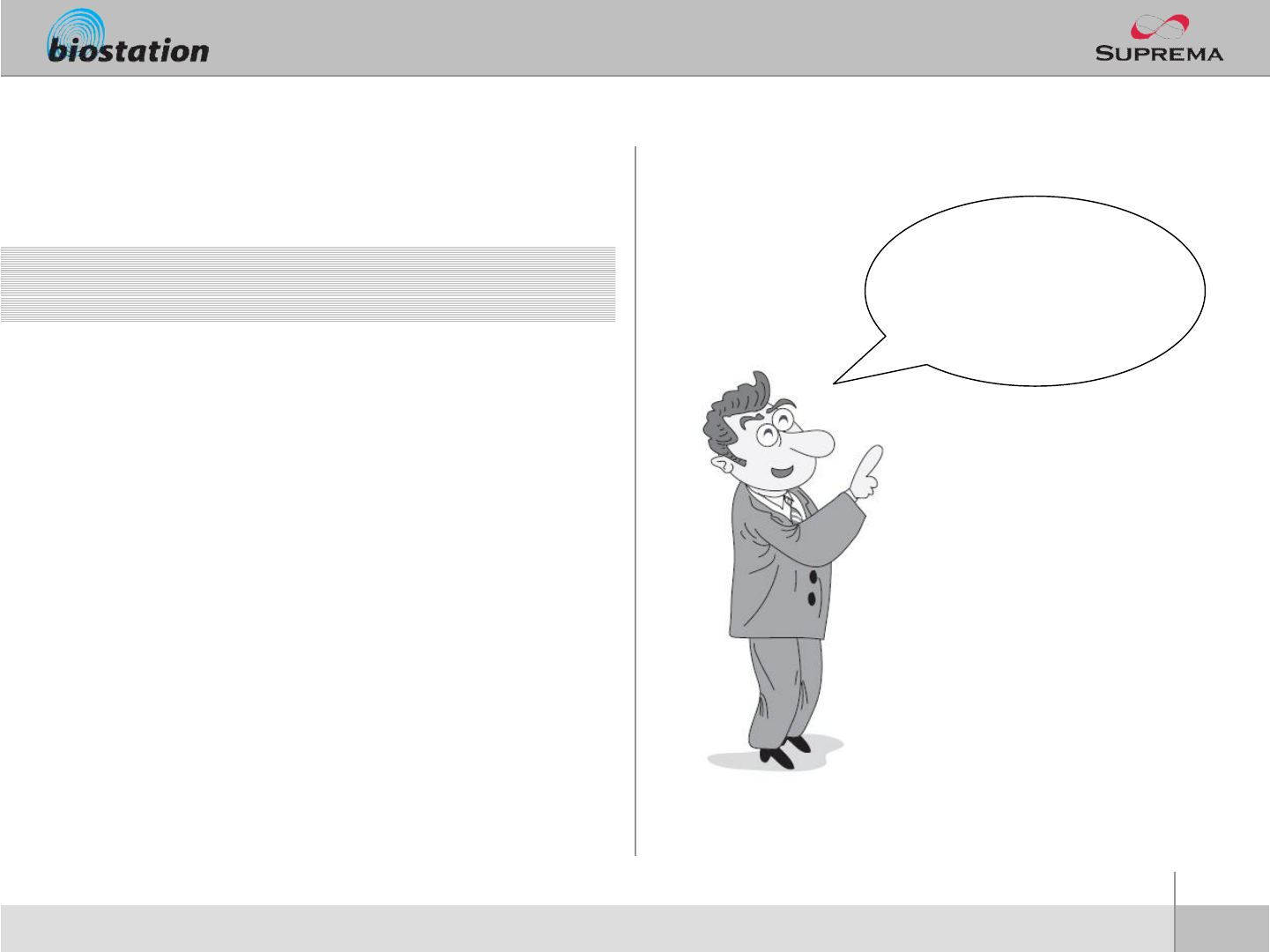
17
ⒸCopyright 2007Suprema Inc.
For Administrators -Basic Functions
Basic information for the
device administrators. It
includes key items such as
basic menu usage,
operation mode setting,
network connection, and
user management.
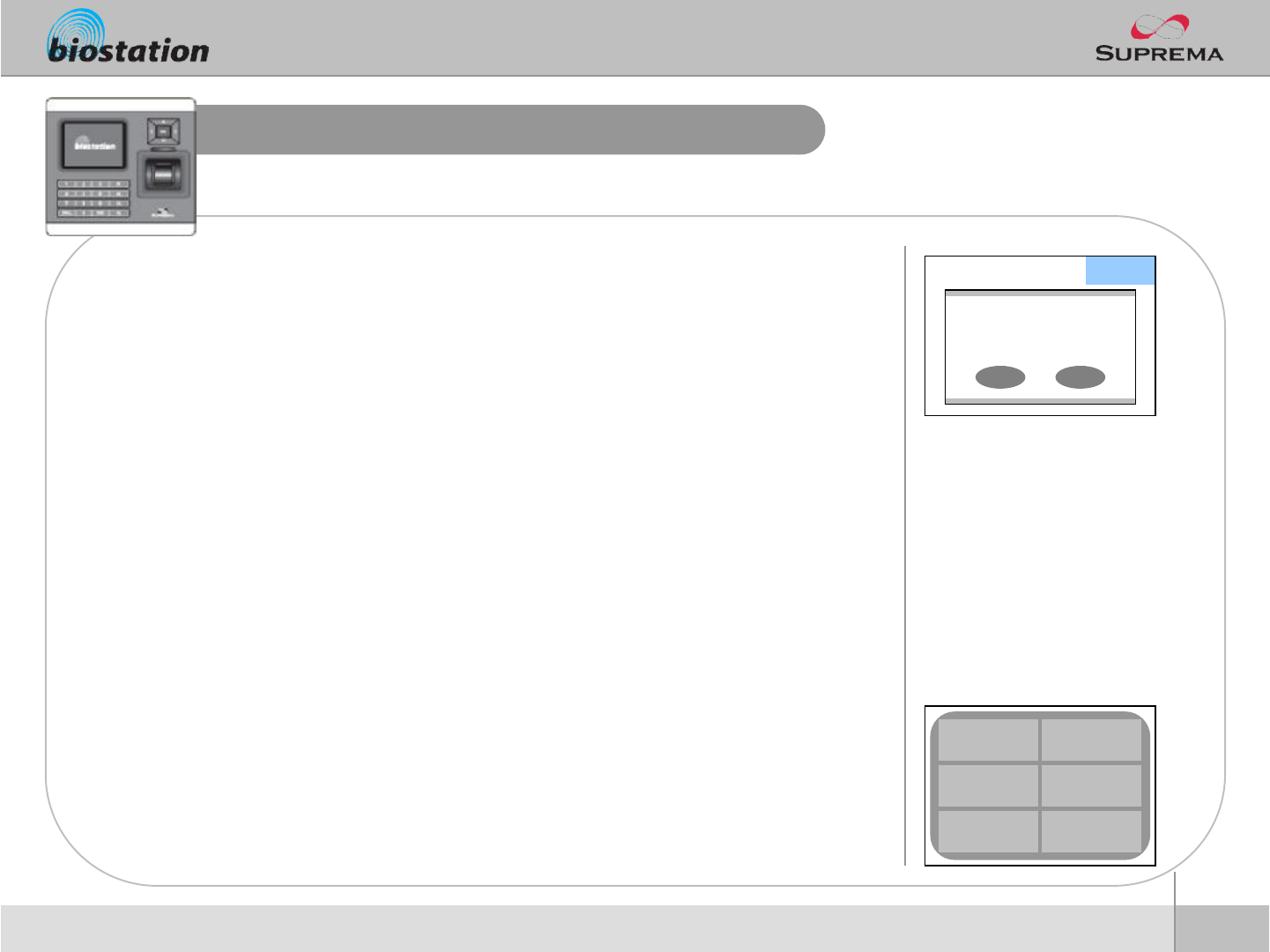
18
ⒸCopyright 2006 Suprema Inc.
Enter Admin Menu
nPress ESC key to enter Admin menu from the initial display.
nEnter master password and press OK key.
l[Note] As there’s no master password enrolled in a device by factory
default, you can enter Admin menu just by pressing OK key. For
security reason, set a master password right after the product
installation. Please refer to <Change master PW> to see how to set a
master password.
nInstead of entering master password, administrator can place
his/her finger to enter Admin menu.
l[Note] “Master password”is a unique password of the device,
different from the PIN (user password) of an administrator. It is
necessary to enter master PW or place a finger. It is not possible to
enter Admin menu by entering his/her PIN.
nIf the master password is entered successfully, initial Admin
menu appears on display.
▼T&A
Admin fingerprint or
master password
OK ESC
Device
User
Mode
Display
Log
Network
For Administrators -Basic Functions
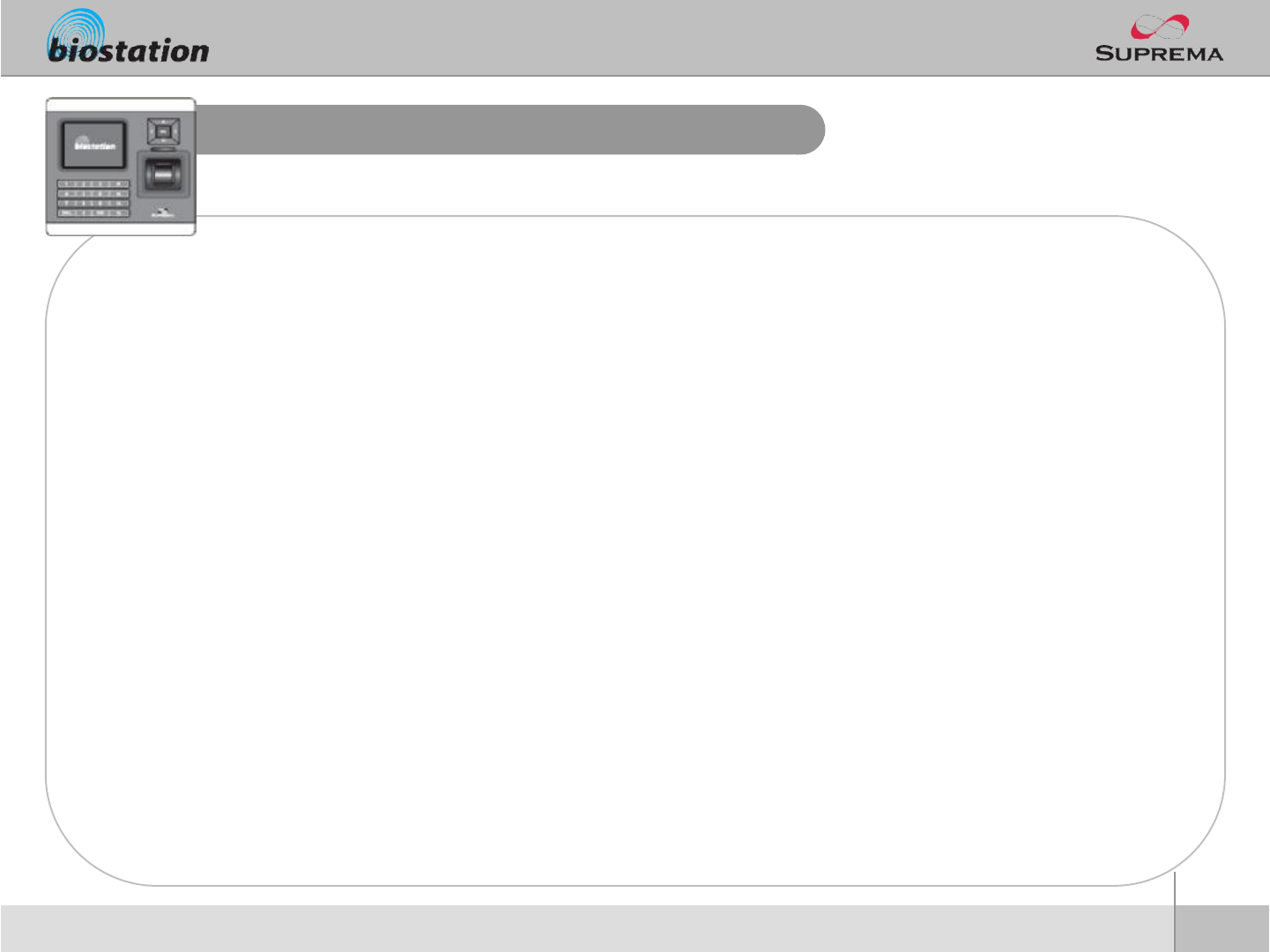
19
ⒸCopyright 2006 Suprema Inc.
Using Admin Menu
nMain functions of initial Admin menu are as follows. For the entire Admin menu list, refer to
<List of Admin menu>.
lUser : user management such as user enroll/delete/edit.
lMode : set device’s operating mode and different settings
lDisplay : set device’s language, background, sound volume, etc.
lLog : check the access and attendance event records.
lDevice: set various settings for finger scan, I/O ports, door relay, etc.
lNetwork : set interface such as TCP/IP, RS232, RS485, USB, Secure I/O, etc.
nTo enter a desired submenu from initial Admin menu, move to the desired menu using a
navigation key and press OK key.
nIn a submenu, you can move to desired item using up/down navigation key. To change
settings of each item, use left/right navigation key.
lIf you press OK key, changed setting is applied and move to the previous menu. If you press ESC
key, changed setting is not applied and move to the previous menu.
nPress F4 key anytime in Admin menu to exit from Admin menu and move to initial display.
l[Note] For security reasons, the display will automatically return to the initial display after a certain
time period without any key input in Admin menu. If you do not want this function or want to change
the time period, refer to <Display and sound setting>.
For Administrators -Basic Functions
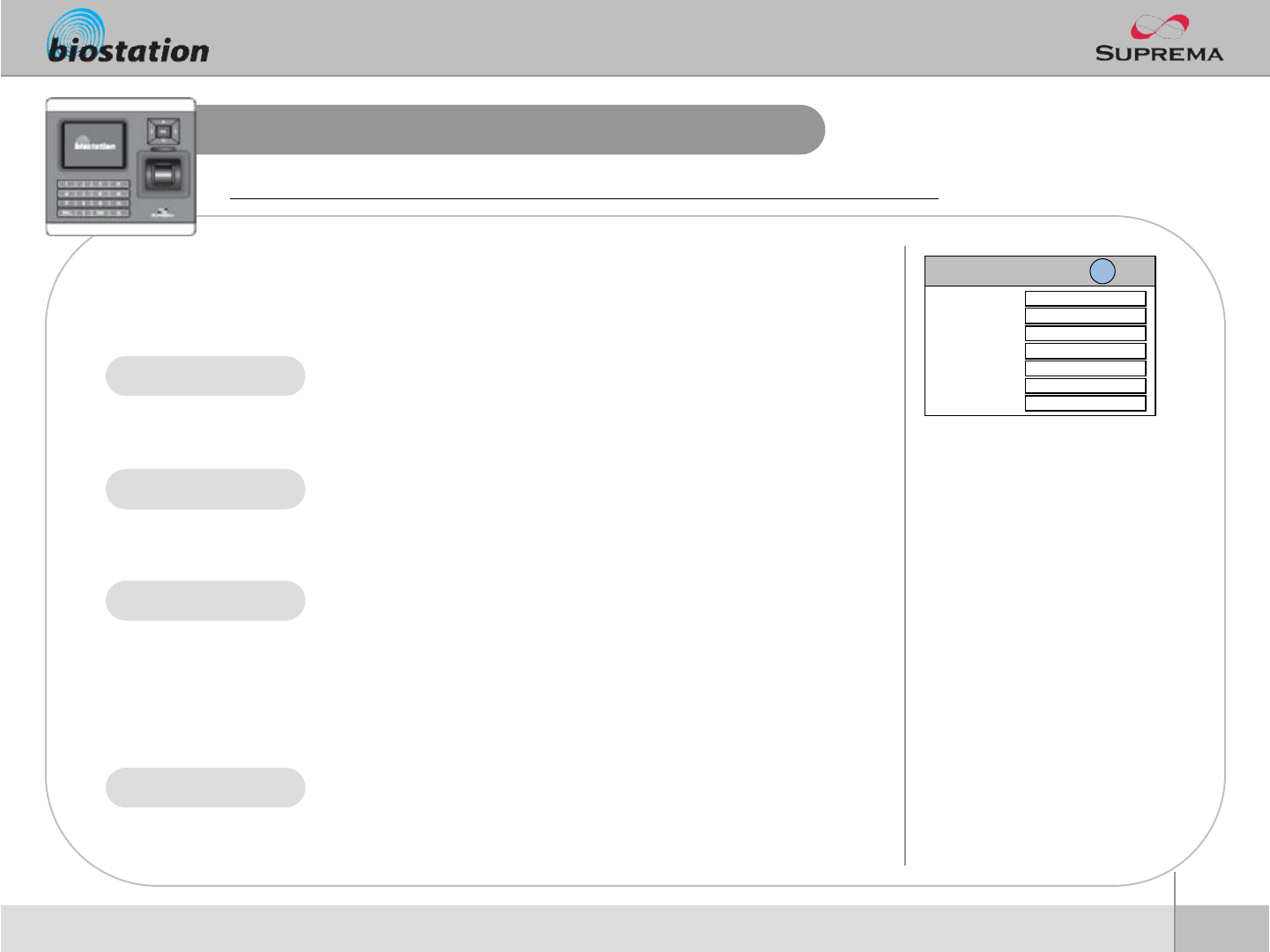
20
ⒸCopyright 2006 Suprema Inc.
Operation mode setting
nIf you select Mode on initial Admin menu, following menus
appear on the display.
After installation, it is necessary to select an operation modesuitable for its usage.
lSetting : Finger or PIN / Finger Only / Pin Only / Card Only
lAfter entering ID on 1:1 mode, set whether you will use fingerprint,
PIN, or either for authentication. In case of card, using card only
enables users to access just by placing the card.
lSet schedules to apply the above 1:1 mode.
lSelect “All Time”, “No Time”or a specific schedule set by
BioAdminprogram
lSetting: Auto / OK/T&A Key / Disabled
lAuto : Fingerprint sensor is always on standby. So, if a finger is
placed, identification starts automatically.
lOK/T&A key : After pressing OK key or T&A function key,
fingerprint sensor is turned on to scan a fingerprint.
lDisabled : 1:N identification is not used. In order to enhance the
security level of your system, you can use 1:1 mode in which users
should enter their ID first.
lSet schedules to apply the above 1:N mode
lSelect “All Time”, “No Time”or a specific schedule set by
BioAdminprogram
1:1 Mode
1:1 Time
For Administrators -Basic Functions
Mode
◀Finger or PIN ▶
1:1 Mode
1:1 Time
1:N Mode
1:N Time
Dual
Dual Time
T&A
◀All Time ▶
◀Auto ▶
◀All Time ▶
◀Not Use ▶
◀All Time ▶
◀Auto ▶
F1 More
1:N Mode
1:N Time
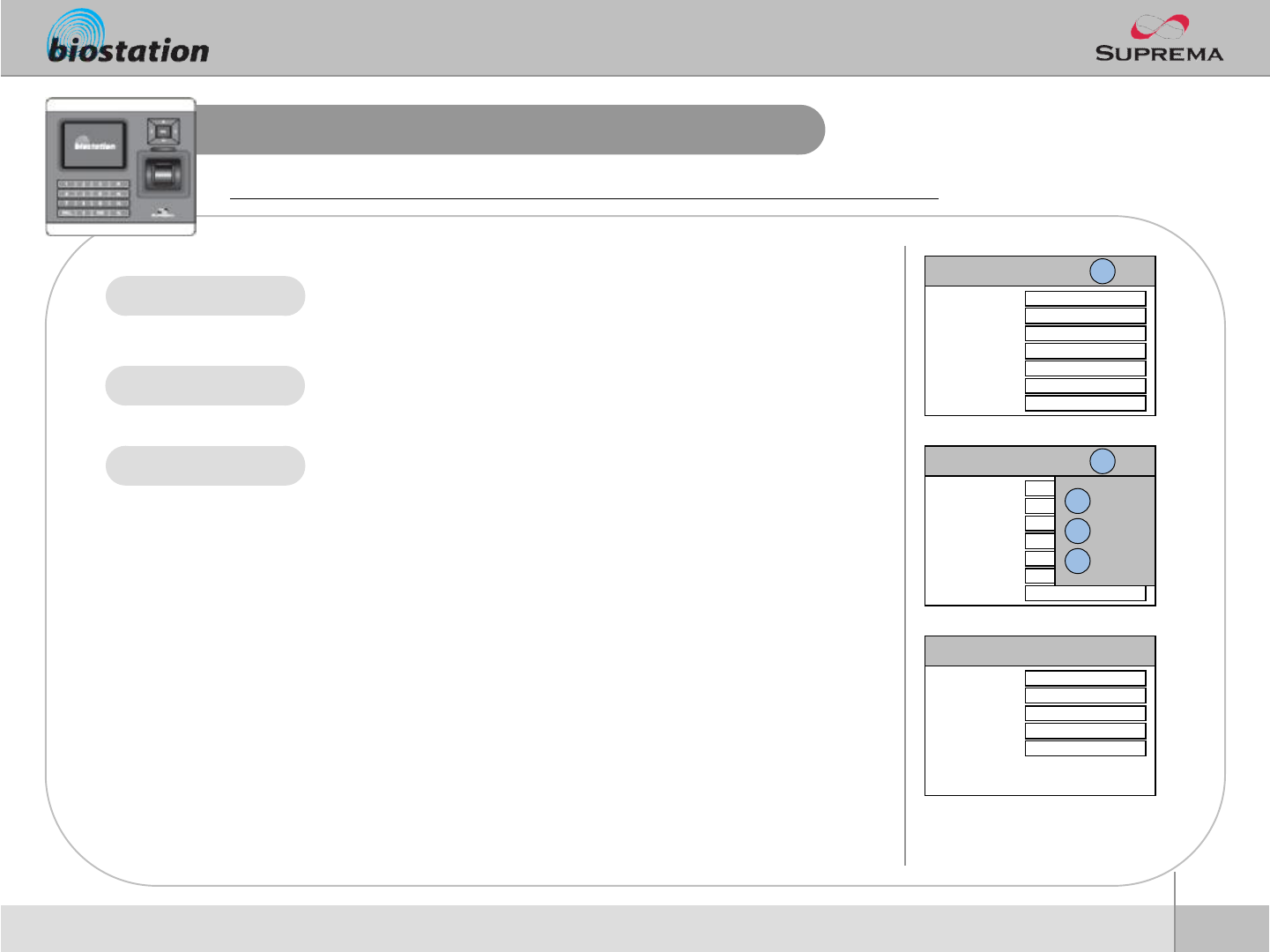
21
ⒸCopyright 2006 Suprema Inc.
Operation mode setting
After installation, it is necessary to select an operation modesuitable for its usage.
lDual Authentication needs consecutive authentications from two
different users within 15 seconds for high security
lIf only the first user is authenticated, the device signals
authentication success but does not activate a relay.
lSet scheudlesto apply the above “Dual Authentication”mode.
lSetting : Function key / Auto / Manual / Fixed
lFunction key :Press function key F1~F4 first to enter an T&A event
before authentication. Pressing ▼key on initial display, user can
enter extended T&A events.
lAuto : Apply T&A events set by time schedules
•Press F1 and F2 to change settings
•Choose a specific event by changing “T&A Key”and select a
time schedule to apply the event. (Time schedules should be
downloaded to the device using BioAdminin advance.)
lManual : Keep the T&A event of the last pressed function key. If
one press F1(IN) and authenticate, the next ones do not need to
press F1 again but still the events are recorded as F1(IN) event.
lFixed : Keep the selected T&A event (function key).
•Press F1 and F2 to change settings
•Choose a functioinkey to fix in “Fixed”menu
Dual
Dual Time
T&A
For Administrators -Basic Functions
Mode
◀Finger or PIN ▶
1:1 Mode
1:1 Time
1:N Mode
1:N Time
Dual
Dual Time
T&A
◀All Time ▶
◀Auto ▶
◀All Time ▶
◀Not Use ▶
◀All Time ▶
◀Auto ▶
F1 More
Mode
◀Finger or PIN ▶
1:1 Mode
1:1 Time
1:N Mode
1:N Time
Dual
Dual Time
T&A
◀All Time ▶
◀Auto ▶
◀All Time ▶
◀Not Use ▶
◀All Time ▶
◀Auto ▶
F1 More
OK Apply
F2 T&A
F3 Entrance
T&A
◀F1 ▶
Fixed
T&A Key
Apply Time
◀F1 ▶
◀All Time ▶
In
Door Relay
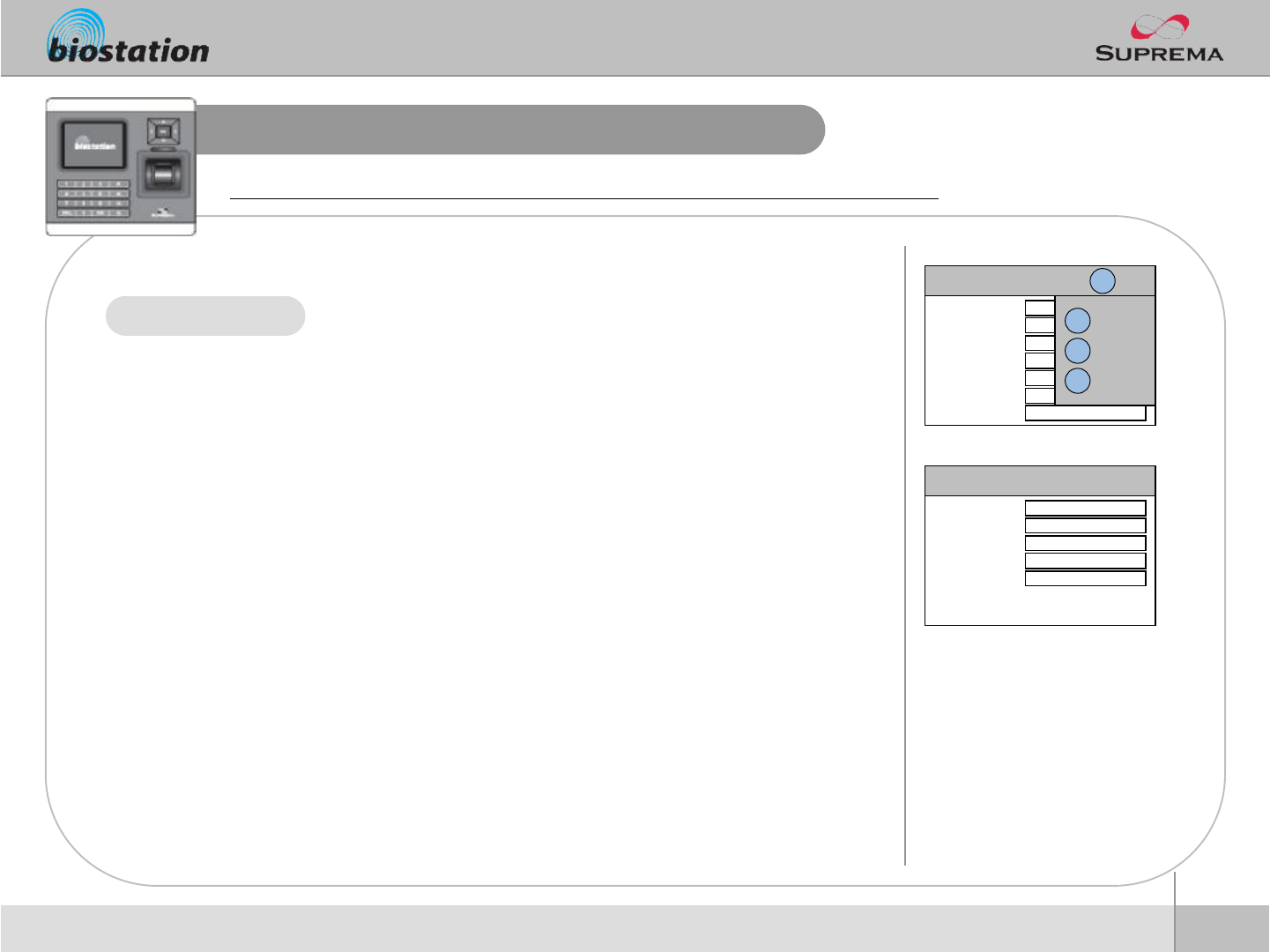
22
ⒸCopyright 2006 Suprema Inc.
Operation mode setting
After installation, it is necessary to select an operation modesuitable for its usage.
lPress F1 and F3 to enter “Entrance Limit”window
lInterval : Time period for re-authentication (min)
lTime Index : Select 4 different time periods per day
•Time : Set time period
•Count : Set max number of entrance during the period
lDefault : Set default entrance mode for users who are not
assigned a specific access group.
Entrance Limit
For Administrators -Basic Functions
Mode
◀Finger or PIN ▶
1:1 Mode
1:1 Time
1:N Mode
1:N Time
Dual
Dual Time
T&A
◀All Time ▶
◀Auto ▶
◀All Time ▶
◀Not Use ▶
◀All Time ▶
◀Auto ▶
F1 More
OK Apply
F2 T&A
F3 Entrance
Entrance Limit
0
Interval
TimeIndex
Time
Count
Default Group
◀0 ▶
00:00 ~ 00:00
0
◀Full Access ▶
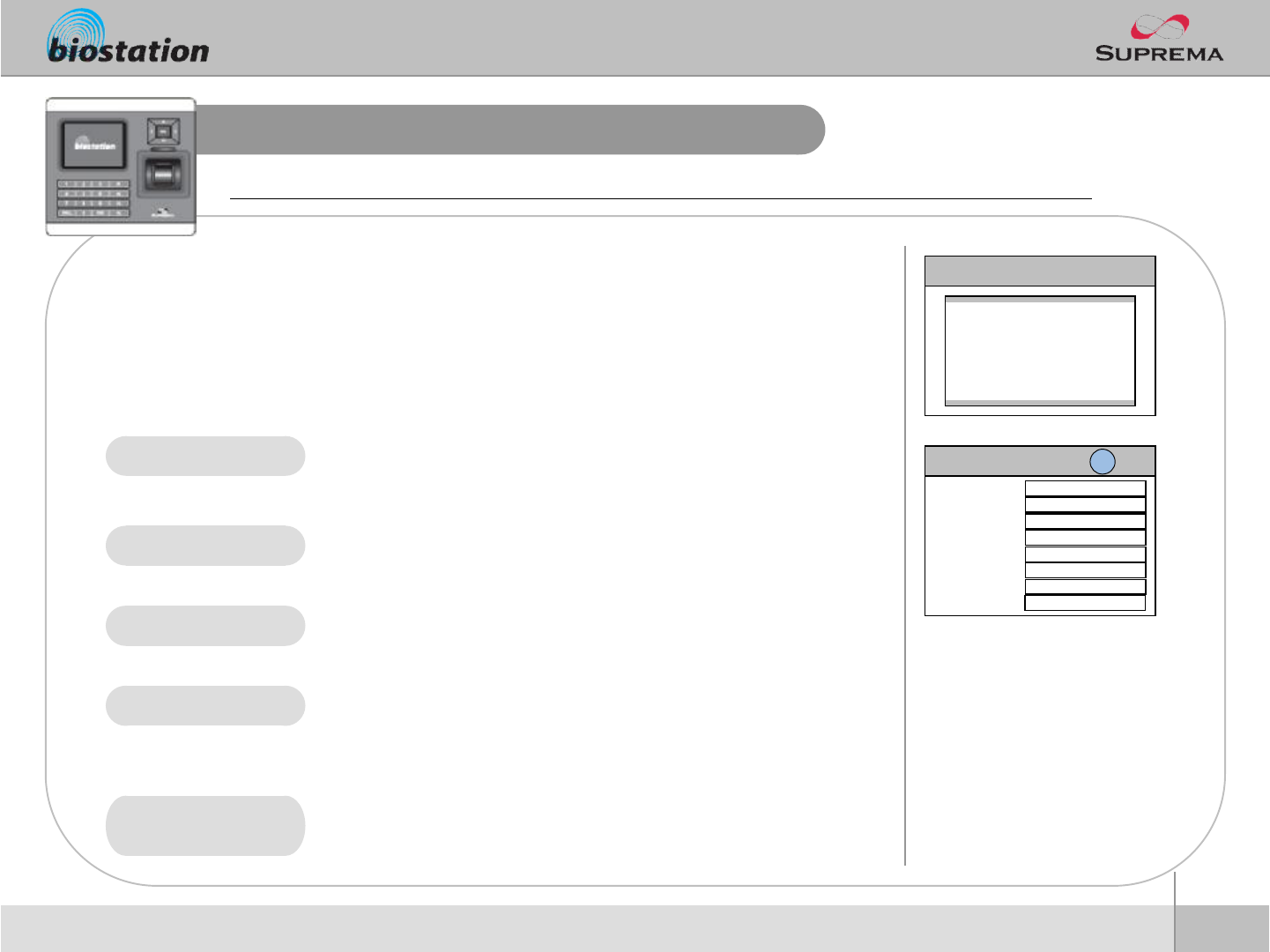
23
ⒸCopyright 2006 Suprema Inc.
TCP/IP
nIf you select Network on initial Admin menu, Network Setup
menus appear on the display.
nIf you select TCP/IP on network menu, following menus appear
on the display.
To use the device connected to PC, you need to set up the network according to your connection type.
Network Setup
USB Memory
TCP/IP
Serial
USB
LAN Type
lSetting : Disable/Ethernet/Wireless LAN (Optional)
lUsed when connected to PC via Ethernet using RJ45 connector on
the rear of the device.
lSetting : 1/4/8/16
lMax number of BioAdminclients that can access the device at the
same time.
lSetting : Use/not use.
lIt sets Use or Not Use of SSL between the BioAdmin and BioStation.
lSetting : Use/not use
lUsing DHCP, you can receive IP address and other necessary
setting from server automatically.
lCheck whether an appropriate DHCP server is available in your
network environment before use.
lWithout using DHCP, IP address, gateway, and subnet need to be
entered manually. Inquire necessary settings to network
administrator.
Max conn
DHCP
IP Address, gateway,
subnet
For Administrators -Basic Functions
SSL
TCP/IP
◁Ethernet ▷
LAN Type
Port
Max Conn.
SSL
DHCP
IP Address
Gateway
Subnet
1470
◀1 ▶
◀Not Use ▶
◀Use ▶
F1 More
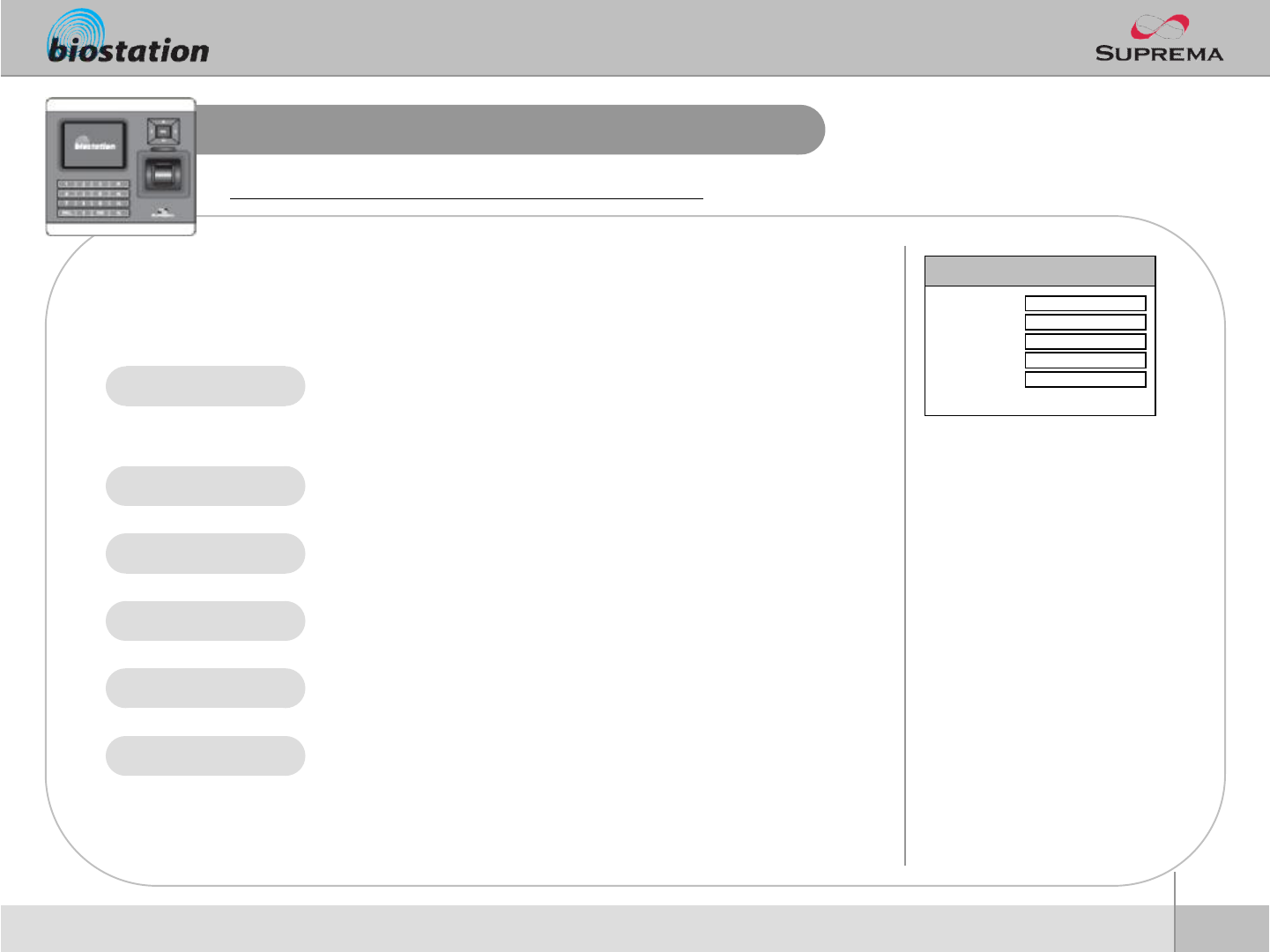
24
ⒸCopyright 2006 Suprema Inc.
Wireless LAN
nIf you press F2 key on TCP/IP menu, following menus appear on
the display.
To set up the wireless LAN, select the wireless LAN AP.
Preset
lSelect a wireless LAN AP among the preset AP devices.
lIf there is no preset wireless LAN AP, add the wireless LAN AP
using BioAdmin program on PC. You can add up to 4 wireless LAN
AP.
lShows the operation mode of the wireless LAN AP.
lShows the ESSID of the wireless LAN AP.
lShows the authentication mode of wireless LAN AP.
lShows the encryption method of the wireless LAN AP.
lShows the network condition of the currently used wireless LAN AP.
Mode
Authentication
For Administrators -Basic Functions
Wireless LAN
◁WPA ▷
Preset
Mode
ESSID
Authentication
Encryption
Link Quality
Infrastructure
BioStation_wep
Open
WEP64/128/256
0%
ESSID
Encryption
Link Quality
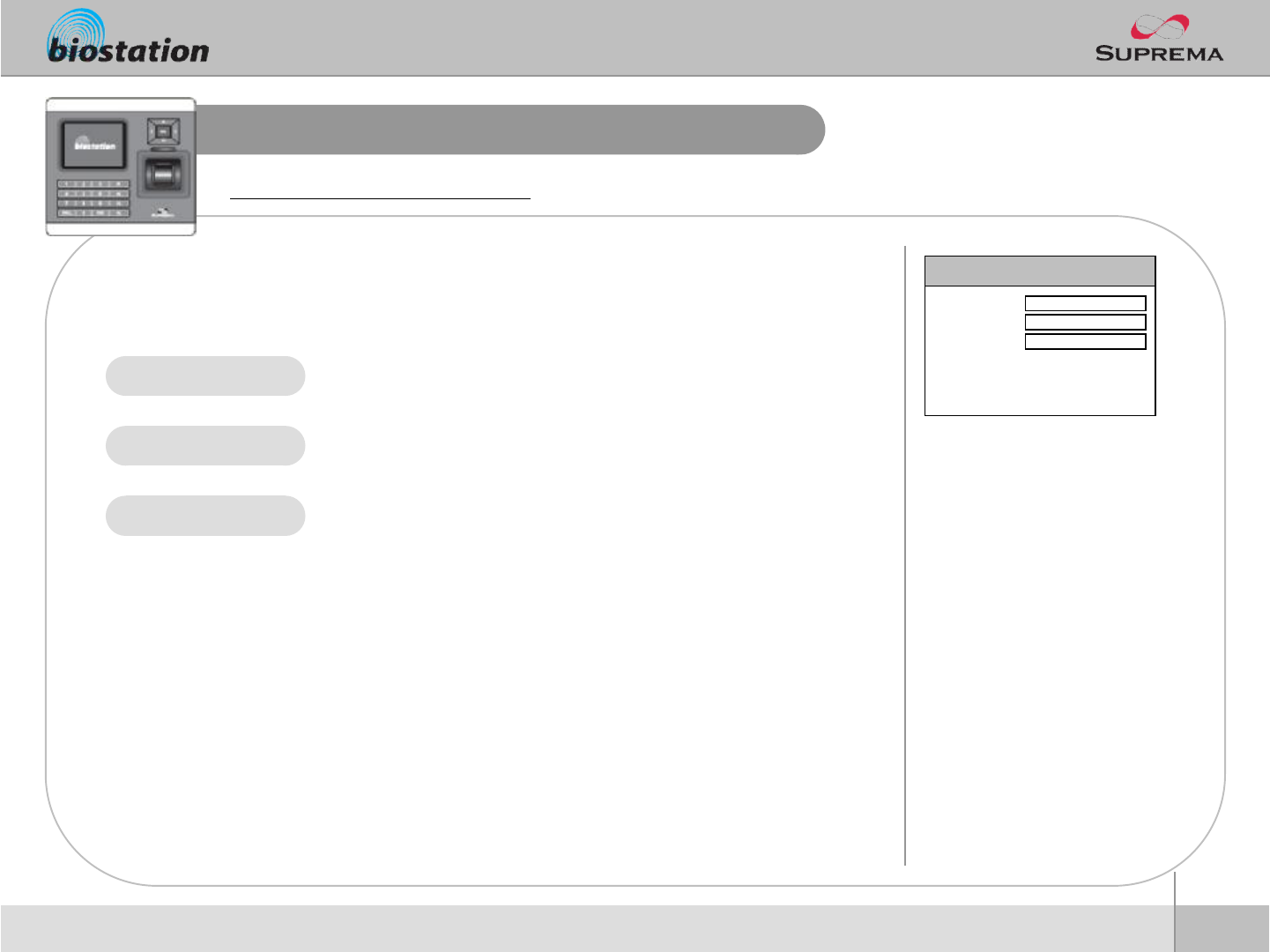
25
ⒸCopyright 2006 Suprema Inc.
Server
nIf you press F3key on Server menu, following menus appear on
the display.
To set up the network to the Server.
Server lSet Use or Not use of server.
lSet Server IP
lSet Server port
Server IP
For Administrators -Basic Functions
Server
◁Not Use ▷
Server
Server IP
Port
Port
lSet SSL Mode as “Not Use”and Server mode to “Use”(Put server IP and Port
information) if sever access is executed for the first time and another server DB rather than
previously is accessed.
lAfter the previous process, BioStation with unauthorized certificate in BioAdmin client
program will be shown and issuing certificate is needed.
lAfter issuing certificate, system will be rebooted and accessed to server automatically.
lAfter rebooting, SSL mode will be automatically change to “USE”,
lAfter issuing certificate, SSL Mode and server mode will be set to “USE”and there is no
need to set up configurations of server and BioStation.
lTo access BioStation from BioAdminClient directly without accessing to server, SSL and
server mode are set on “Not Use”
lFor more information on server setup, please refer to BioAdmin manual.
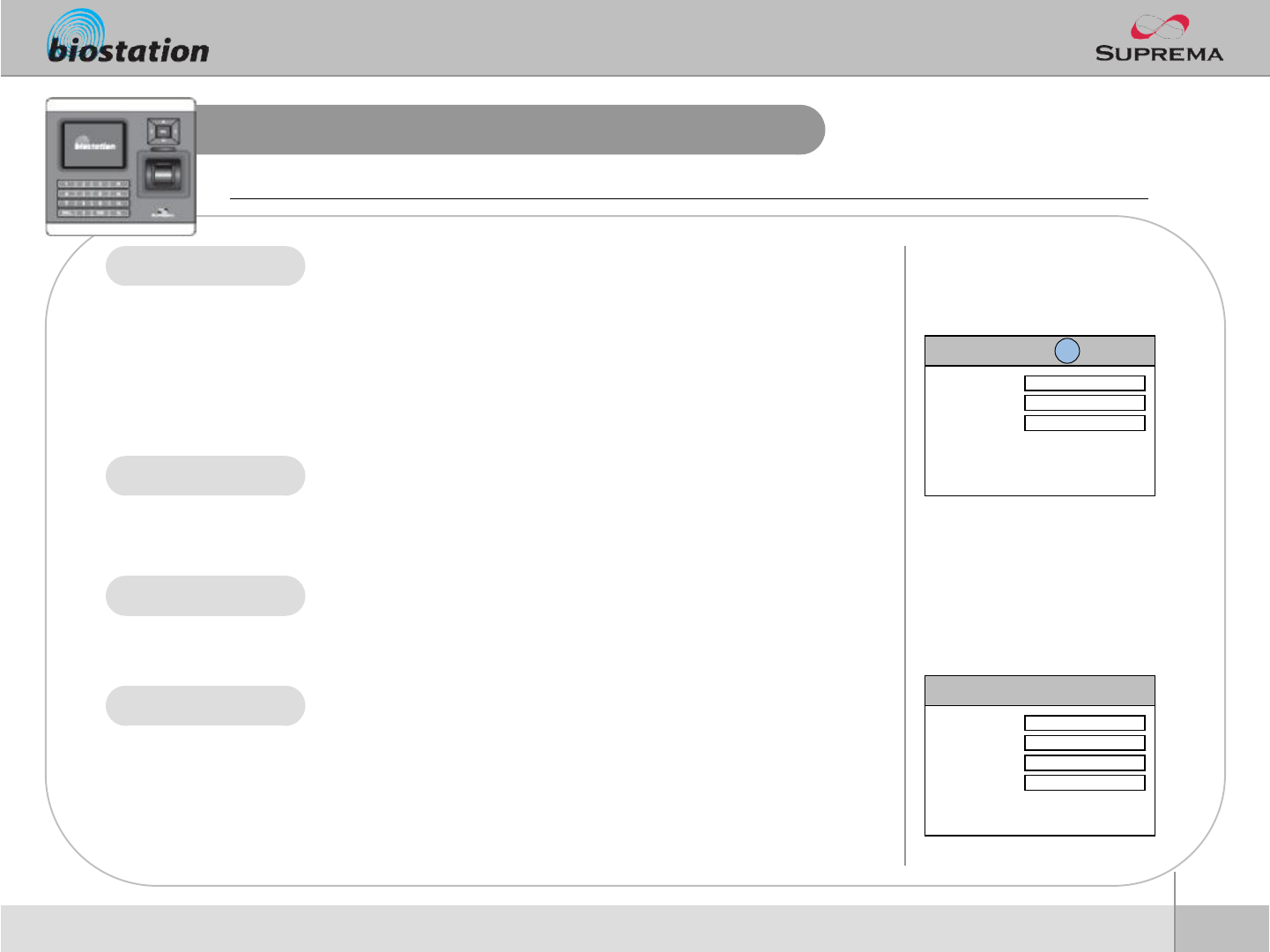
26
ⒸCopyright 2006 Suprema Inc.
Serial
RS485 lSetting :Disable/9600/19200/38400/57600/115200
lUsed when connecting to the serial port of PC using 7pin
connector on the rear of the device.
lIn the serial communication, the speed represents the frequency of
carrier wave’s changing status per sec, called baudrate.
lDefault is 115200 bps.
lIf you have communication error in serial communication, settinga
lower baudrate may solve the problem.
lPC Connect : Use RS485 to communicate with PC host
lSecure I/O : Use RS485 for internal communication between door
access devices like BioStation and Secure I/O for secure relay or
anti-passback
lSetting : Disabled/9600/19200/38400/57600/115200
lUsed when connecting to the serial port of PC using 4pin
connector on the rear of the device.
lPress F1 to enter Secure I/O setting
lValid only when “RS485Mode”is selected as “Secure I/O”.
•Node Type : Host / Slave (Check whether the device is a
host in the RS485 loop.)
•Slave ID : Enter ID of slave device (BioStation or BioEntry
Plus) in the same RS485 loop
•SecureIOID : Enter ID of the connected Secure I/O (0 ~ 3)
and set “Use”in the below menu
Serial
◀115200 ▶
RS485
RS485MODE
RS232
For Administrators -Basic Functions
◀Secure I/O ▶
RS232
To connect BioStation to the serial port of PC, you need to select the buadrate of the serial communication.
F1 Secure I/O
◀115200 ▶
Secure I/O
◀Host ▶
Node Type
Slave ID
SecureIO ID
SecureIO Use
0
◀0 ▶
◀Not Use ▶
RS485Mode
Secure I/O
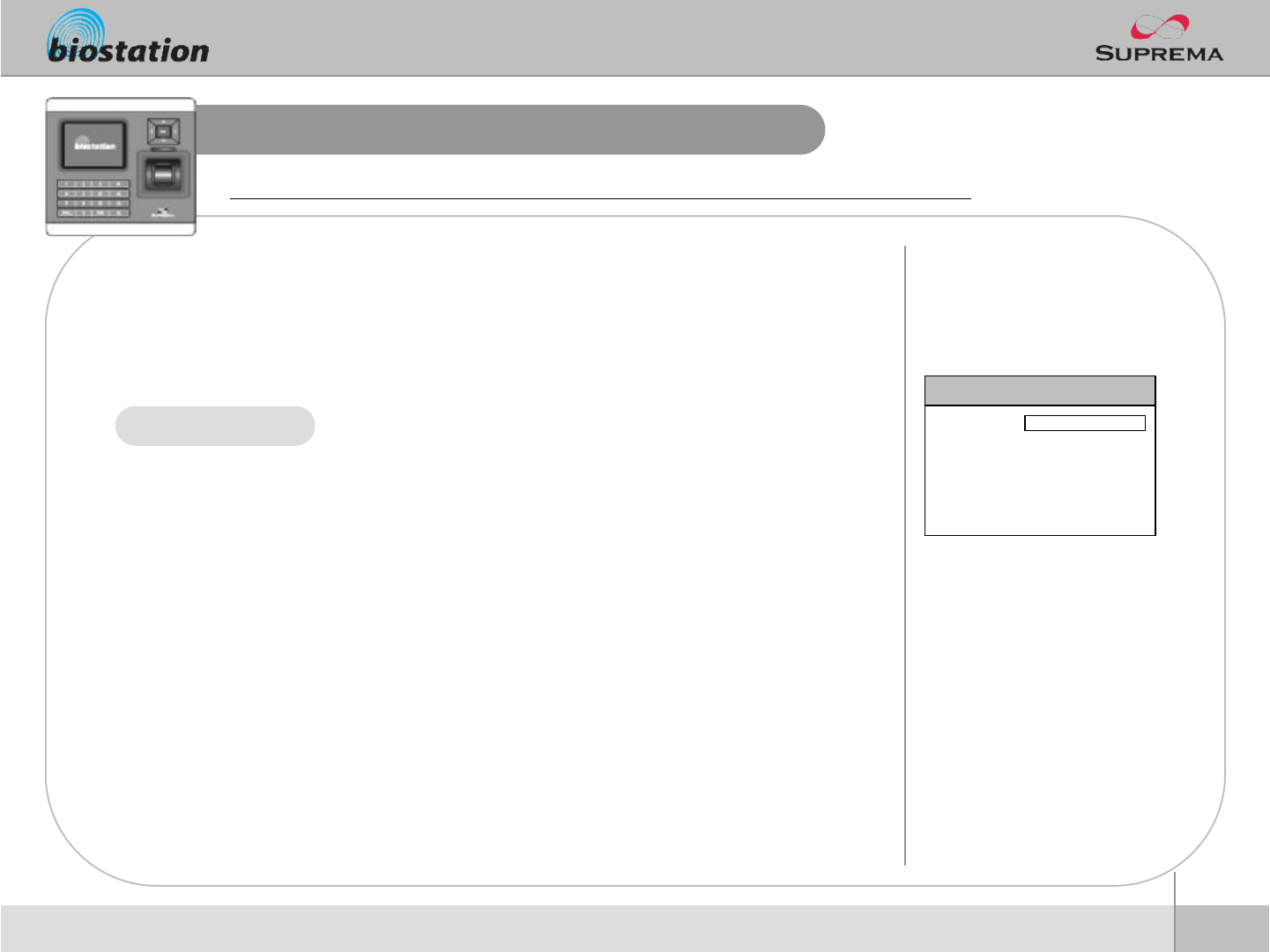
27
ⒸCopyright 2006 Suprema Inc.
USB
nIf you select USB on network submenu, USB setting menu
appears on the display.
USB lSetting : Enable/Disable
lUsed to connect the mini USB port on the bottom of the device to
the USB port of PC.
l[Note] For security reasons, USB is set as Disable by the factory
default. When you connect device to PC using USB, the setting
should be changed to Enable in advance.
USB
◁Disable ▷
USB Port
For Administrators -Basic Functions
To connect the BioStation to the USB port of host PC, enable theUSB communication.
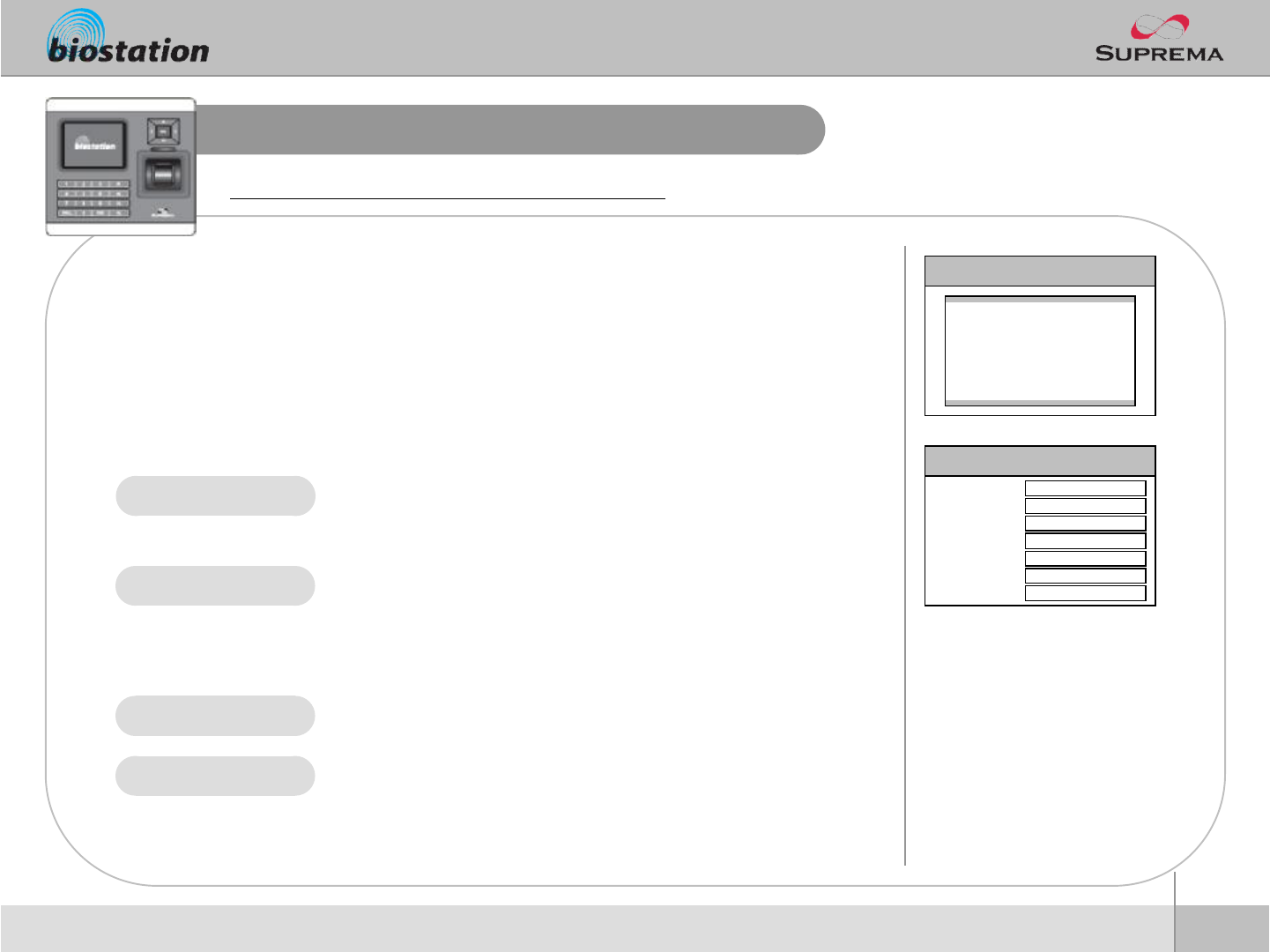
28
ⒸCopyright 2006 Suprema Inc.
Enroll New User
nIf you select User on initial Admin menu, User Management
menus appear on the display.
nIf you select Enroll User on user menu, following menus appear
on the display.
How to enroll the user information and fingerprint.
User Management
Enroll User
Edit User
Delete All Users
Check User DB
Enroll User
123456
User ID
Admin Level
Password
Group 1
Group 2
Group 3
Group 4
◀Normal ▶
◀None ▶
◀None ▶
◀None ▶
◀None ▶
User ID
lBy default, the lowest available ID is displayed on the ID part of the
menu. Enter your desired ID.
lUser ID can be set between 1 and 4,294,967,295.
lSetting : Normal/Admin
lDecide user level as normal user or administrator.
lAdministrator is authorized to manage user info, ie. enroll user,
delete user, and change various settings of the device.
lIt is recommended to enroll at least 1 or 2 users as administrator.
lEnter password used in 1:1 mode. If you want to use fingerprint only,
leave password as blank.
lSelect access group in which the user belongs to. To edit access
group, use BioAdmin program on PC. Default access group can be
set as “Full Access”or “No Access”for whom without a specific
access group assigned.
Admin Level
Password
Group 1 ~ Group 4
For Administrators -Basic Functions
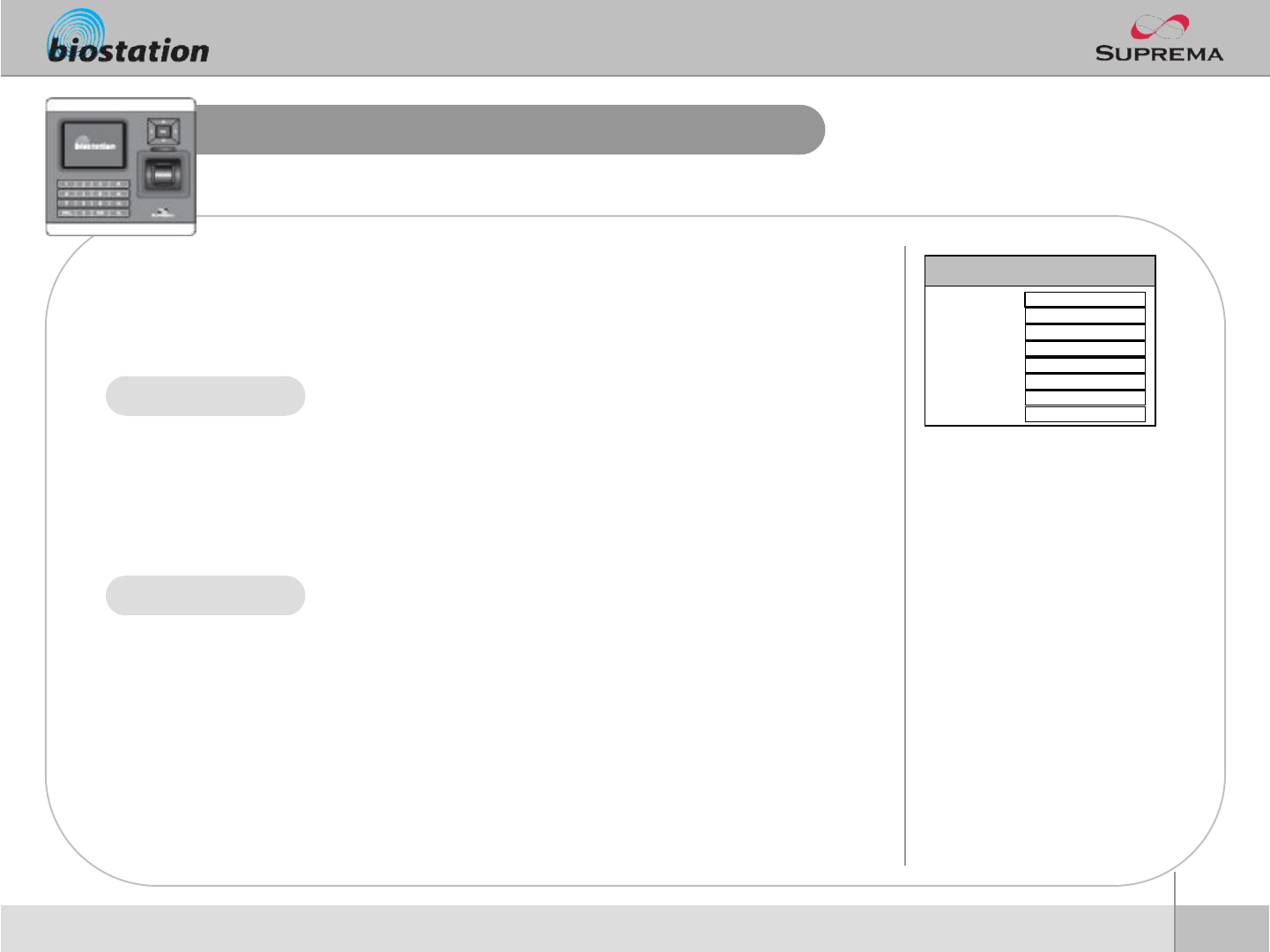
29
ⒸCopyright 2006 Suprema Inc.
Enroll New User
nIf you enter all the necessary items for enrollment and press OK
key, the following fingerprint menus appear on the display.
Finger No lSetting : 1/…/5/None
l1-5 fingers can be enrolled for each ID.
lEnrolling more than two fingers per user can be useful in a caseof
injury of a finger.
lFor a user whose fingerprint is weak or worn-out, enrolling the same
finger twice or more can reduce failure rate.
lIf you want to use PIN only instead of fingerprint, select None.
lSetting : None/Last Finger
lDuress is of vital importance in a situation when user is threatened
to open a door by an intruder. If a duress finger is entered, a door
opens normally but the device can send a duress signal to ring an
emergency call or alarm.
lIf you select Last Finger on the duress menu, the last fingerprint
enrolled is assigned as a duress finger. For example, if you enroll
three fingers and select Last Finger for duress, the first and second
fingers are enrolled as normal fingers and the third finger as a
duress finger.
lTo use duress finger, more than two fingerprints should be enrolled,
ie., Finger No. should be more than 2.
lDuress finger should be different from normal finger enrolled in
advance.
Duress
For Administrators -Basic Functions
Enroll Finger
◁None ▶Finger No
Duress
Daily Limit
Time Limit
Card
Bypass Card
Input Type
Card ID
◀None ▶
0
0
◀Wiegand ▶
◀Use ▶
◀Read Card ID▶
Card ID display change (from V1.3)
Since firmware V1.3, card ID display type
has been changed. So, cards registered
before V1.3 may show a different ID
display. But it doesn’t affect card
authenication.
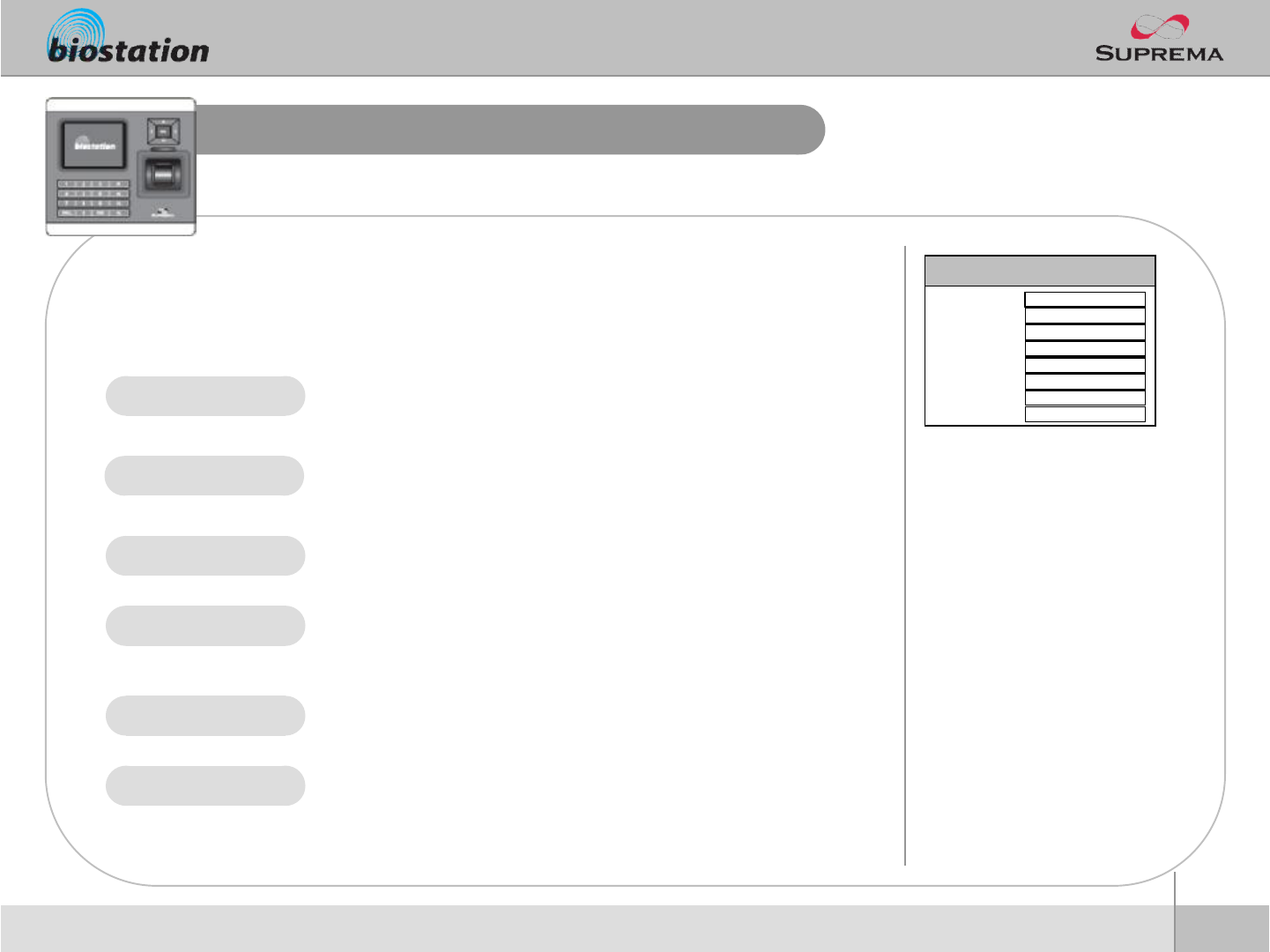
30
ⒸCopyright 2006 Suprema Inc.
Enroll New User
nIf you enter all the necessary items for enrollment and press OK
key, the following fingerprint menus appear on the display.
Daily Limit lIt sets the limit to the number of access for a user in a day.
If this is set as 0, user can access many times without limit.
lIt sets the minimum interval between the accesses of a user.
If it is set as 0, there will be no minimum interval between the
accesses for that user.
lSetting : Not Use/RF Card/Wiegand
lIt sets Use or Not use of card and the type of card.
lSetting : Use/Not Use
lIt sets authentication with card only, not with any additional
procedure.
lSetting : Direct Input/Use ID/Read Card ID.
lIt sets Card ID Input type.
lIn case of Manual Input, users enter card ID directly. In case of User
ID, users set card ID as user ID. In case of Read Card ID, it will be
read from card.
Time Limit
For Administrators -Basic Functions
Enroll Finger
◁None ▶Finger No
Duress
Daily Limit
Time Limit
Card
Bypass Card
Input Type
Card ID
◀None ▶
0
0
◀Wiegand ▶
◀Use ▶
◀Read Card ID▶
Card
Bypass Card
Input Type
Card ID
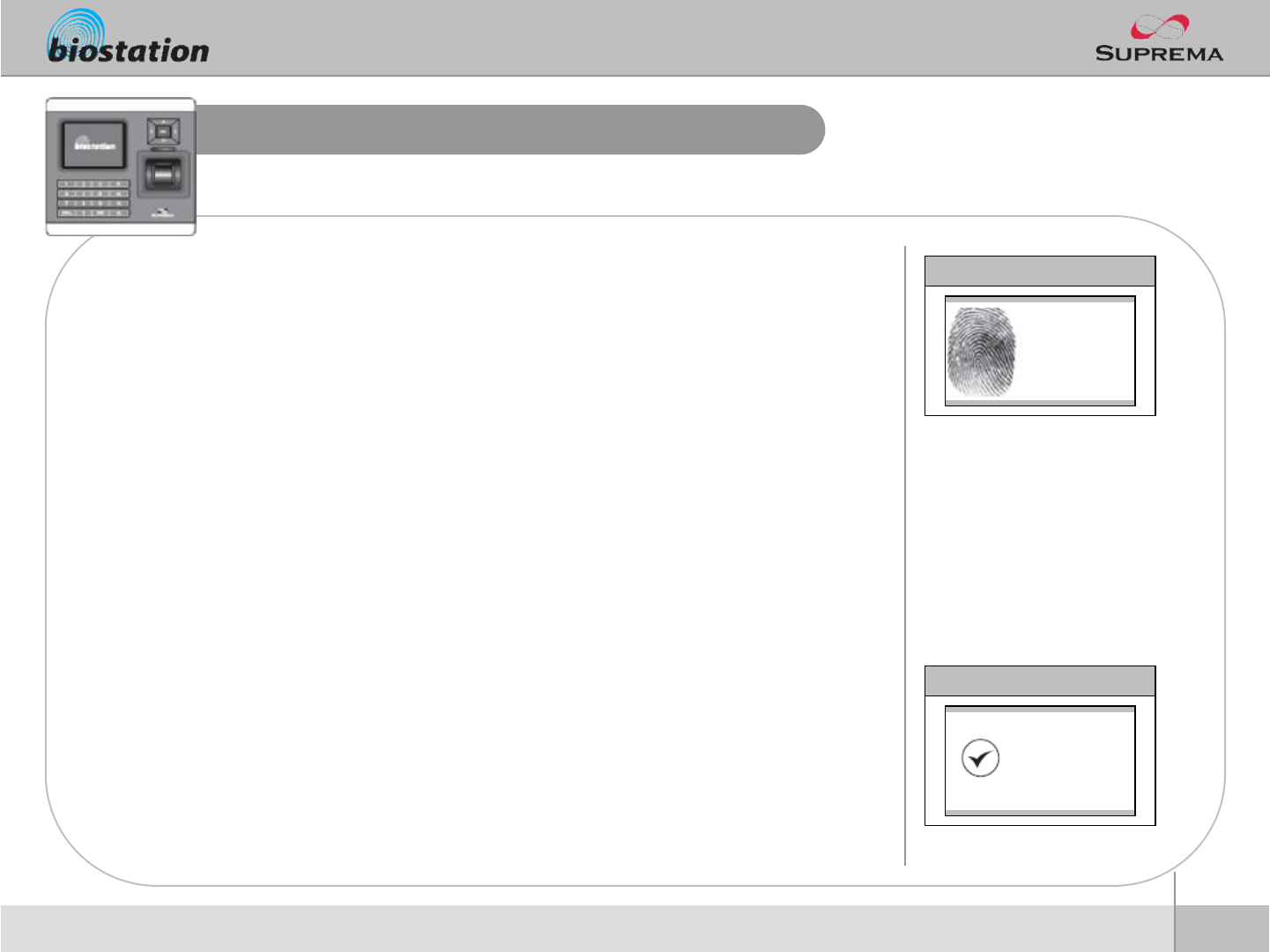
31
ⒸCopyright 2006 Suprema Inc.
Enroll New User
nAfter selecting Finger No. and Duress and pressing OK, now
you should place a finger on a sensor for enrollment.
lFor enrollment, the same finger should be placed twice accordingto the
messages shown in the display.
lIf Finger No. is set more than 2, the device asks for the scan of the next
fingerprint continously.
lAfter placing a finger on a sensor, user can see the captured fingerprint image on
the display. If you do not want to display fingerprint images ondisplay, you can
change settings at “Device –Fingerprint –View Image”menu.
lIf the two fingerprints are different from each other, enrollment process stops with
a message “Two fingerprints do not match”.
lIf duress finger is same as normal finger enrolled beforehand, enrollment
process also stops with a message “Duress not allowed for the same finger”.
nPlease place a finger correctly referring to <How to place a
finger>.
nIf all the fingerprints are entered correctly, Enroll Success
message appears on the display together with a user ID and the
fingerprint enrollment process is completed.
nAfter enrolling fingerprints of one user, the display shows the
next user ID to enroll the next user. If you do not want to enroll
more users, press F4 to exit to initial display.
Enroll Finger
Finger 1
Place the First
Finger
Enroll Finger
Enroll Success
123456
For Administrators -Basic Functions
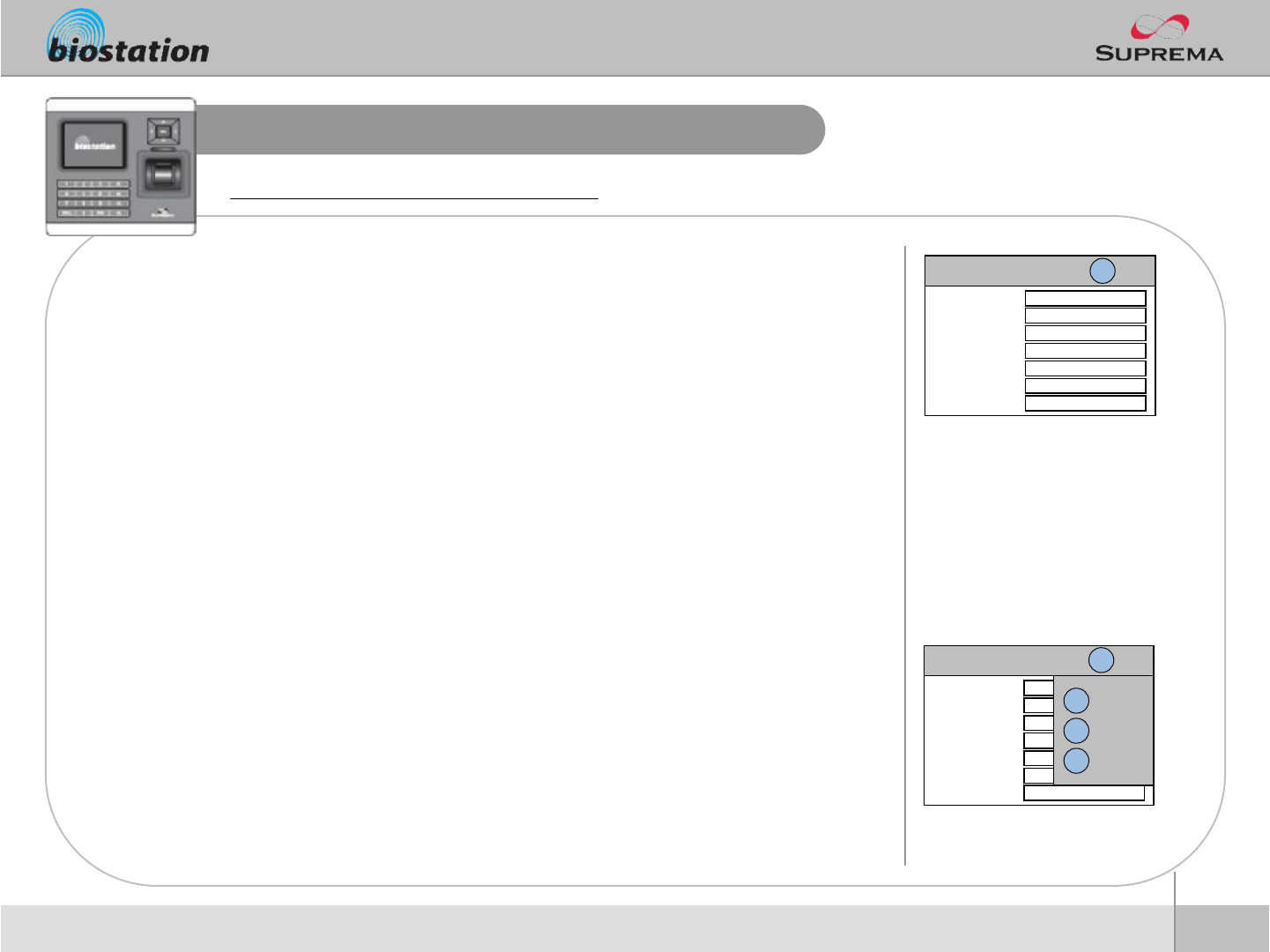
32
ⒸCopyright 2006 Suprema Inc.
Check User Info
nIf you select Edit User on User Management menu, user info of
each users are displayed.
nYou can change user ID using a left/right navigation key.
nIf you enter user ID with the numeric key, you can directly move
to the user info the entered user ID.
lIf there is no user with the selected ID, “None”message is indicated on
the Name field of the display. In that case, if you press left/right
navigation key, you can go to the closest valid user ID.
nAdditional info such as user name, department and company
name can be entered using BioAdmin software on PC.
nIf you press F1 key, active function keys at this menu are
displayed, OK, F2 and F3.
Check user info of currently enrolled users.
Edit User
◀123456 ▶
User ID
Name
Dept.
Admin Level
Password
No of Finger
Group 1
Admin
Registered
2
None
F1 More
Edit User
123456
User ID
Name
Dept.
Admin Level
Password
No of Finger
Group 1
Admin
Registered
2
None
OK Edit User
F2 Finger
F3 Delete
F1 More
For Administrators -Basic Functions
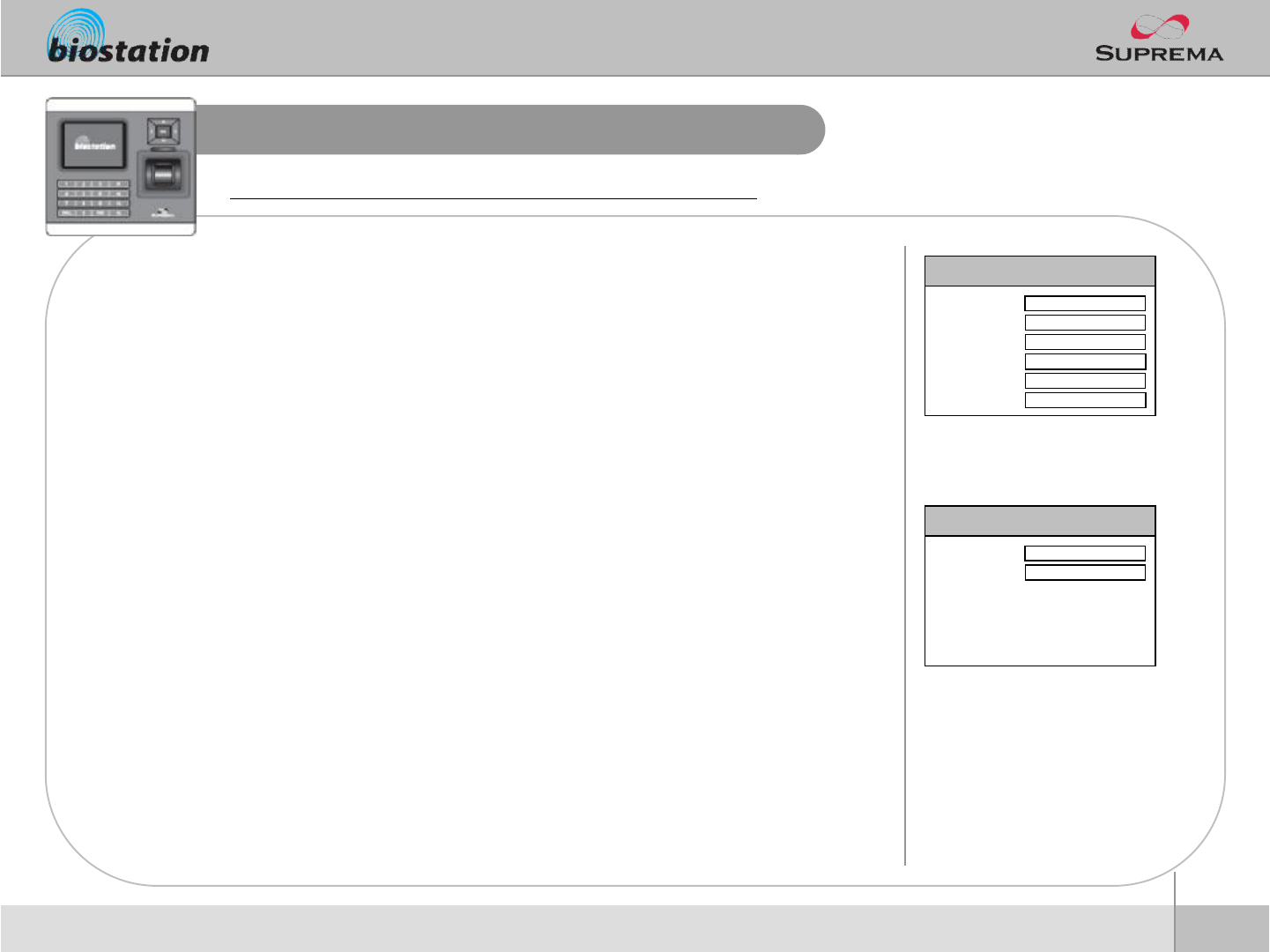
33
ⒸCopyright 2006 Suprema Inc.
Edit User Info
nIf you press OK key at Edit User menu, the selected user info is
displayed and can be edited in the same way as in the Enroll
User process. You can change admin level, password and
groups.
nIf you want to re-enroll fingerprints of the user, press F2 key at
Edit User menu.
nYou can select the number of fingerprints and duress and then
re-enroll fingerprints.
User info can be changed and fingerprints can be re-enrolled.
Enroll Finger
2
Finger No
Duress ◀Last Finger ▶
Edit User : 123456
◁Normal ▷
Admin Level
Password
Group 1
Group 2
Group 3
Group 4
*******
◀None ▶
◀None ▶
◀None ▶
◀None ▶
For Administrators -Basic Functions
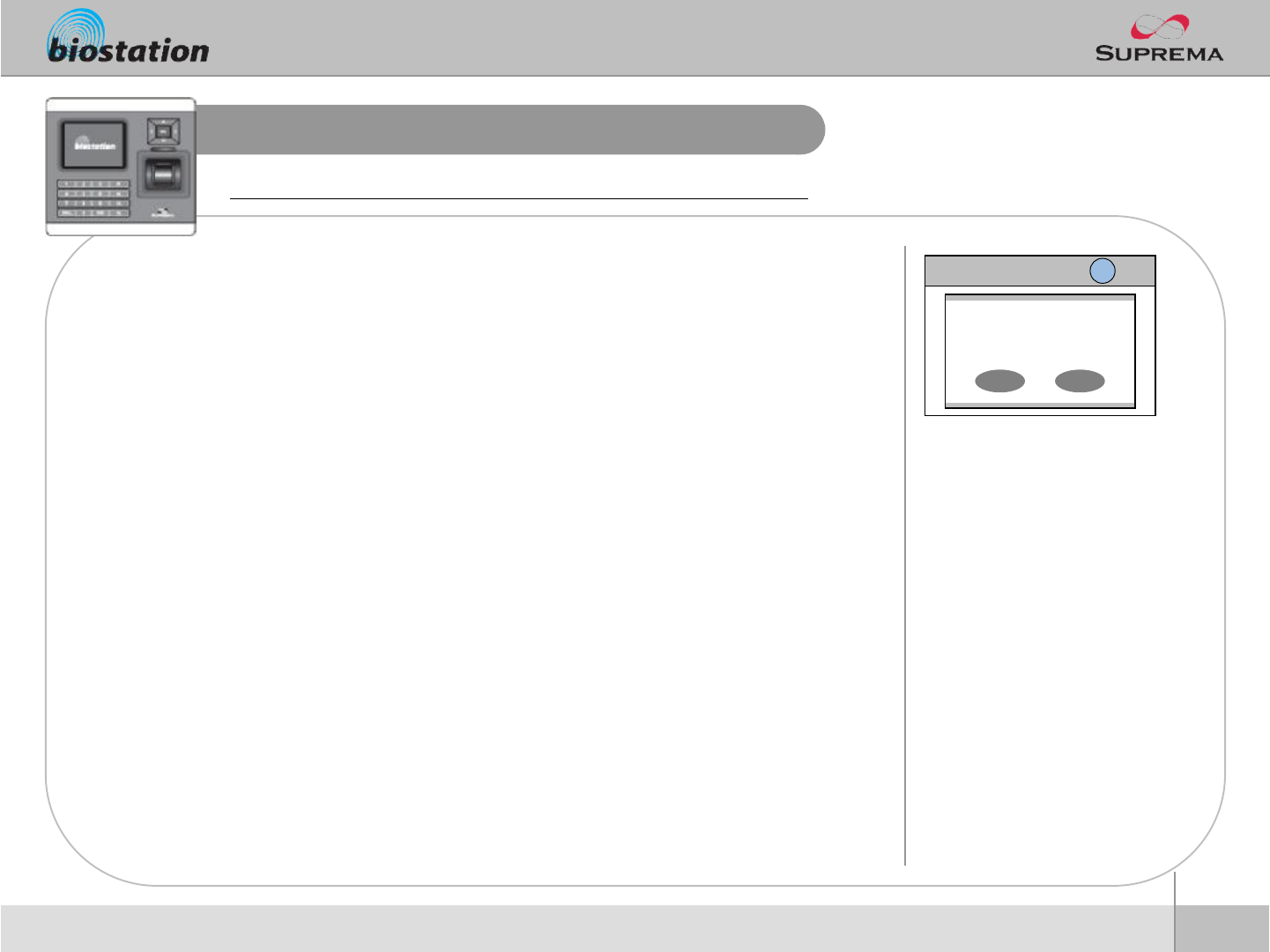
34
ⒸCopyright 2006 Suprema Inc.
Delete User
nIf you want to delete the user, press F3 key at Edit User menu.
nPress OK key to confirm the deletion of the user.
l[Note] Deleted user info can’t be retrieved unless the info remains
in BioAdmin software on PC.
Delete user from device while checking currently enrolled user info.
Edit User
Do you want to delete
this user?
OK ESC
F1 More
For Administrators -Basic Functions
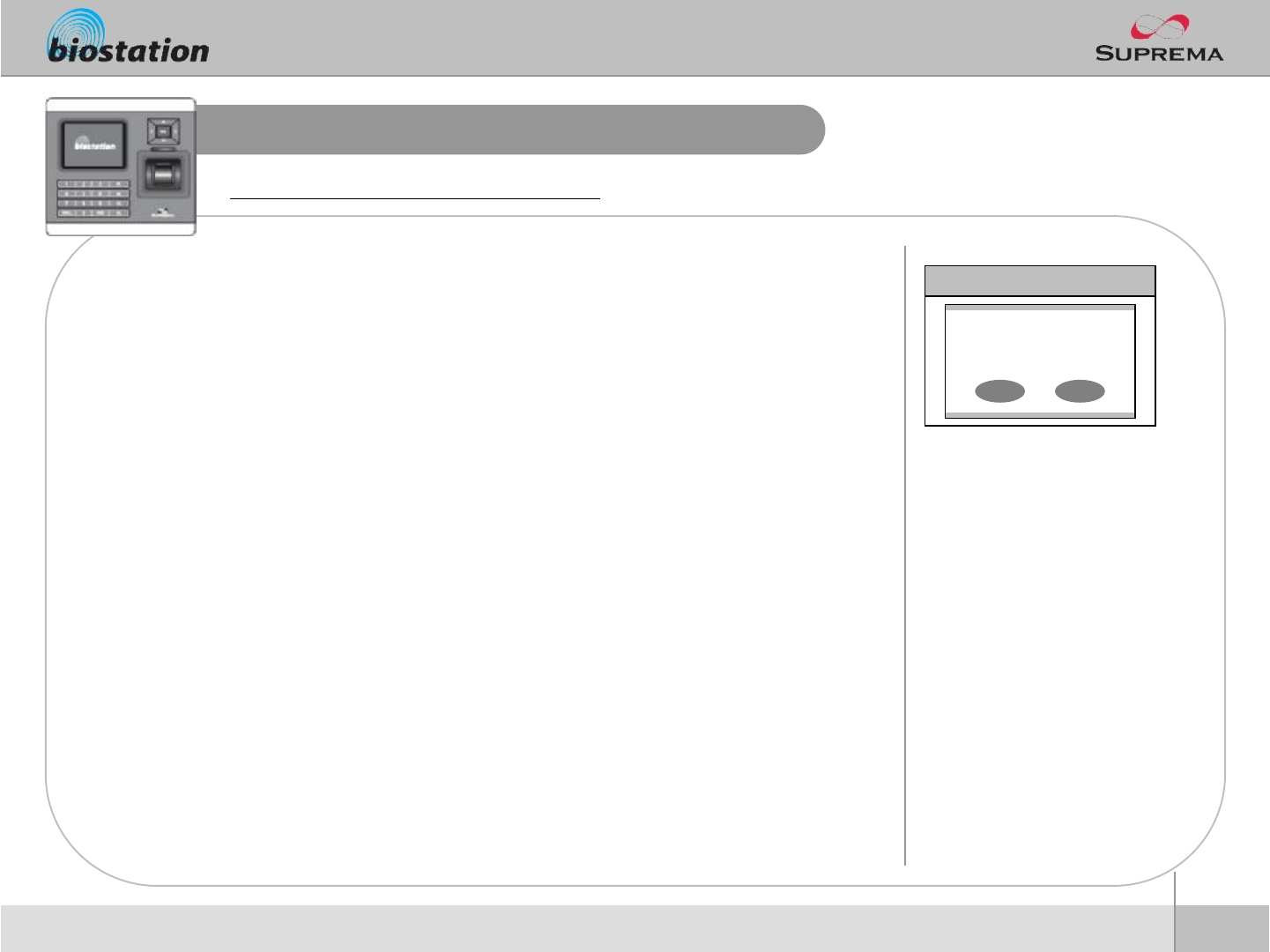
35
ⒸCopyright 2006 Suprema Inc.
Delete All Users
nBack to User Management menu, select Delete All User to delete
all users in the device.
nPress OK key to confirm the deletion of all users.
l[Note] Once all users are deleted, deleted user info cannot be
retrieved unless the info remains in BioAdmin software on PC.
l[Note] The data of administrators who is operating the menu is also
deleted by this operation. Therefore, in order to enter Admin menu
again, you should remember the master password before deleting
all users.
Delete all user currently enrolled in device.
User Management
Do you want to delete
all users?
OK ESC
For Administrators -Basic Functions
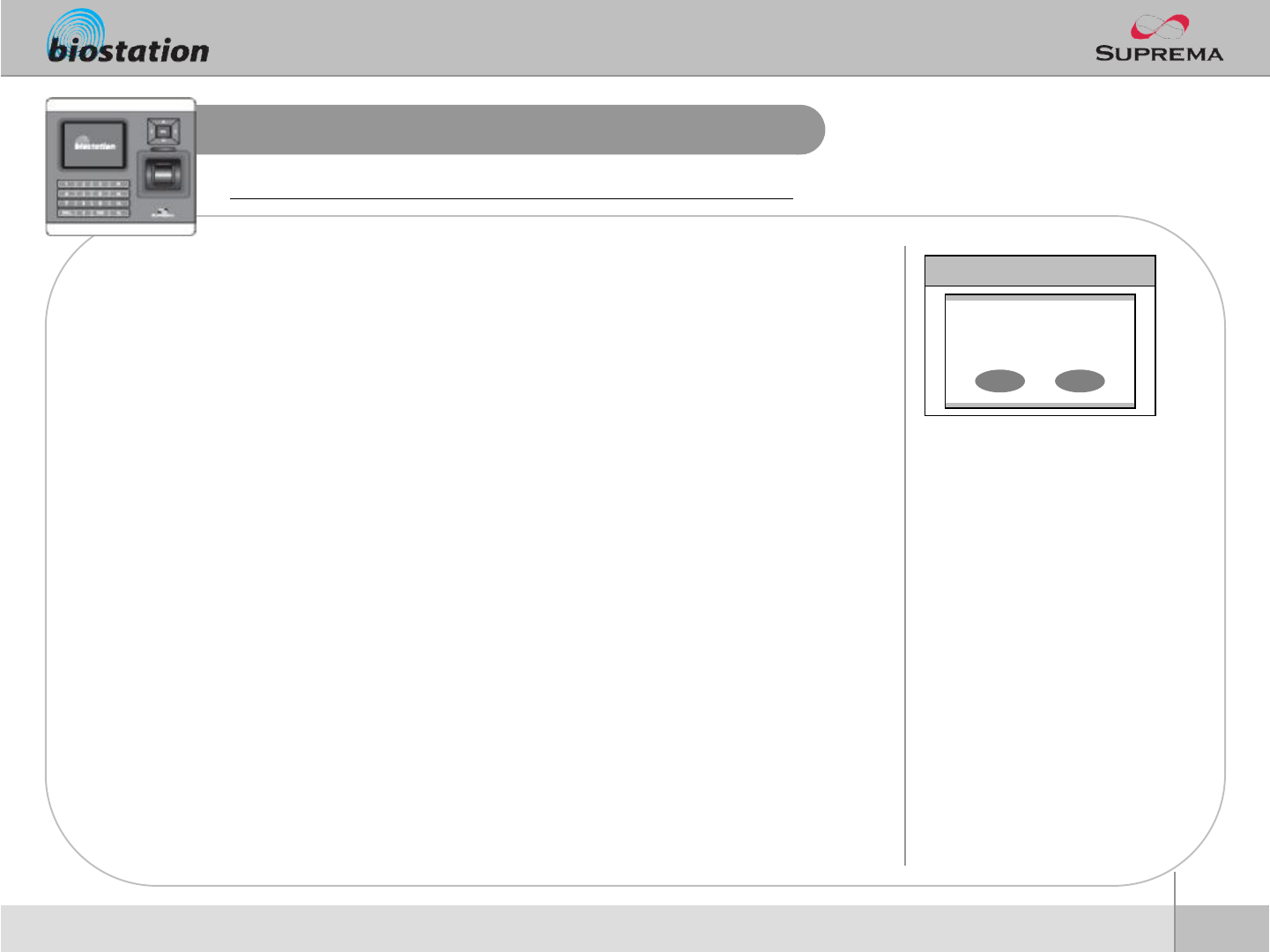
36
ⒸCopyright 2006 Suprema Inc.
Check User DB
nIf you press Check User DB on User menu, following menus
appear on the display.
nPress OK key to check the user DB.
lIf there is an error on the user DB, it will be automatically corrected
by this procedure. If it fails to correct, an error message appear on
display.
Check and correct errors in the user information stored on device.
User Management
Do you want to check
user DB errors?
OK ESC
For Administrators -Basic Functions
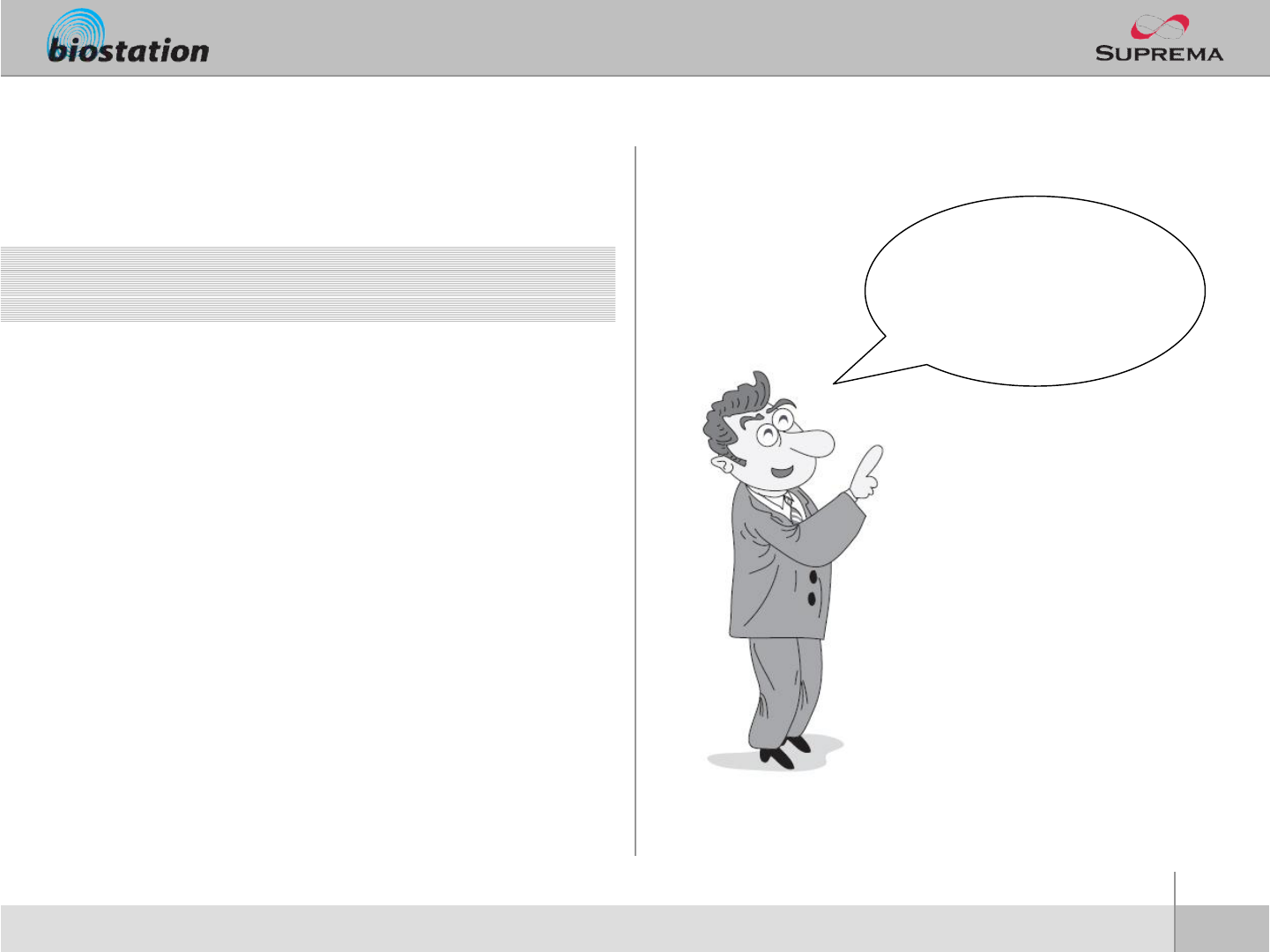
37
ⒸCopyright 2007Suprema Inc.
For Administrators -Advanced Functions
Detailed information for
device administrators. It
includes specific items such
as display and sound setting,
fingerprint authentication
setting, and log check.
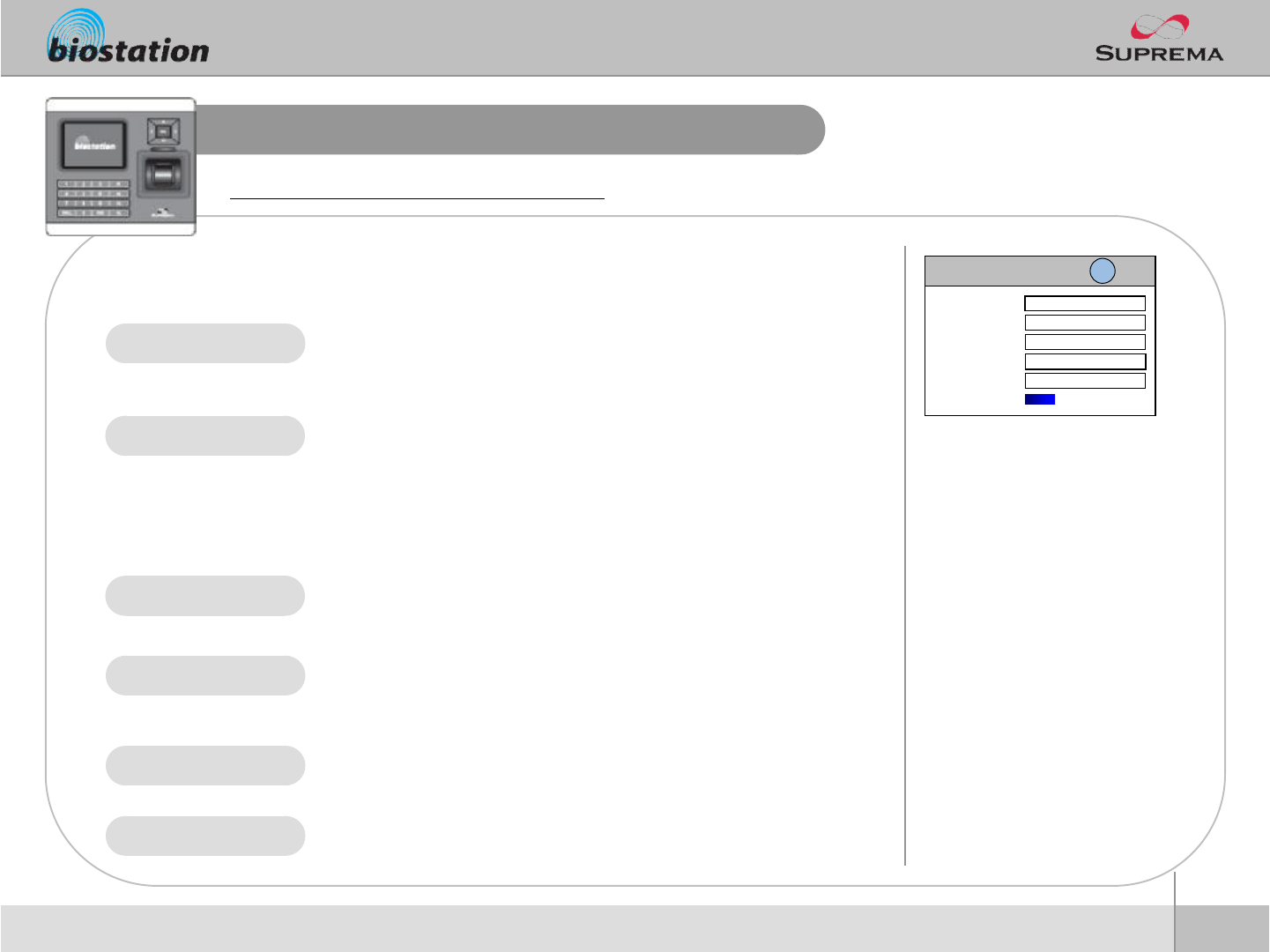
38
ⒸCopyright 2006 Suprema Inc.
Display & Sound Setting
nIf you select Display on initial Amin menu, following menus will
appear on the display.
Change device’s display and sound settings.
lSetting :Korean/English/Custom
lSelect a language to be used
lTo use custom language, appropriate language config. file needs
to be downloaded to the device using BioAdmin program on PC.
Please contact Suprema for details.
lSetting : Logo/Slide Show/Notice
lDecide background of initial display. In case of Logo, one photo
assigned as logo is displayed all the time. In case of Slide Show,
multiple photos are displayed at the interval of 5 seconds in turn. In
case of Notice, one photo is displayed as a background and a
notice is scrolled down over the background.
lIn order to change background images, use BioAdmin program on
PC.
lSetting : Time/None
lSub Info is a display area in the bottom side of the display. Current
date and time will be shown with a selection of Time. Or the area
can be left blank with the selection of None.
lSetting : Infinite/10 sec/20 sec/30 sec
lIf there’s no key input during this time out period on Admin menu,
the device automatically returns to initial display for security
reason.
lSetting : 0.5sec/1sec/2sec/3sec/4sec/5sec
lIt sets message time in display upon the fingerprint matching.
lSetting : 0%/10%/20%/…/100%
lSet output volume of the device sounds. 100% is the maximum. At
setting 0%, sound is turned off.
Language
Background
Sub Info
Timeout
Volume
For Administrators -Advanced Functions
Msg Time
Display
◁English ▷
Language
Background
Sub Info
Timeout
Msg Time
Volume
◀Logo ▶
◀Time ▶
◀Infinite ▶
◀2 sec ▶
F1 Time
20%
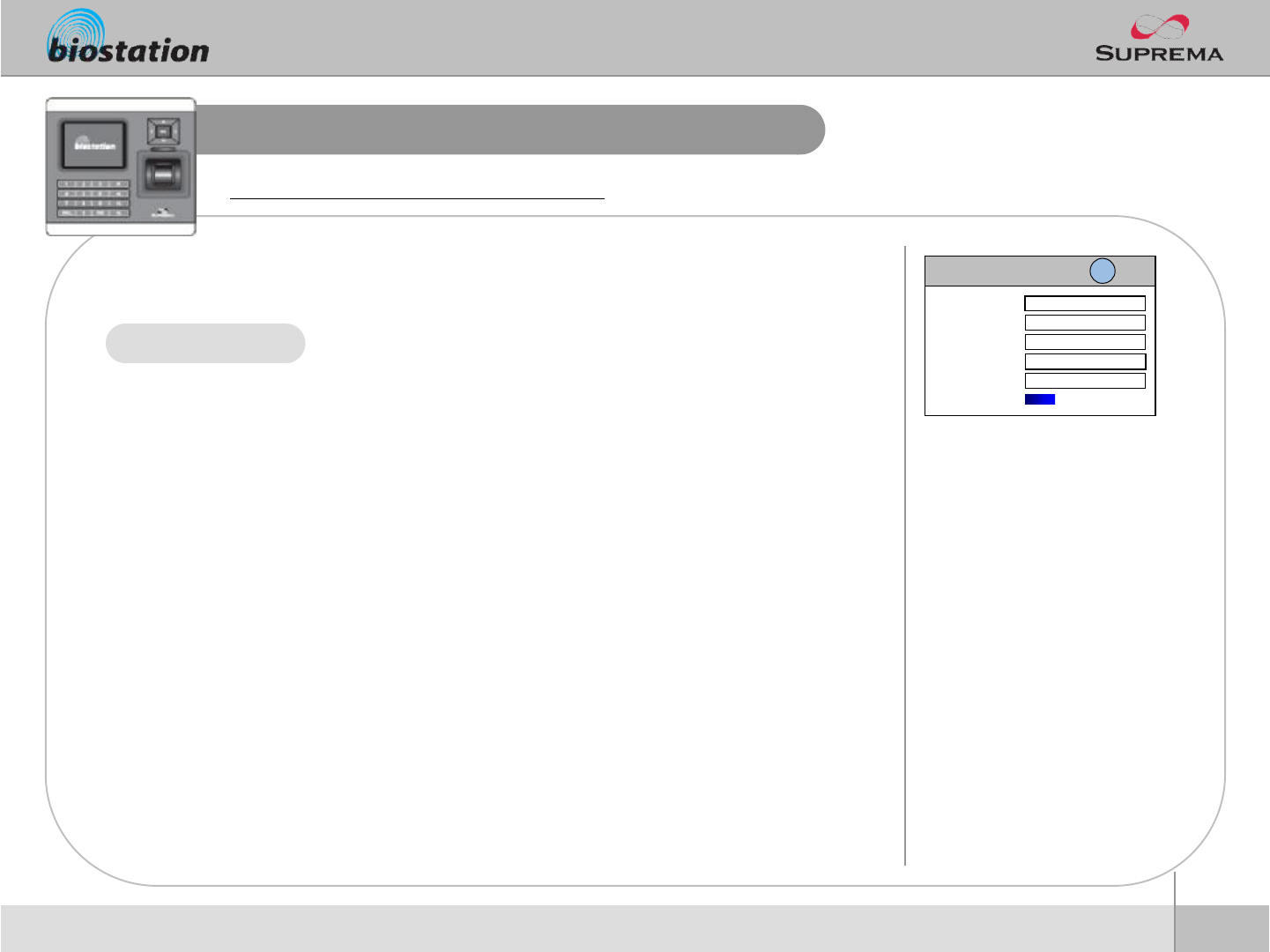
39
ⒸCopyright 2006 Suprema Inc.
Display & Sound Setting
nIf you select Display on initial Amin menu, following menus will
appear on the display.
Change device’s display and sound settings.
lDate : YYYYMMDD
lTim : hhmmss
lTime synchronization : Terminal time will be synchronized with
server time.
lDate format : MM/DD or DD/MM
Time
For Administrators -Advanced Functions
Display
◁English ▷
Language
Background
Sub Info
Timeout
Msg Time
Volume
◀Logo ▶
◀Time ▶
◀Infinite ▶
◀2 sec ▶
F1 Time
20%
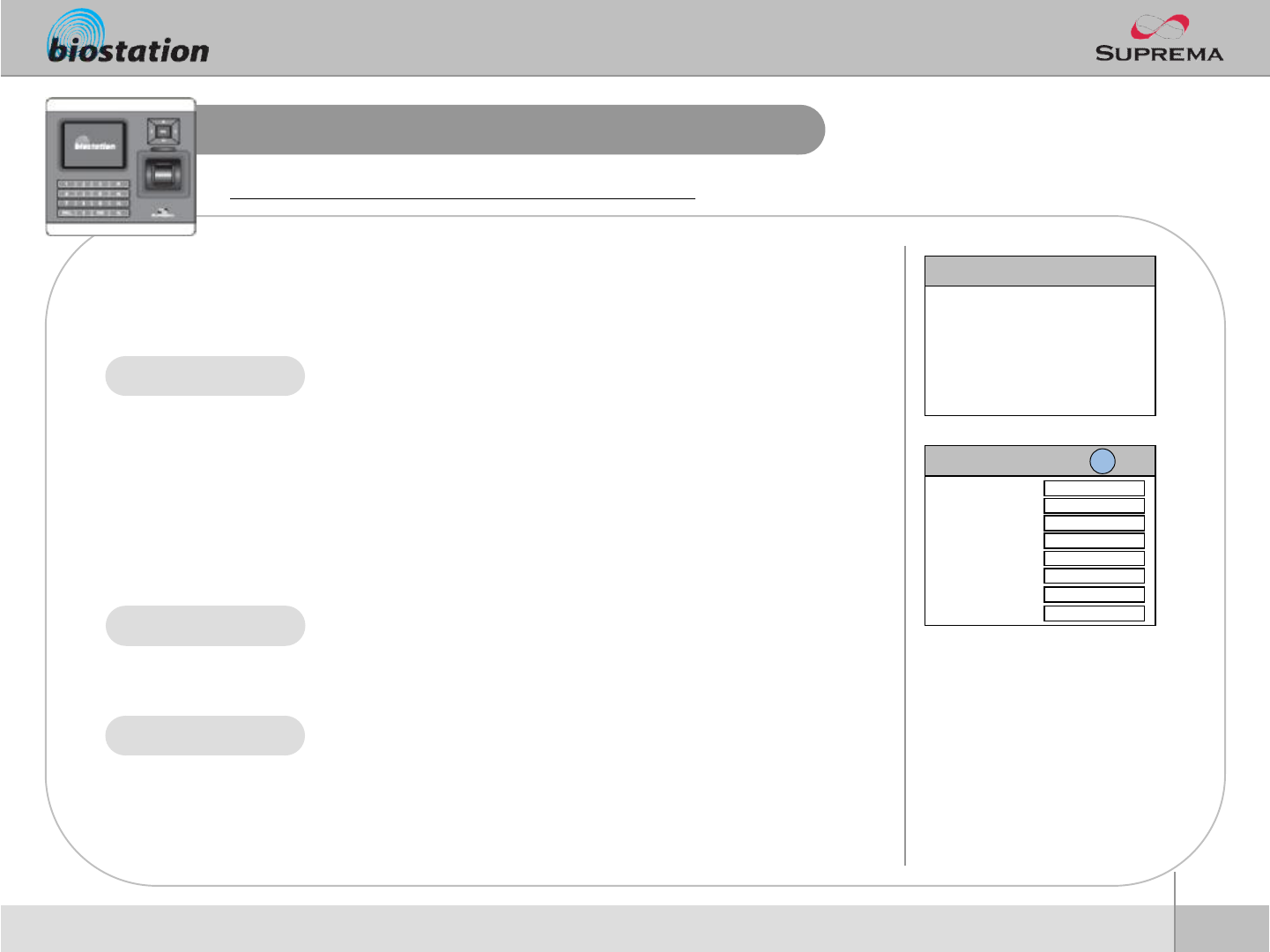
40
ⒸCopyright 2006 Suprema Inc.
Fingerprint Setting
nIf you select Device on initial Admin menu, Device Setup menus
appear on the display. Then select Fingerprint for setting
related to fingerprint authentication.
Change various settings for fingerprint authentication.
lSetting : Normal/Secure/Most Secure
lSecurity level is determined by FAR (False Acceptance Ratio).
FAR refers to the percentage of acceptance by unregistered
fingerprints. Therefore, the lower the percentage is, the higherthe
security level is. However, as the FAR and FRR (False Reject
Rate) are in reverse proportion to each other, the higher security
level will indue bigger FRR, ie., more failure for registered fingers.
lFor general T&A applications, normal level is recommended.
However, in case of an access control application requiring a
higher security level, it is recommended to apply the security level
as secure or most secure.
lSetting : Normal/Fast/Fastest
lUsing 1:N mode with more than hundreds of users, identification
may take somewhat longer. In this case, you can change the fast
mode to Fast or Fastest. By doing so, identification speed
becomes faster in sacrifice of a little higher FRR.
lSetting: Weak/Normal/Strict
lQuality level decides the strictness of quality check of the input
images. With a strict quality level, the device may reject a low
quality input fingerprint more.
Security
Device Setup
Fingerprint
I/O
Door Relay
Access Control
Master Password
Device Info
Device Reset
Factory Default
For Administrators -Advanced Functions
Fingerprint
◀Normal ▶
Security
Fast Mode
Quality
View Image
Sensitivity
Timeout(Sec)
1:N Delay
Check Duplicate
◀Auto ▶
◀Normal ▶
◀Visible ▶
◀7 (Max) ▶
◀10 ▶
◀Not Use ▶
◀0 ▶
F1 More
Fast Mode
Quality
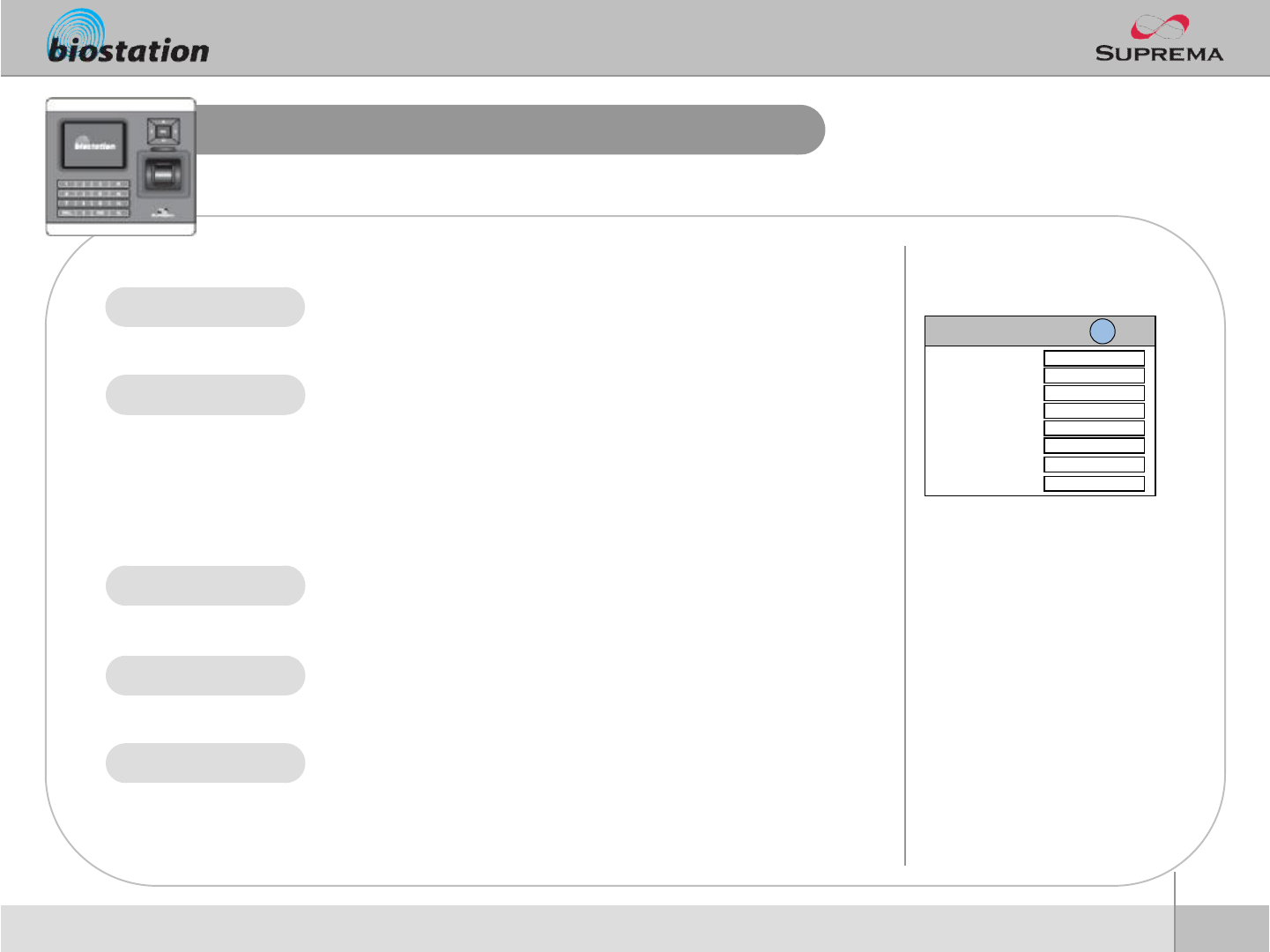
41
ⒸCopyright 2006 Suprema Inc.
Fingerprint Setting
For Administrators -Advanced Functions
Fingerprint
◀Normal ▶
Security
Fast Mode
Quality
View Image
Sensitivity
Timeout(Sec)
1:N Delay
Check Duplicate
◀Auto ▶
◀Normal ▶
◀Visible ▶
◀7 (Max) ▶
◀10 ▶
◀Not Use ▶
◀0 ▶
F1 More
lSetting : Visible/Invisible
lProper enrollment can be induced by showing the image of the
entered fingerprint on LCD screen upon enrollment.
lSetting : 0(min)/1/2/3/4/5/6/7(max)
lSet sensitivity of fingerprint sensor in a capture of a fingerprint. At a
high sensitivity level, it is easier and faster to capture a fingerprint.
On the other hand, at a low sensitivity level, the image qualityof the
captured fingerprint can be more stable.
lIn normal applications, maximum level is recommended. If the
recognition is not satisfactory for wet fingerprints, reducing
sensitivity may solve the problem.
lSetting : 1/2/…/10/…/19/20
lSet standby time for fingerprint enrollment. If a user does not place
a finger within the time, a timeout message appears on the display.
lSetting : 0/1/2/…./10
lIt means the time of delay from 1:N authentication to next stand-by
authentication
lSetting : Not Check / Check
lIn enrollment, checks whether the fingerprint is duplicated or not.
View Image
Sensitivity
Timeout(Sec)
Duplicate
1:N Delay
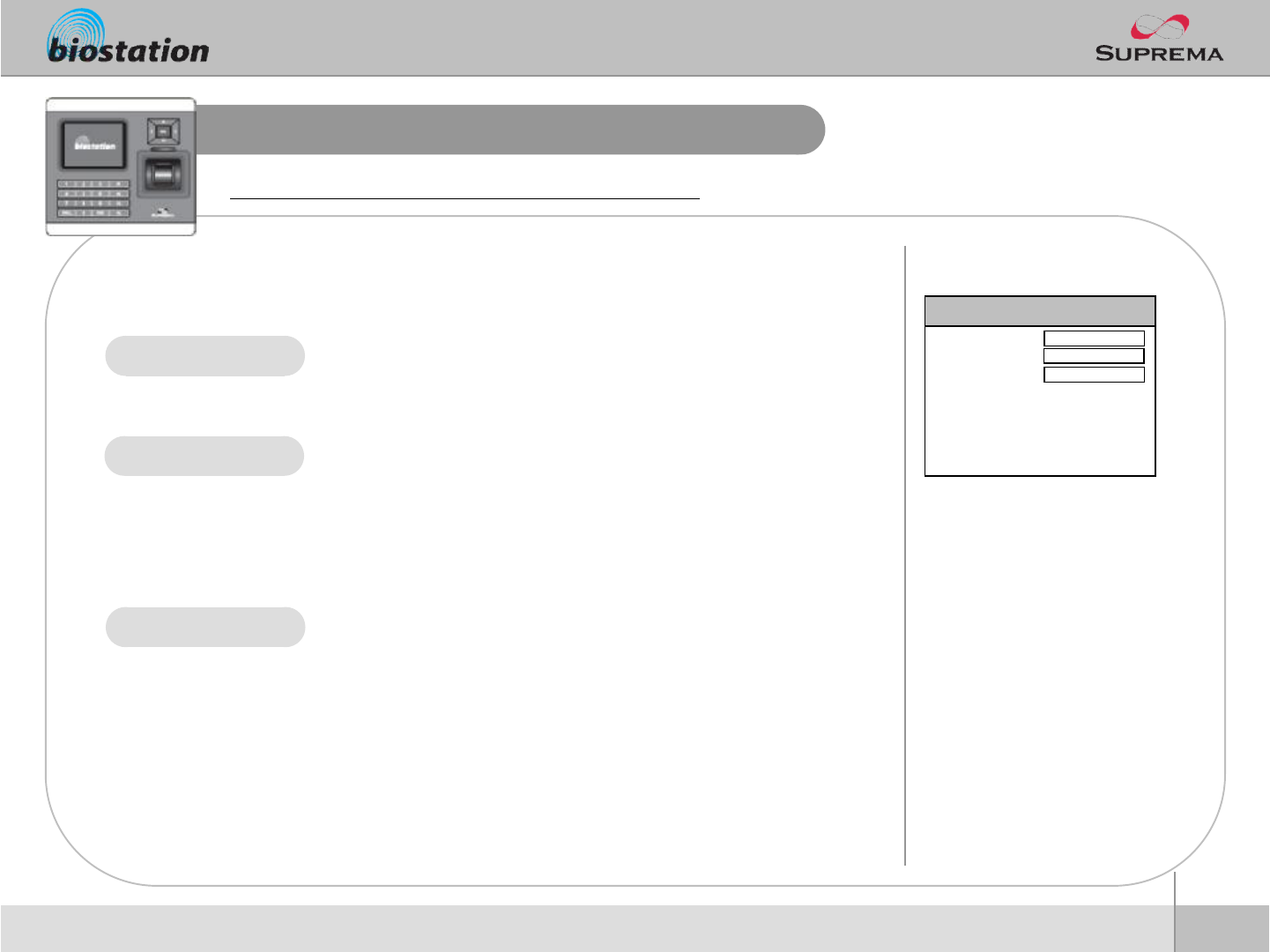
42
ⒸCopyright 2006 Suprema Inc.
Fingerprint Setting
nPress F1 on Fingerprint menu to set detailed fingerprint options.
Change detailed settings for fingerprint authentication.
Match Timeout
For Administrators -Advanced Functions
Fingerprint
◀3 ▶
Match Timeout
Calibration
Encryption Not Use
lSetting : 1/2/3/…/19/20
lTimeout in 1:N identification. If the device cannot find a matched fingerprint
in this period, it results in identification fail. This is to avoid too long waiting
time in case of large enrollments.
lFor TC sensor, this menu calibrates the sensor’s internal paramters
according to outer enviroment. Since sensor calibration is done in factory, it
doesn’t need to do this usually except the case where sensors are replaced
or sensitivity of the sensor is abnormal.
lTo calibrate the sensor, select “Enable”and click OK button.
lThis menu disappears for OC or FC model.
lShows current device setting whether to encrypt fingerprint templates or not
for security purpose.
lThis menu only shows current setting and the settings can be changed only
by BioAdminprogram on PC.
◀Disable ▶
Encryption
Calibration
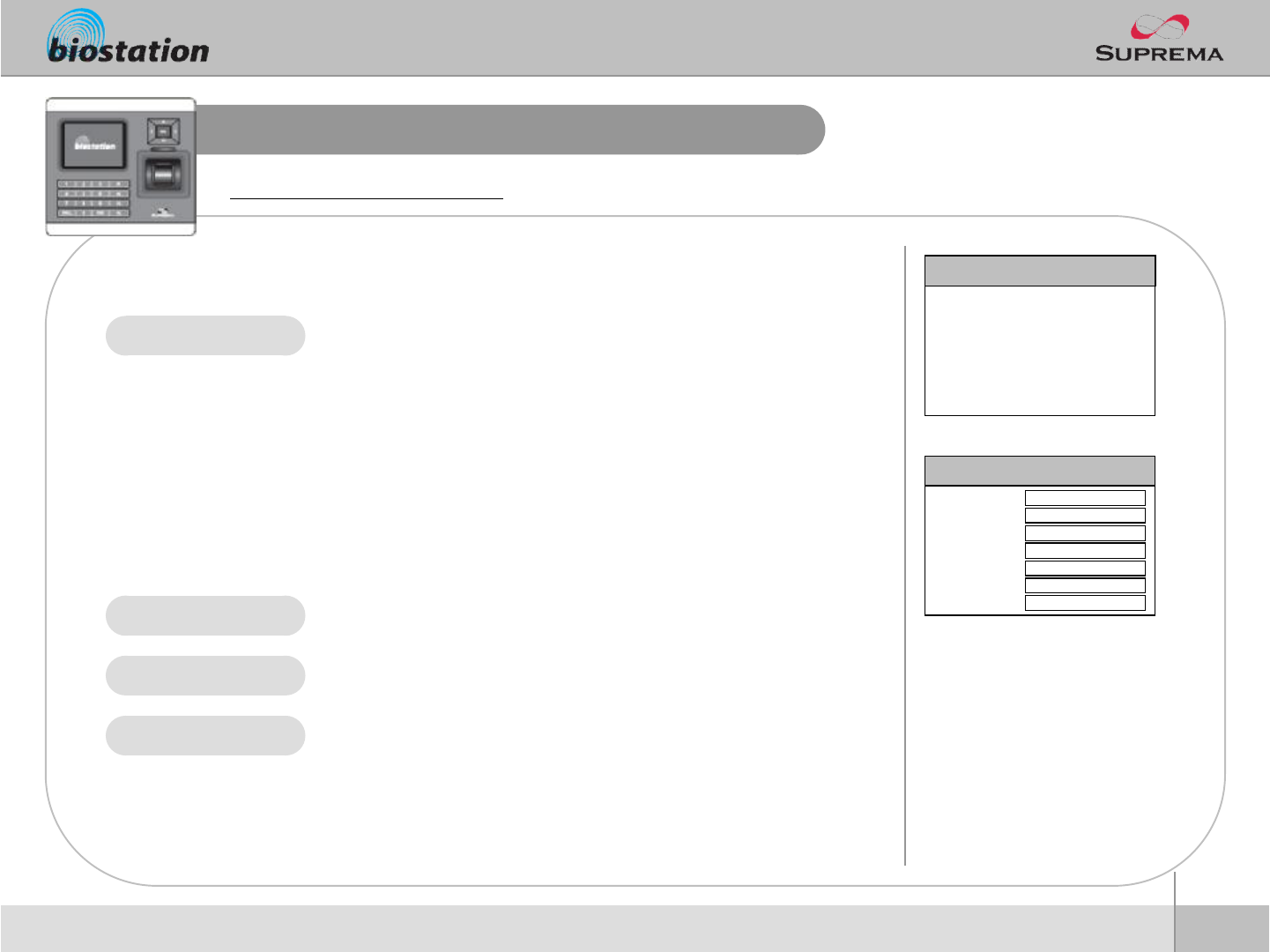
43
ⒸCopyright 2006 Suprema Inc.
I/O Setting
nIf you select I/O on device menu and click Input, following
menus appear on display.
Change various settings for I/O.
lSetting : Disabled/Exit/Wiegand User ID/Wiegand Card ID/Generic
Input/Emergency Open/Alarm Off/Reset/Lock System
lIn case of using the input port for RTE(exit button), select Exit.
lIn case of using input as Wiegand User/Card ID, input 0 and input
1 are set as Wiegand User/Card ID.
lGeneric Input : general input. Can be configured with output.
lEmergency Open : All relays for doors are turned on for door open
lAlarm Off : All relays are turned off to release alarm
lReset : System reset
lLock System : the device gets locked. Can be relasedwith master
password only.
lMinimum duration of input signal to decide validity
lSet N/O (Normal Open) or N/C (Normal Close)
lSetting : None/Lock System/Generic Input/Emergency Open/Alarm
Off/Reset
lTamper switch is turned on when a housing(case) of BioStation is
opened. If the setting is in “Lock System”, the device is
automatically locked when a tamper switch is on for security.
l[Note] Once BioStation is locked, lock can be released only when
the master password is entered. It cannot be released by
administrator’s fingerprint.
Input 0/1
Input Type 0/1
Duration 0/1(ms)
Tamper S/W
For Administrators -Advanced Functions
I/O
◀Disable ▶
Input 0
Duration0(ms)
Input Type 0
Input 1
Duration1(ms)
Input Type 1
Tamper SW
0
◀N/O ▶
◀Disable ▶
0
◀N/O ▶
◀None ▶
I/O
Input
Output
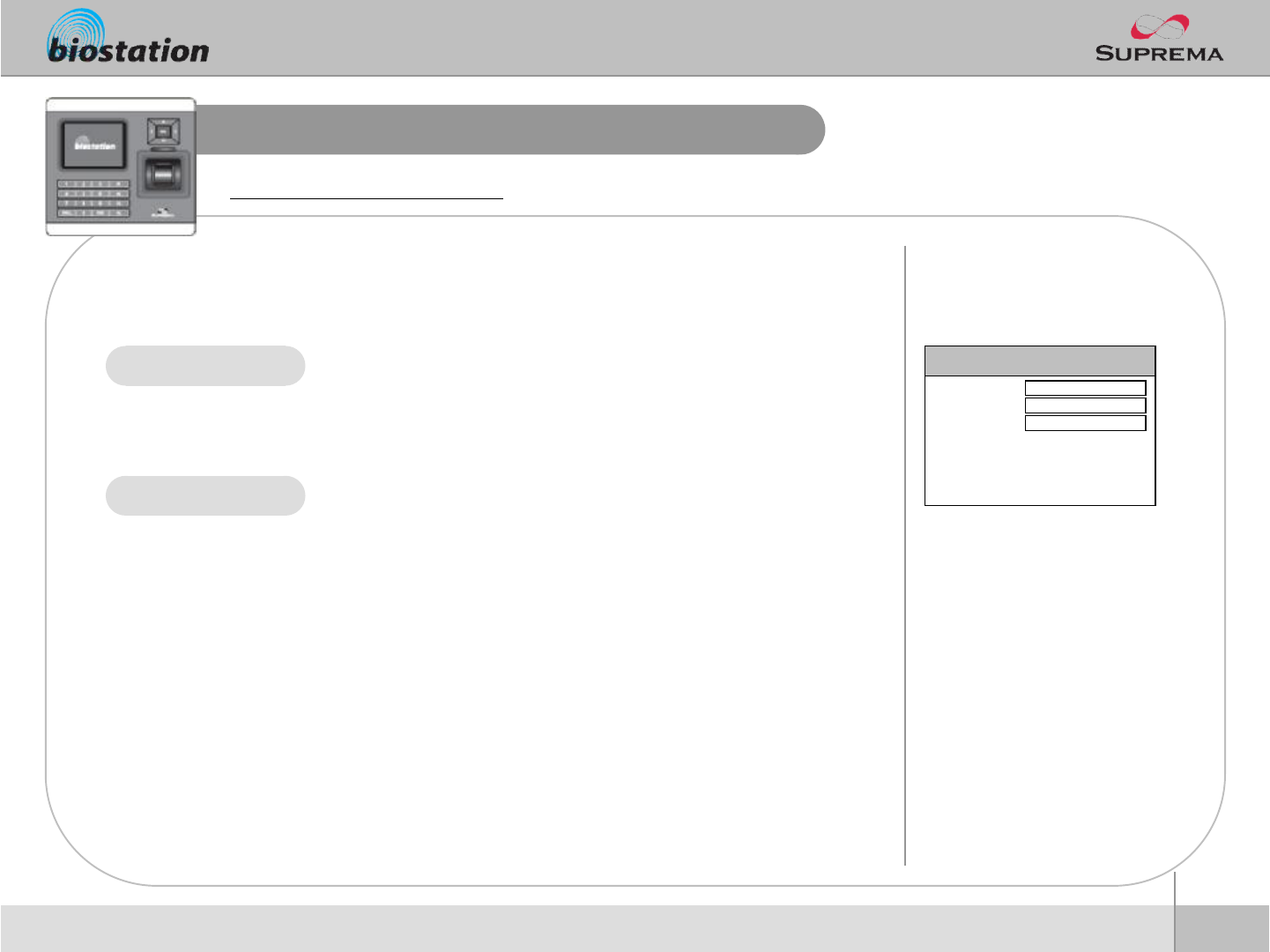
44
ⒸCopyright 2006 Suprema Inc.
I/O Setting
nIf you select I/O on device menu and click Output, following
menus appear on display.
Change various settings for I/O.
lSetting: Disabled/Duress/Tamper SW/Auth Success/Auth
Fail/Wiegand User ID/Wiegand Card ID
lCan send outputs for various events.
lIn case of using output as Wiegand User/Card ID, output 0 and
output 1 are set as Wiegand User/Card ID.
lSet the cycle of output signal. Default is 1sec (1000ms).
Output 0/1
Duration(ms)
For Administrators -Advanced Functions
I/O
◀Disable ▶
Output 0
Output 1
Duration(ms)
◀Disable ▶
1000
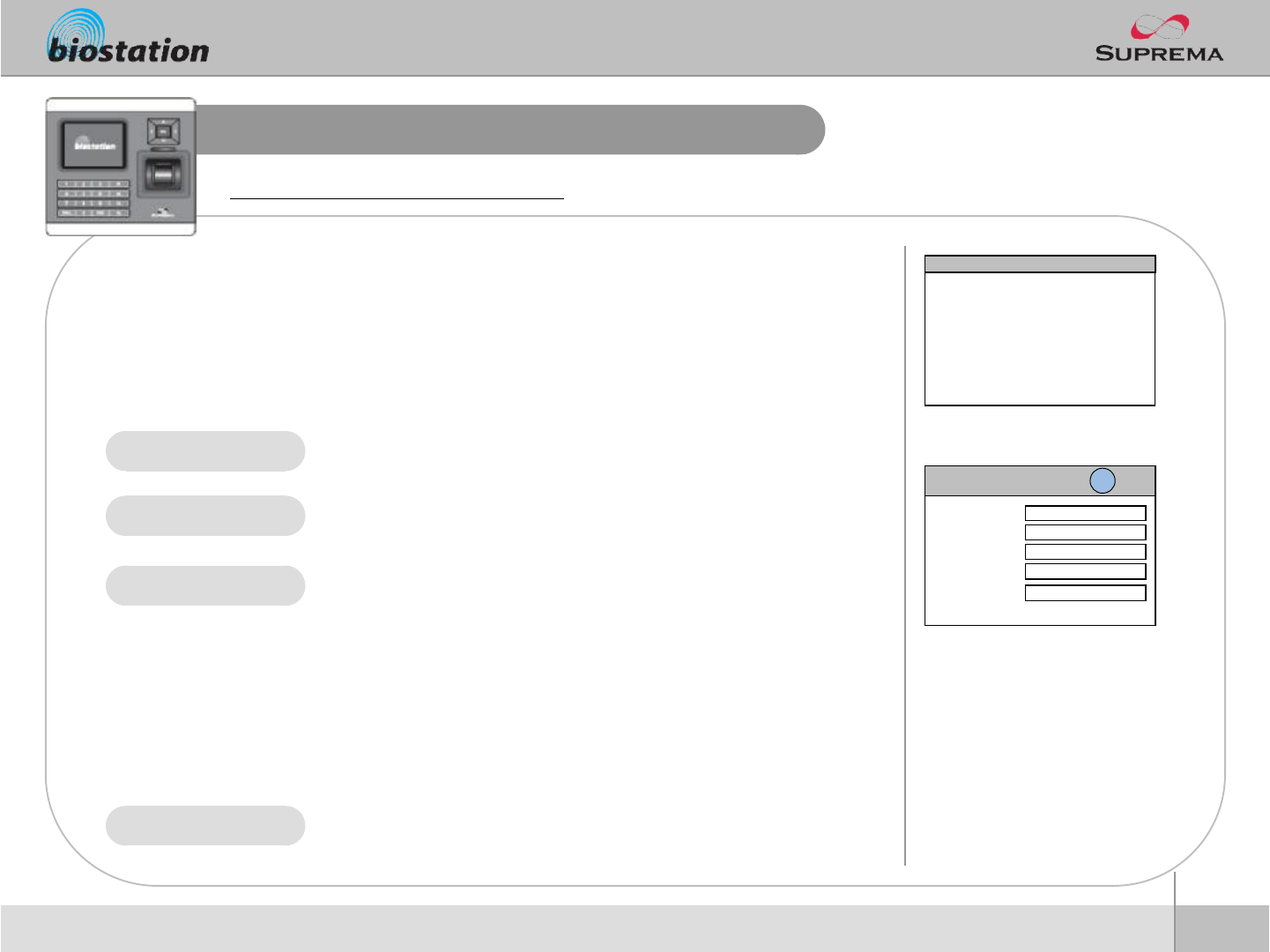
45
ⒸCopyright 2006 Suprema Inc.
Door Relay Setting
nIn a simple standalone door control, internal relay of BioStation can be used
to drive a door lock. For increased security, external device like Secure I/O
or another BioStation can be installed inside of a room. Two devices are
connected by RS485 and support a local anti-passbackfunctions. Up to 2
BioStationsand 4 Secure I/Os can be connected in a single RS485 loop.
nIf you select Door Relay on device menu and select Door#, following menus
appear on the display.
Change various settings for door relay.
lSelect which relay shall be used
lSetting: Internal Relay/Slave Relay/SIO# Relay#/Not Use
lSelect a device to be installed inside and outside.
lSetting: Not Use/Device ID
lSetting: All events / Authentication +T&A event/Authentication/T&A
event/Disabled
lIn case of All events, door opens for all authentication success(1:1 PIN
auth.,1:1 fingerprint auth.,1:1 fingerprint verification)
lIn case of authentication with T&A event, door opens only by thespecific
events for which door use is allowed and also door opens only by
authentication.
lIn case of authentication, door opens only by authentication without T&A
event
lIn case of selected T&A, door opens only by the specific eventsfor which
door use is allowed.
lIn case of disabled, BioStation will not drive an internal relayto open a
door by any of events or authentication.
lDuration of the relay activation (door open)
Relay
For Administrators -Advanced Functions
Duration (sec)
Out/In Device
I/O
Door 0
Door 1
APB
Interphone
Driven by
Door0
◀Internal Relay▶
Relay
Out Device
In Device
Driven by
Duration(sec)
◀5503 ▶
◀1208 ▶
◀All Events ▶
3
F1 More
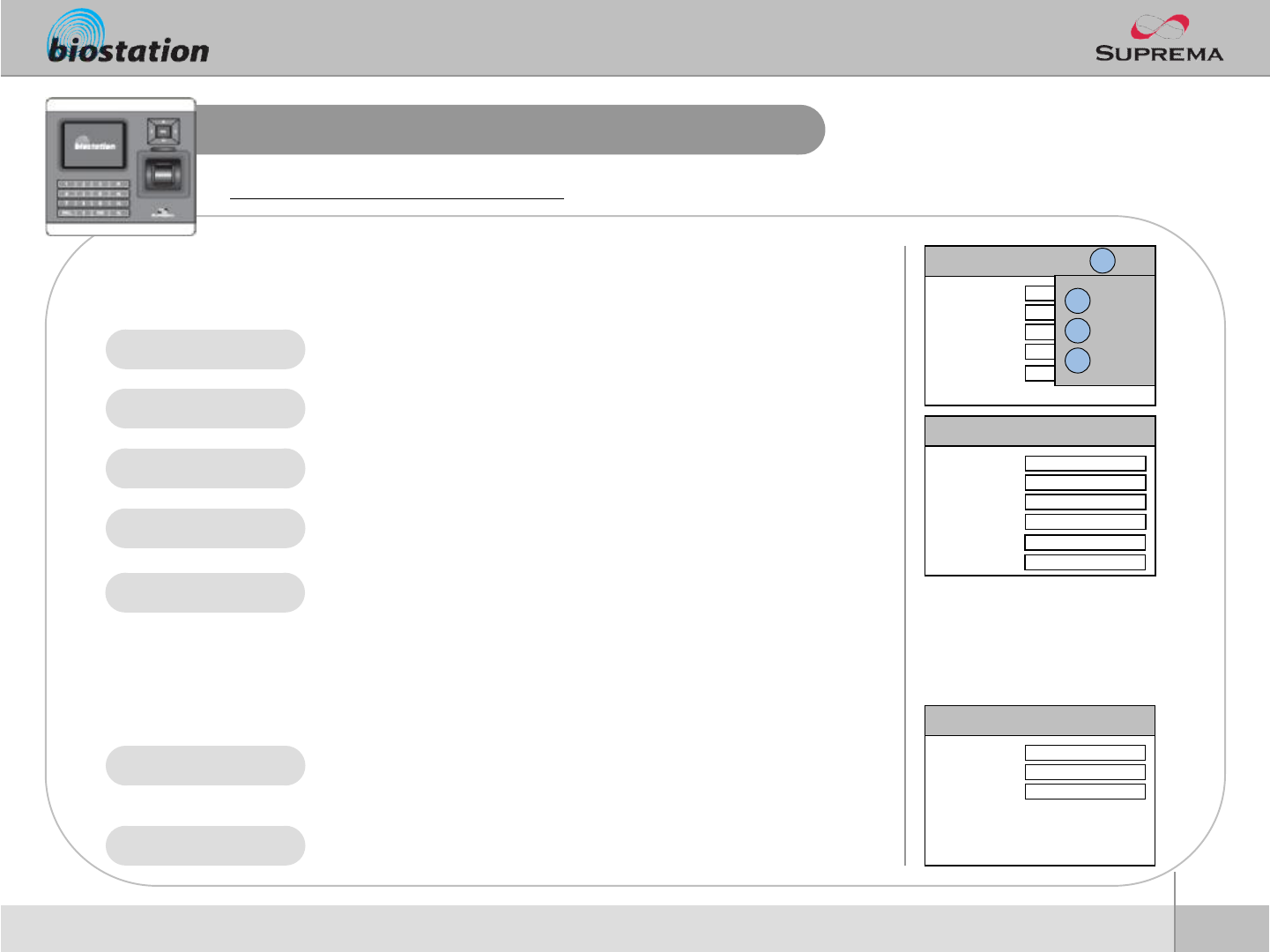
46
ⒸCopyright 2006 Suprema Inc.
Door Relay Setting
nIf you select F1 –F2(Input) on Door# setting menu, following
menus appear on the display.
nIf you select F1 –F3(Schedule) on Door# setting menu,
following menus appear on the display.
Change various settings for door relay.
lSelect Request To Exit (Exit button) setting related to the relay
lSetting: Not Use/Input# (input port of the seleceteddevice)
lSet N/O (Normal Open) or N/C (Normal Close)
lSelect Door Sensor setting related to the relay (door)
lSetting: Not Use/Input# (input port of the seleceteddevice)
lSet N/O (Normal Open) or N/C (Normal Close)
lWhen the door is open longer than this period(sec), door open
alarm is activated. Specific output can be set by BioAdmin
program on PC. Default is 0 meaning no alarm.
lDecide time to lock(close) the door by force.
lDuring lock time, general users cannot open door while only
administrators are allowed.
lSpecific schedule for lock time can be set by BioAdmin program on PC.
lDecide time to open the door by force
lSpecific schedule for unlock time can be set by BioAdmin programon PC.
For Administrators -Advanced Functions
RTE
Lock time
Unlock time
Door0
Internal Relay
Relay
Lock Time
Unlock Time
◀No Time ▶
◀All Time ▶
Door0
◀Internal Relay▶
Relay
Reader0
Reader1
Driven by
Duration(sec)
◀Primary ▶
◀Secondary ▶
◀All Event ▶
3
F1 More
OK Apply
F2 Input
F3 Schedule
Input Type
Door Sensor
Input Type
Open Alarm
Door0
Internal Relay
Relay
RTE
Input Type
Door Sensor
Input Type
Open Alarm
◀Not Use ▶
◀N/O ▶
◀Not Use ▶
0
◀N/O ▶
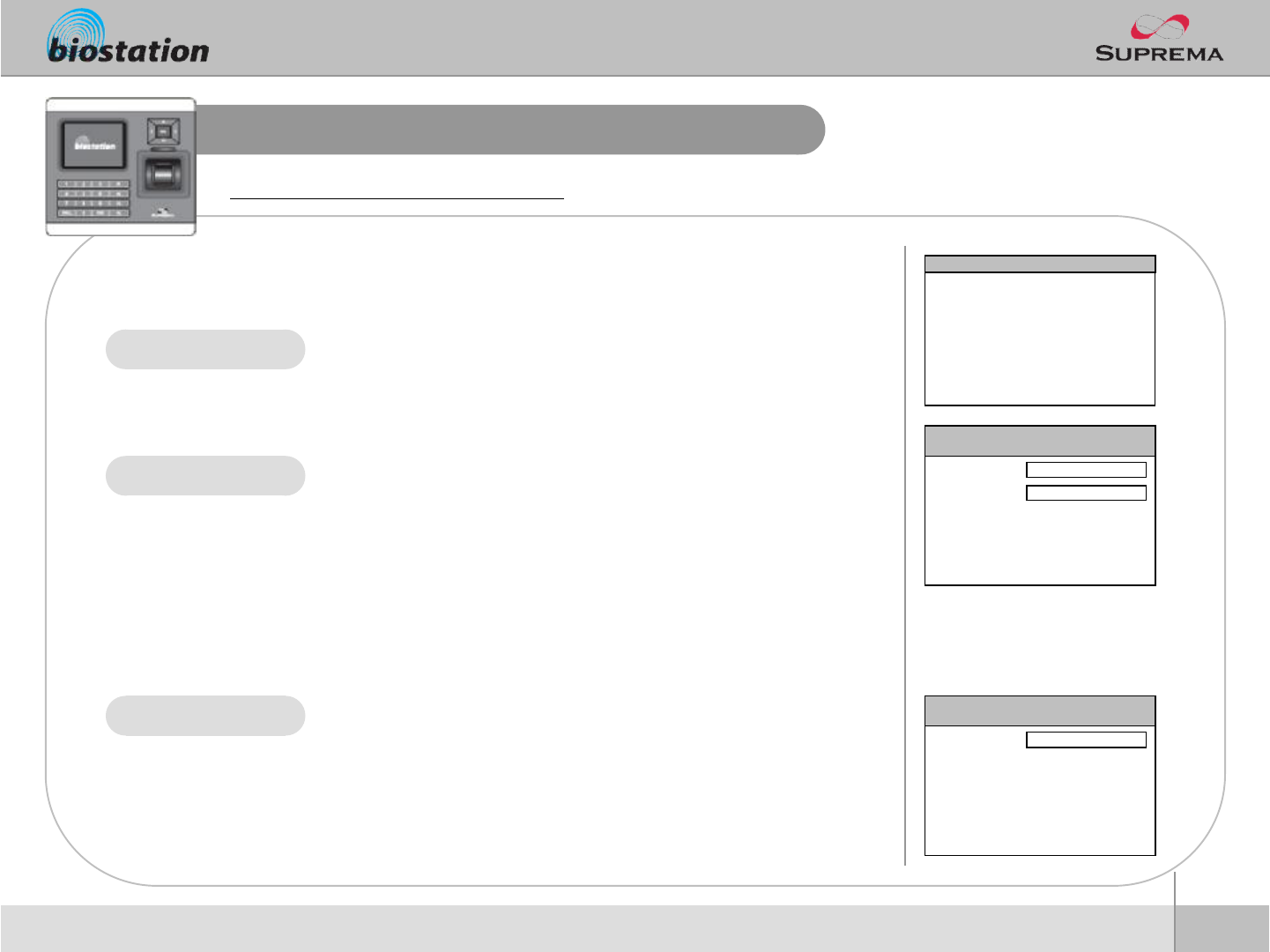
47
ⒸCopyright 2006 Suprema Inc.
Door Relay Setting
nIf you select APB on Door Relay menu, following menus appear
on the display.
nIf you select Interphone on Door Relay menu, following menus
appear on the display.
Change various settings for door relay.
lSelect anti-passbacksetting
lSetting: Disable/Hard/Soft
lIn “Hard”mode, relay does not work and log is recorded in case of
anti-passbackevents. In “Soft”mode, log is recorded burelay
works as usual.
lDuration(min) of automatic reset of APB for each user. If it is set
as 30(min), for example, APB record is erased for 30 minutes after
each authentication of users. If 0, there is no automatic reset.
lSetting : Disable / Enable
lTo connect and use an optional interphone with BioStation, enable
interphone on this menu. CALL button and interphone communication of
BioStation will operate only when this menu is set as Enable.
For Administrators -Advanced Functions
APB Type
Interphone
Reset Time
APB
0
APB Type
Release Time
◀Hard ▶
Interphone
Interphone ◀Disable ▶
I/O
Door 0
APB
Interphone
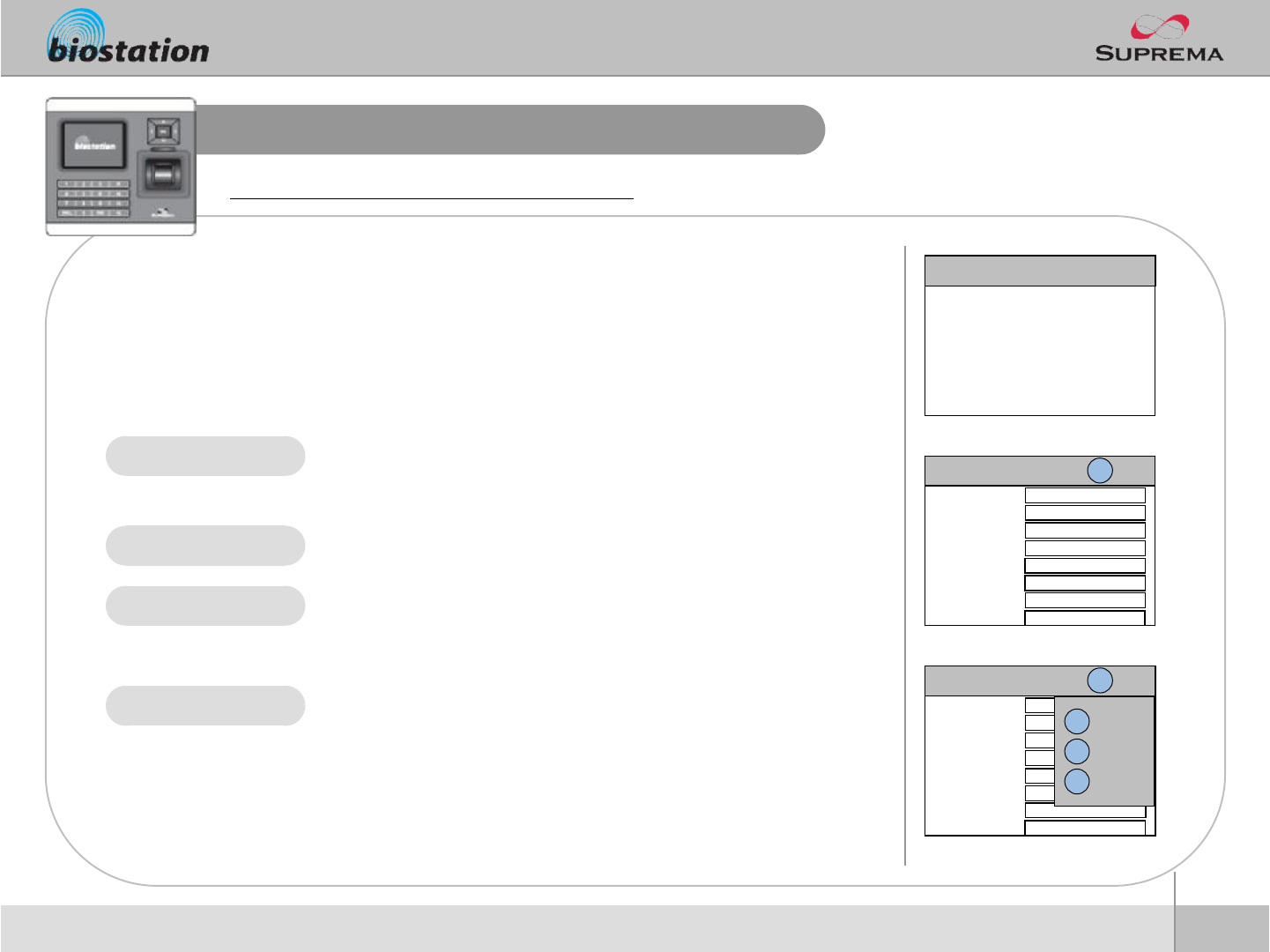
48
ⒸCopyright 2006 Suprema Inc.
Zone
nZone is a group of devices connected by TCP/IP and integrated together
supporting data synchronizations, global anti-passbackand entrance limits.
One of the devices should be assigned as a master in the zone. Master device
collects and synchronize user and log information and makes a decision for
anti-passbackand entrance limit control.
nIf you select Access Control on device menu and select Zone, following
menus appear on display.
Change advanced access control settings-Zone
lSetting : Standalone/Master/Device
lStandalone –works independently without zone concept
lMaster –a master device in the zone
lDevice –the rest of the device in the zone
lEnter IP of master device (only works when Node Type is Device)
lOptions to enable synchronize user, log and time data among
devices
lWhen Node Type is Master, enter IDs of the rest devices
lEnter ID of a device to add in “Device ID”. Then press F1 and
press F2 (Add).
lThen you can see the added device in “Device List”and the
increased number of the total devices in “Device Count”
lFor deleting, select the device in “Device List”and then press F1
and F3 (Delete).
Node Type
User/Log/Time Sync
Master IP
Device ID/List/Count
For Administrators -Advanced Functions
Zone
Zone
Sub Zone
APB Zone
Entrace Limit Zone
Zone
◀Standalone ▶
Node Type
Master IP
User Sync
Log Sync
Time Sync
Device ID
Device List
Device Count
0.0.0.0
◀Not Use ▶
◀Not Use ▶
◀Not Use ▶
◀ ▶
0
F1 More
Zone
◀Standalone ▶
Node Type
Master IP
User Sync
Log Sync
Time Sync
Device ID
Device List
Device Count
0.0.0.0
◀Not Use ▶
◀Not Use ▶
◀Not Use ▶
◀ ▶
0
F1 More
OK Apply
F2 Add
F3 Delete
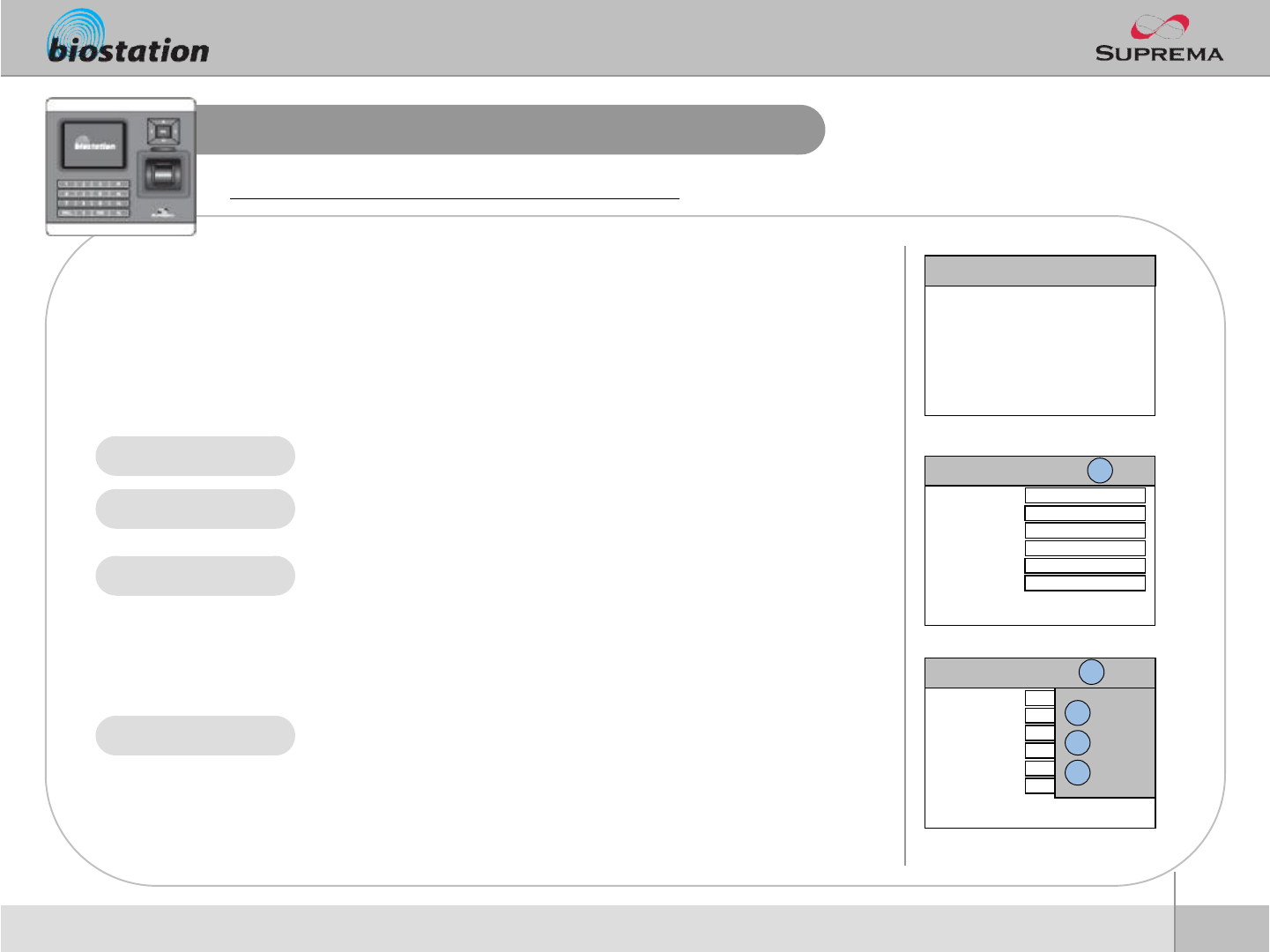
49
ⒸCopyright 2006 Suprema Inc.
Sub Zone
nTo add anti-passbackor entrance limit functions, Sub Zone should be created
in a Zone.
nIf you select Access Control on device menu and select Sub Zone,following
menus appear on display.
Change advanced access control settings –Sub Zone
lTo make a Sub Zone, the device should be a master (Node Type
of Zone menu). If the device is a member but not a master, only
“Device Auth”can be set in this menu.
lSelect an ID of a sub zone (from 0 to 15)
lSelect a sub zone type either “APB”or “Entrance Limit”.
lSelect a “Device ID”of a device to add in a sub zone. Then press
F1 and press F2 (Add).
lThen you can see the added device in “Device List”and the
increased number of the total devices in “Device Count”
lFor deleting, select the device in “Device List”and then press F1
and F3 (Delete).
lWhen the device is a member of a zone (Node Type of Zone is set
as “Device”), Device Auth menu can be set to determine whether
authentication decision is done by master or standalone
lSetting: Standalone/Notify/Deferred
lStandalone, Notify : decision made by device itself.
lDeferred : Zone master decides the authentication result.
For APB and Entrance Limit, select this option.
SubZoneID
Zone Type
Device ID/List/Count
For Administrators -Advanced Functions
Zone
Zone
Sub Zone
APB Zone
Entrace Limit Zone
Sub Zone
◀0 ▶
SubZone ID
Zone Type
Device ID
Device List
Device Count
Device Auth
◀5225 ▶
◀5225 ▶
◀ ▶
◀APB ▶
2
F1 More
Sub Zone
◀0 ▶
SubZone ID
Zone Type
Device ID
Device List
Device Count
Device Auth
◀5225 ▶
◀5225 ▶
◀ ▶
◀APB ▶
2
OK Apply
F2 Add
F3 Delete
F1 More
Device Auth
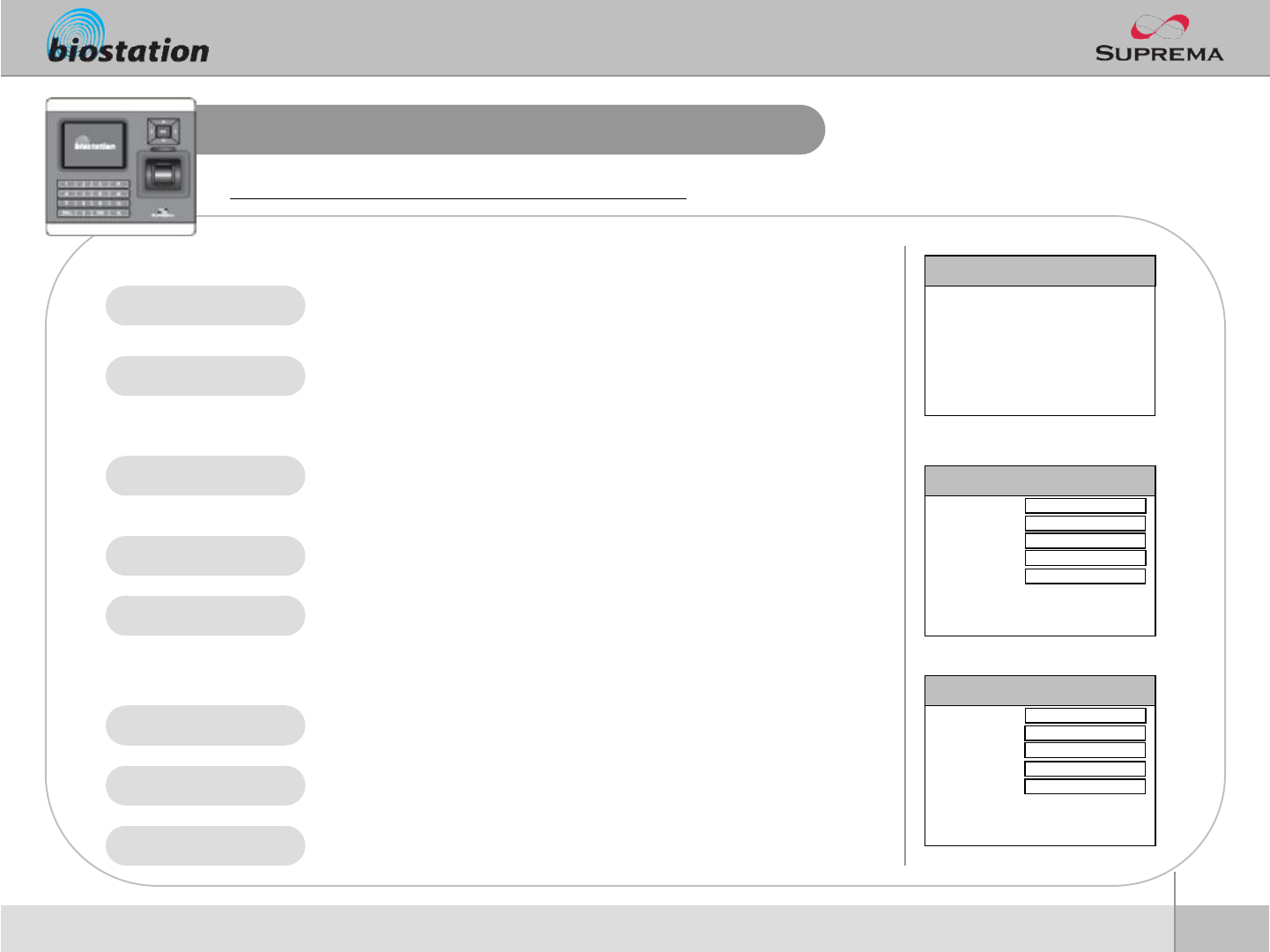
50
ⒸCopyright 2006 Suprema Inc.
APB Zone
nSelect APB Zone on Zone menu
nSelect Entrance Limit Zone on Zone menu
Change advanced access control settings –APB Zone
lSelect Sub Zone ID to make APB setting
lSetting: Disable/Hard/Soft
lIn “Hard”mode, relay does not work and log is recorded in case of
anti-passbackevents. In “Soft”mode, log is recorded burelay
works as usual.
lDuration(min) of automatic reset of APB for each user. If it is set
as 30(min), for example, APB record is erased for 30 minutes after
each authentication of users. If 0, there is no automatic reset.
lSelect a device for In and Out setting
lSelect IN or OUT for anti-passbackfunction of the selected device.
lOne who entered a room with authentication by IN devices must
go out by OUT devices.
lSelect Sub Zone ID to make APB setting
lInterval : Time period for re-authentication (min)
lTime Index : Select 4 different time periods per day
•Time : Set time period
•Count : Set max number of entrance during the period
For Administrators -Advanced Functions
SubZoneID
Reset Time
Zone
Zone
Sub Zone
APB Zone
Entrace Limit Zone
APB Zone
◀0 ▶
SubZone ID
APB Type
Reset Time
Device List
IN/OUT
◀5225 ▶
◀IN ▶
◀HARD ▶
0
APB Type
Device List
IN/OUT
SubZoneID
Time Index/Time/Count
Interval
Entrance Limit Zone
◀1 ▶
SubZone ID
Interval
Time Index
Time
Count
◀0 ▶
0
00:00~00:00
0
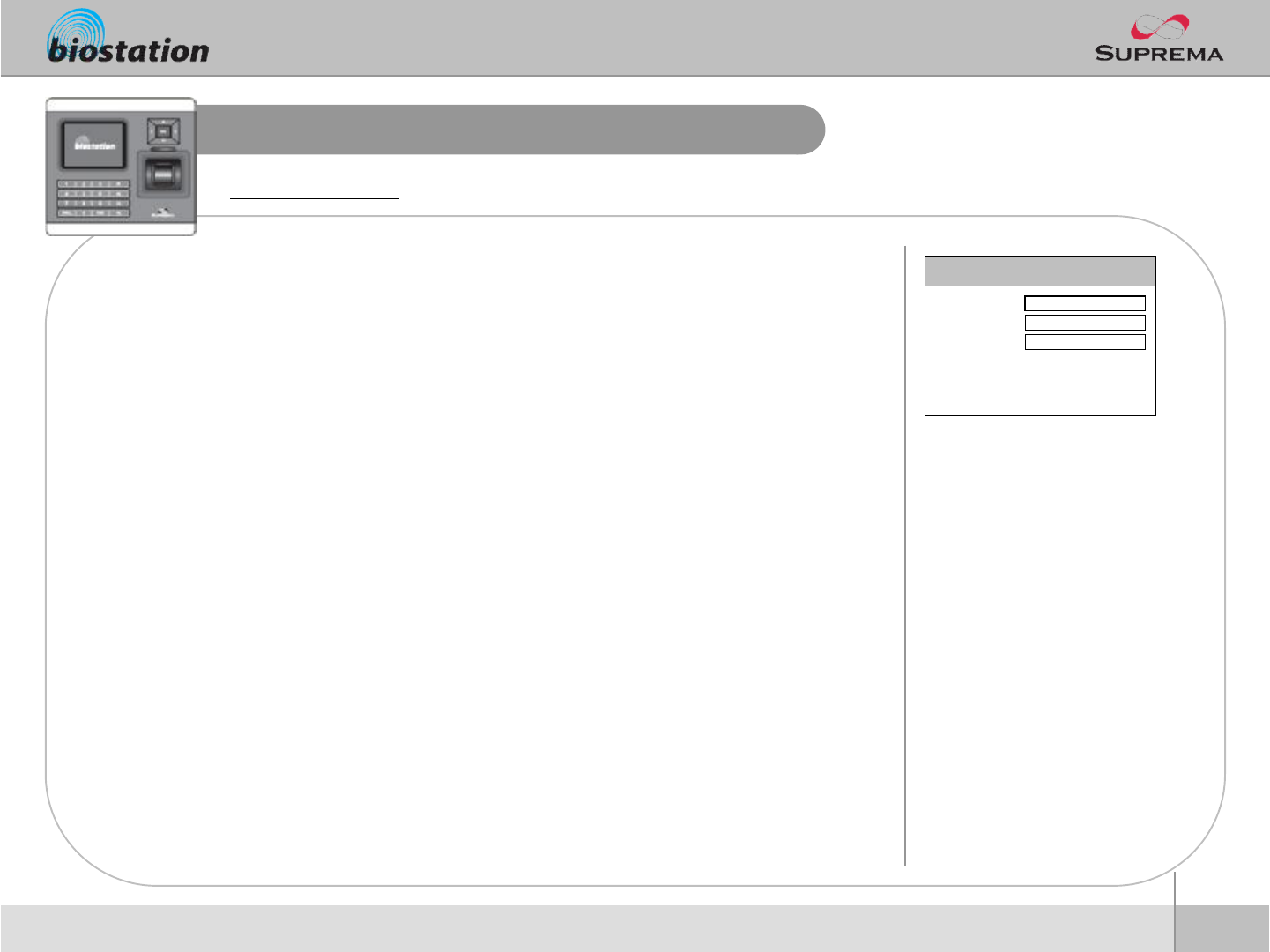
51
ⒸCopyright 2006 Suprema Inc.
Change Master Password
nIf you select Master Password on device menu, Master
Password menus appear on the display.
nEnter current master password to “Current”and a new master
password to “New”& “New (again)”. Then press OK key to
confirm.
lDefault password is blank (no need to type).
l[Note] With this master password, one can enroll or delete users
and change settings of BioStation. Please be careful not to disclose
master password except Administrators.
nWhen you forget master password
lIf there is a user enrolled as administrator : you can enter Admin
menu using administrator’s fingerprint and return the password as
blank by selecting the Factory Default on Device menu. However,
in this case, other settings of the device also return to defaults.
lIf there’s no user enrolled as administrator : contact the dealer you
purchased the device.
Master Password
Current
New
New(Again)
Change master PW.
For Administrators -Advanced Functions
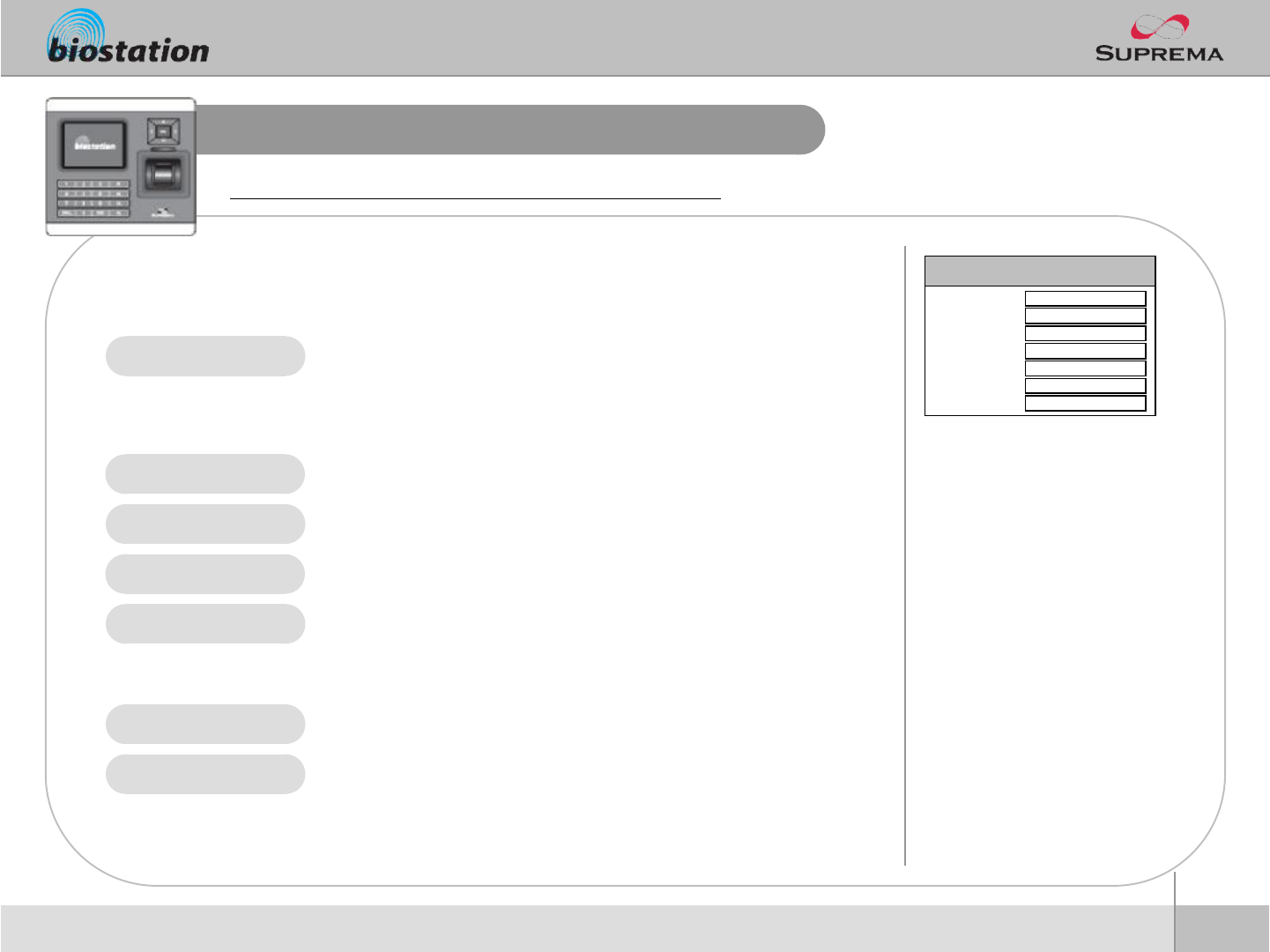
52
ⒸCopyright 2006 Suprema Inc.
View Device Info
nIf you select Device Info on device menu, following menus
appear on the display.
View device’s basic info such as model name and version.
lModel name is displayed according to types of fingerprint sensor.
lOptical sensor : BST-OC
lCapacitive sensor : BST-TC
lThermal swipe sensor : BST-FC
lDevice ID number is displayed.
lDevice’s Ethernet MAC address is displayed.
lDevice’s hardware version is displayed.
lDevice’s firmware version is displayed.
lFirmware and kernel can be upgraded using BioAdmin program
when new firmware is released.
lDevice’s Kernel ver. Info is displayed.
lOverall available storage and currently used storage are displayed.
lIn the internal memory of BioStation, various information like user
info, log, background and sounds are stored, so used memory
changes by the size of these information.
Model
Device ID
HW Version
Kernel Ver.
MAC
FW Version
Memory
Device Info
Standard
Model
Device ID
MAC
HW Version
FW Version
Kernel Ver.
Memory
1301
00:17:fc:10:05:15
Rev. E
V1.0
7/19 MB
For Administrators -Advanced Functions
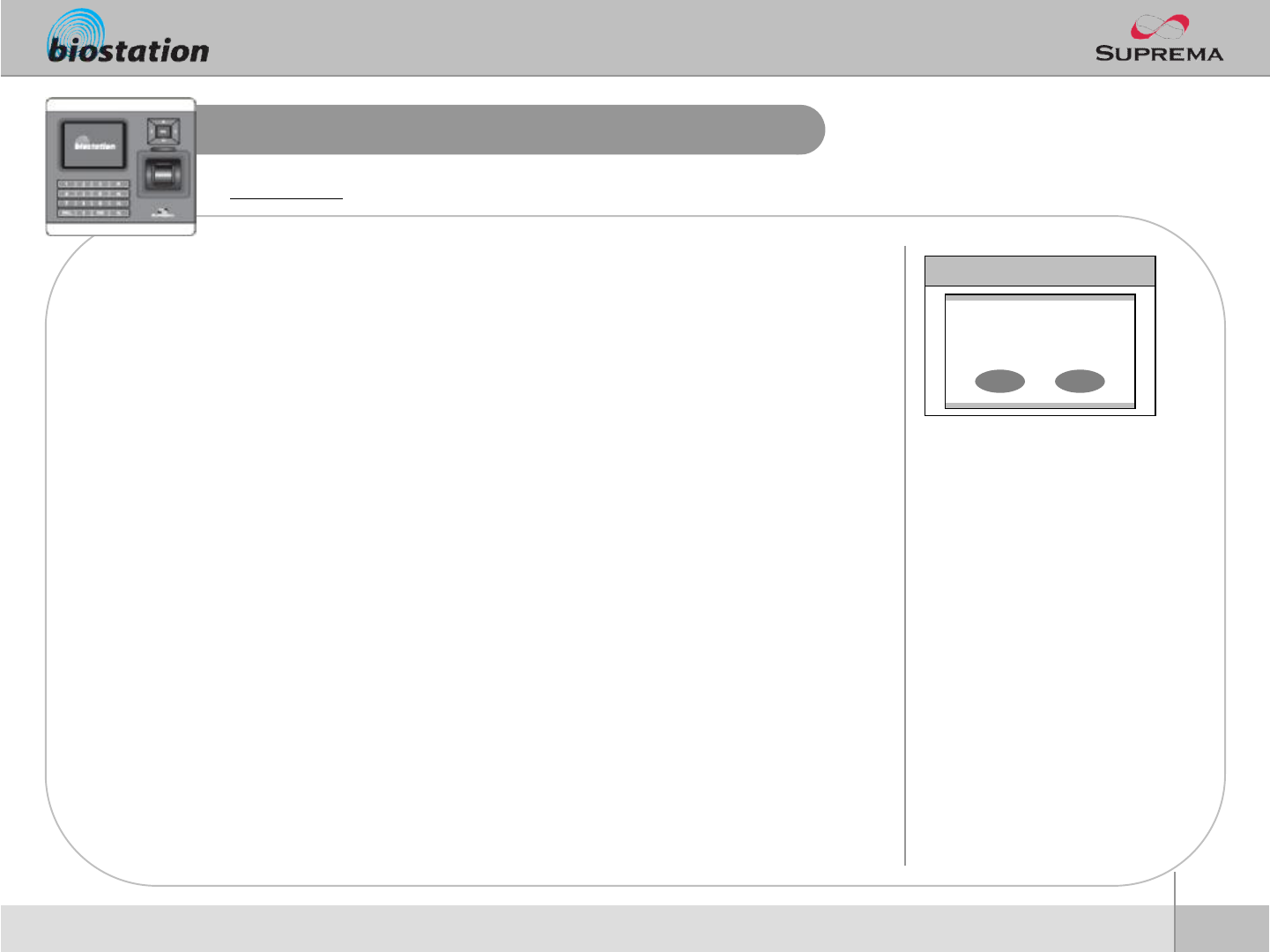
53
ⒸCopyright 2006 Suprema Inc.
Device Reset
nIf you select Device Reset on device menu, a message to restart
BioStation appears on the display.
nPress OK key to reset device. Device reset takes normally 20-30
seconds and it may take a bit longer for network connection.
nIf you change language of BioStation, you should reset
BioStation to apply the new language.
nIf device becomes unstable for any reason, in most of cases,
device reset can solve the problem.
Reset system.
Device Setup
Do you want to restart
BioStation?
OK ESC
For Administrators -Advanced Functions
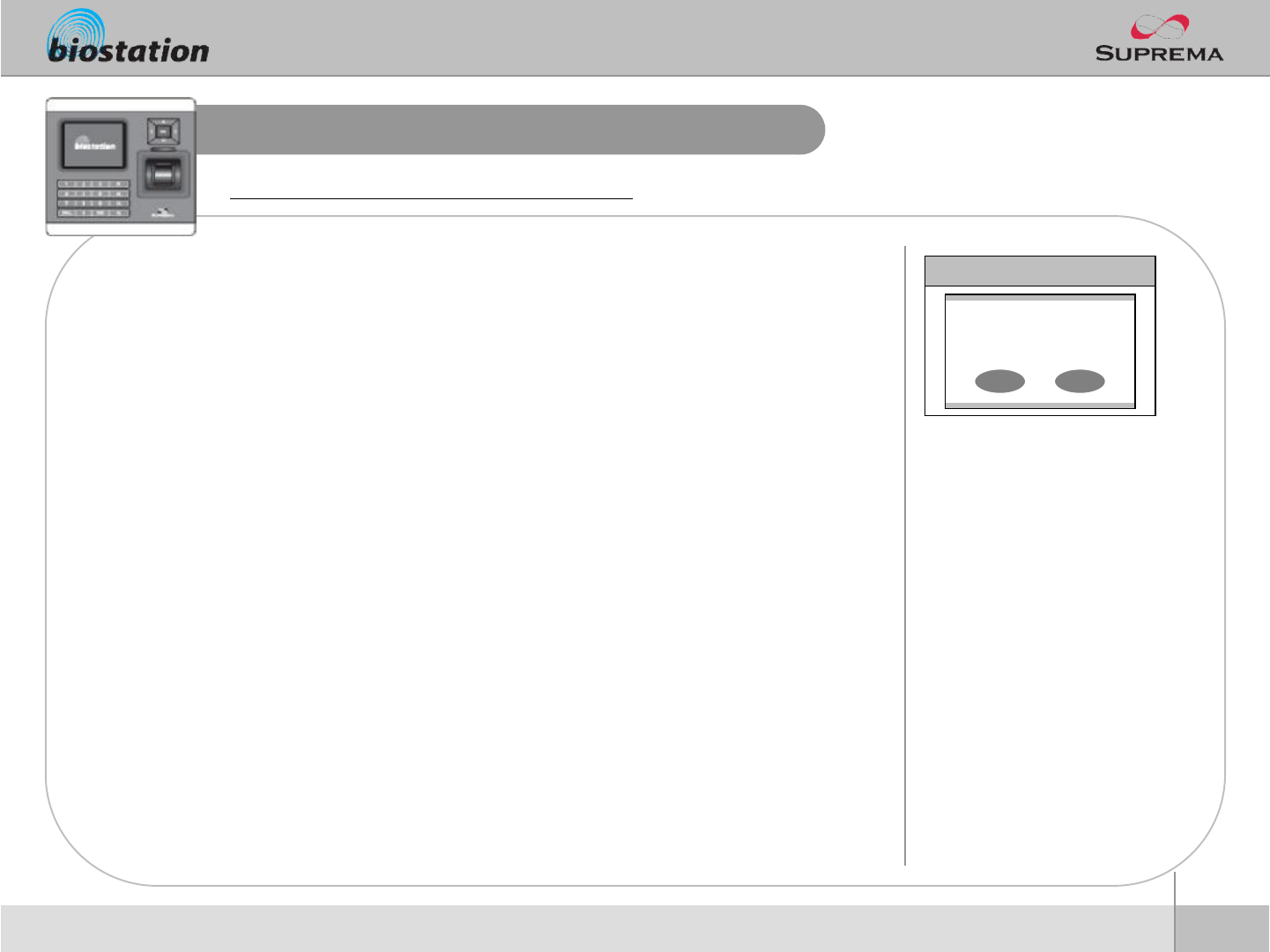
54
ⒸCopyright 2006 Suprema Inc.
Factory Default
nIf you select Factory Default on device menu, a message to
reset to default appears on the display.
nPress OK key to change system’s various settings as factory
defaults.
l[Note] Be sure that various settings, background, sounds and
notice will be deleted.
nUser info and log data are not deleted. To delete user info, refer
to <Delete All Users>. To delete log data, refer to <Delete Entire
Log>.
Restore device’s all settings to factory defaults.
Device Setup
Do you want to reset
to default?
OK ESC
For Administrators -Advanced Functions
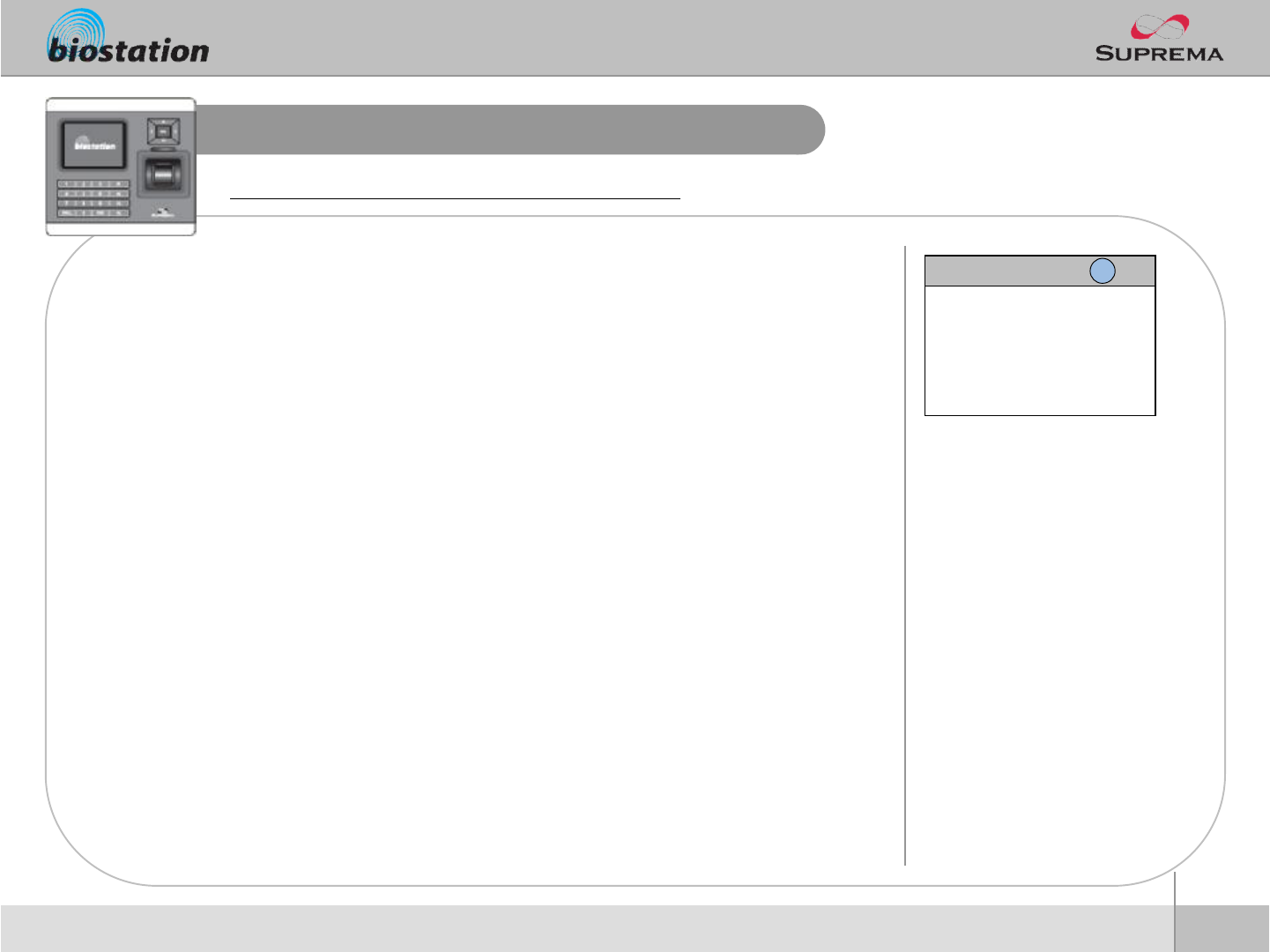
55
ⒸCopyright 2006 Suprema Inc.
Check Log
nIf you select Log on initial Admin menu, log events appear on
the display. You can check logs from the latest one.
nPress up/down navigation key to scroll a log one by one.
nPress left/right navigation key to scroll a log by page (8 logs).
nPress F1 key to display available additional function key.
lOK : Latest
lF2 : Filter
lF3 : Delete
nPress OK key to display the latest log.
Check logs for various events accumulated in device.
Log List
9/14 13:39 Duress (Menu) 123456
9/14 13:30 Identify OK (Menu) 1111
9/14 13:25 Duress (Menu) 123456
9/14 12:51 Identify OK (Menu) 1111
9/14 12:45 Duress (Menu) 123456
9/14 12:43 Identify OK (Menu) 1111
9/14 12:39 Duress (Menu) 123456
9/14 12:26 Identify OK (Menu) 1111
F1 More
For Administrators -Advanced Functions
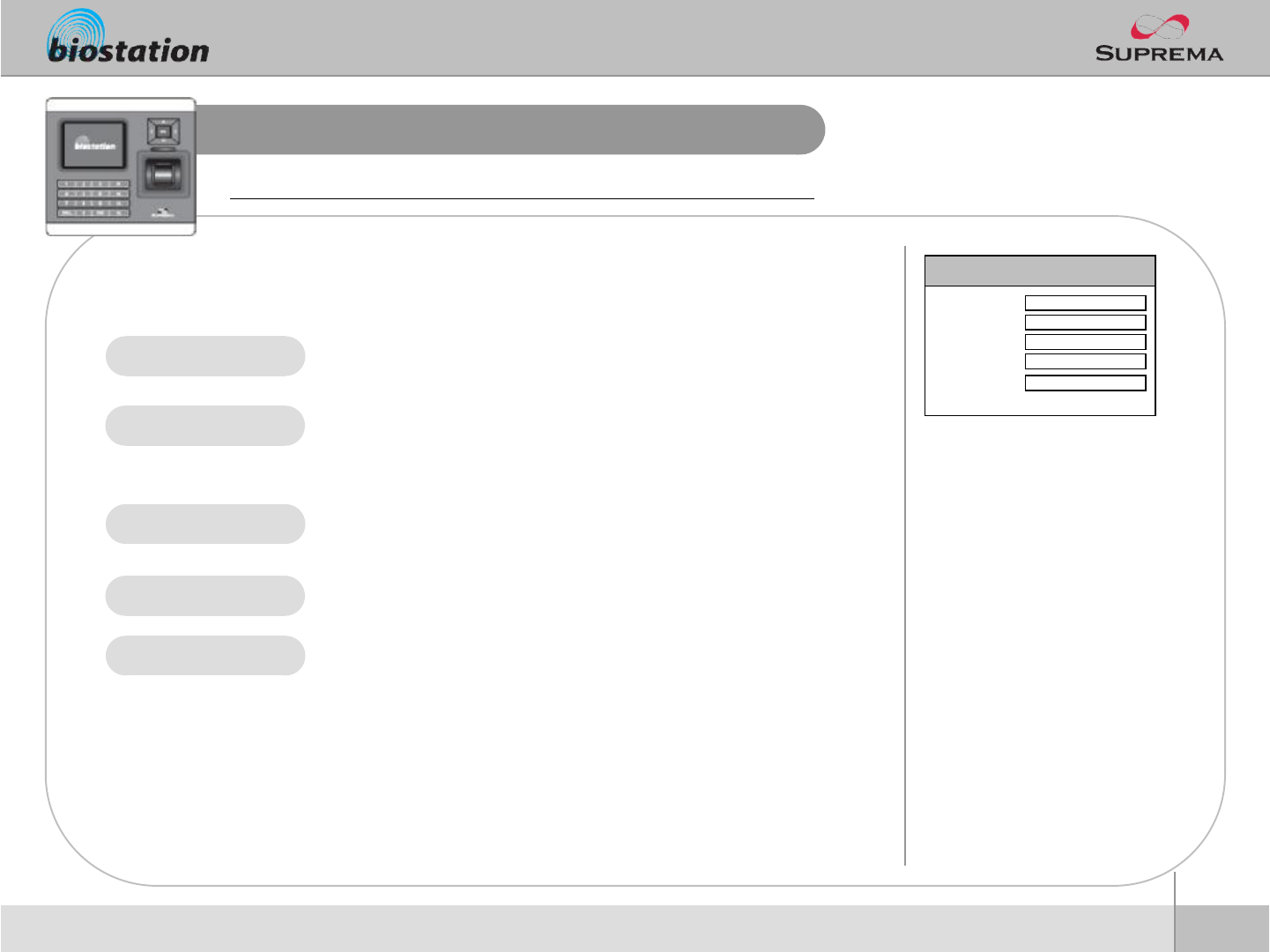
56
ⒸCopyright 2006 Suprema Inc.
Filter Log
nIf you press F2 key on Log menu, following menus appear on
the display.
Check specific log events by filtering the log events stored on device.
For Administrators -Advanced Functions
lSelect the filter ID.
lDevice can store up to 4 filters.
lSetting : All/Today/Yesterday/Last 3 days/Last 1 week/Last 1
month
lDesignate the time to filter.
lSetting : All/Success/Fail/IO/Duress/Tamper/System
lSelect the events to be shown on the log list.
lSelect the T&A events to be shown on the log list.
lTo check the log events of a specific user, enter the user’s ID. If
you press 0, log events of all users are displayed.
Filter ID
Time
T&A Event
Event
User
Filter
◁1 ▷
Filter ID
Time
Event
T&A Event
User
◀All ▶
◀All ▶
◀All ▶
0
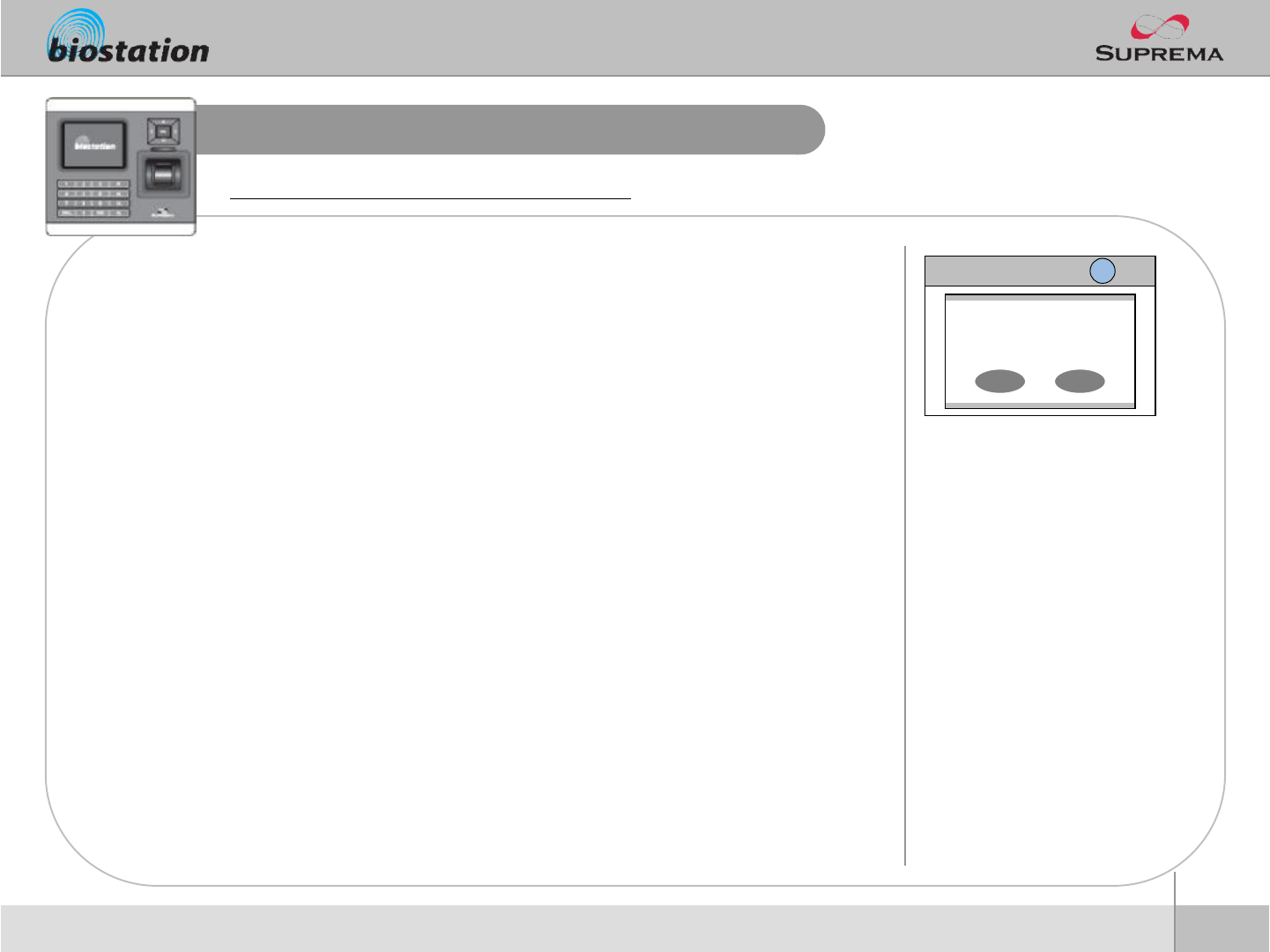
57
ⒸCopyright 2006 Suprema Inc.
Delete Entire Log
nIf you press F3 on log list screen, a message to delete all logs
appears on the display.
nPress OK key to delete all logs.
l[Note] Be sure that a deleted log can not be retrieved unless it
remains in BioAdmin program on PC.
Delete entire event logs accumulated in device.
For Administrators -Advanced Functions
Log List
Do you want to delete
all logs?
OK ESC
F1 More
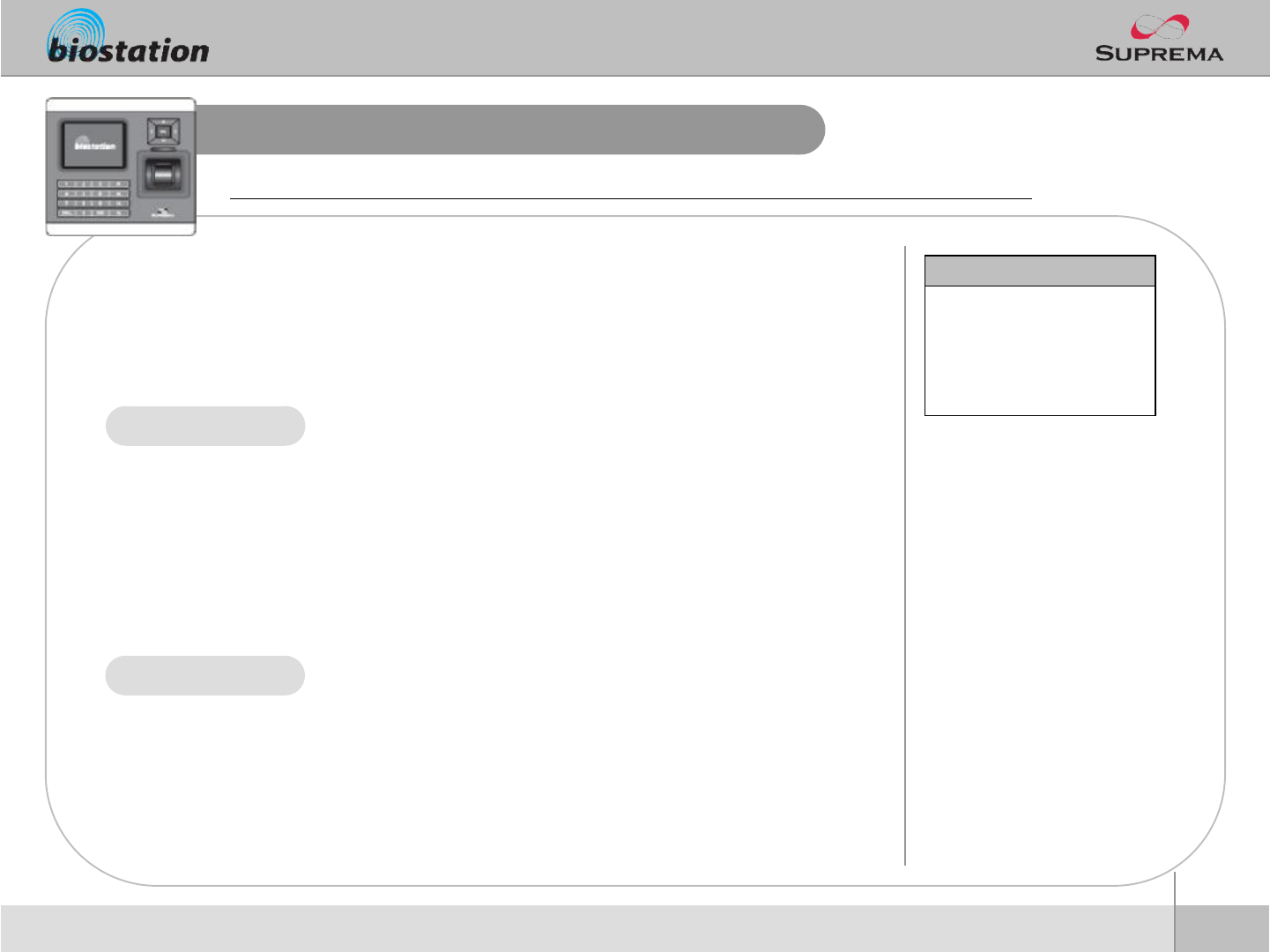
58
ⒸCopyright 2006 Suprema Inc.
USB Memory
nIf you select USB Memory on Network menu, following menus
appear on the display.
nWhen you are using wireless LAN, the wireless LAN is
automatically disconnected in this menu. When you go out of
this menu, wireless LAN is reconnected.
How to use USB memory to transfer user information, log data, and various settings of device.
For Administrators -Advanced Functions
lTransfer the user information and various settings from the virtual
terminal of USB memory to the connected BioStation. At the same
time, transfer the log data from the connected BioStation to the
virtual terminal of USB memory.
l[Note] Synchronize menu erases the current user information and
various settings of the device and overwrite with the information
and settings on USB memory.
lUseful in transferring the data from BioAdmin program to device.
lEnabled only when the USB memory has a virtual terminal with the
same device ID as that of the connected BioStation.
lCreate a virtual terminal on USB memory with the same device ID.
Export the user information, log data, and various settings of the
connected device to the virtual terminal on USB memory.
lIt may take a few minutes depending on the size of the user
information and log data to export.
lTo synchronize or import virtual terminal, you need to create a
virtual terminal first on the USB memory by using Export Virtual
Terminal menu.
lThis menu is enabled only when a USB memory is connected to
BioStation.
Synchronize
Export Virtual Terminal
USB Memory
Synchronize
Export Virtual Terminal
Import Virtual Terminal
Firmware Upgrade
Initialize
Refresh
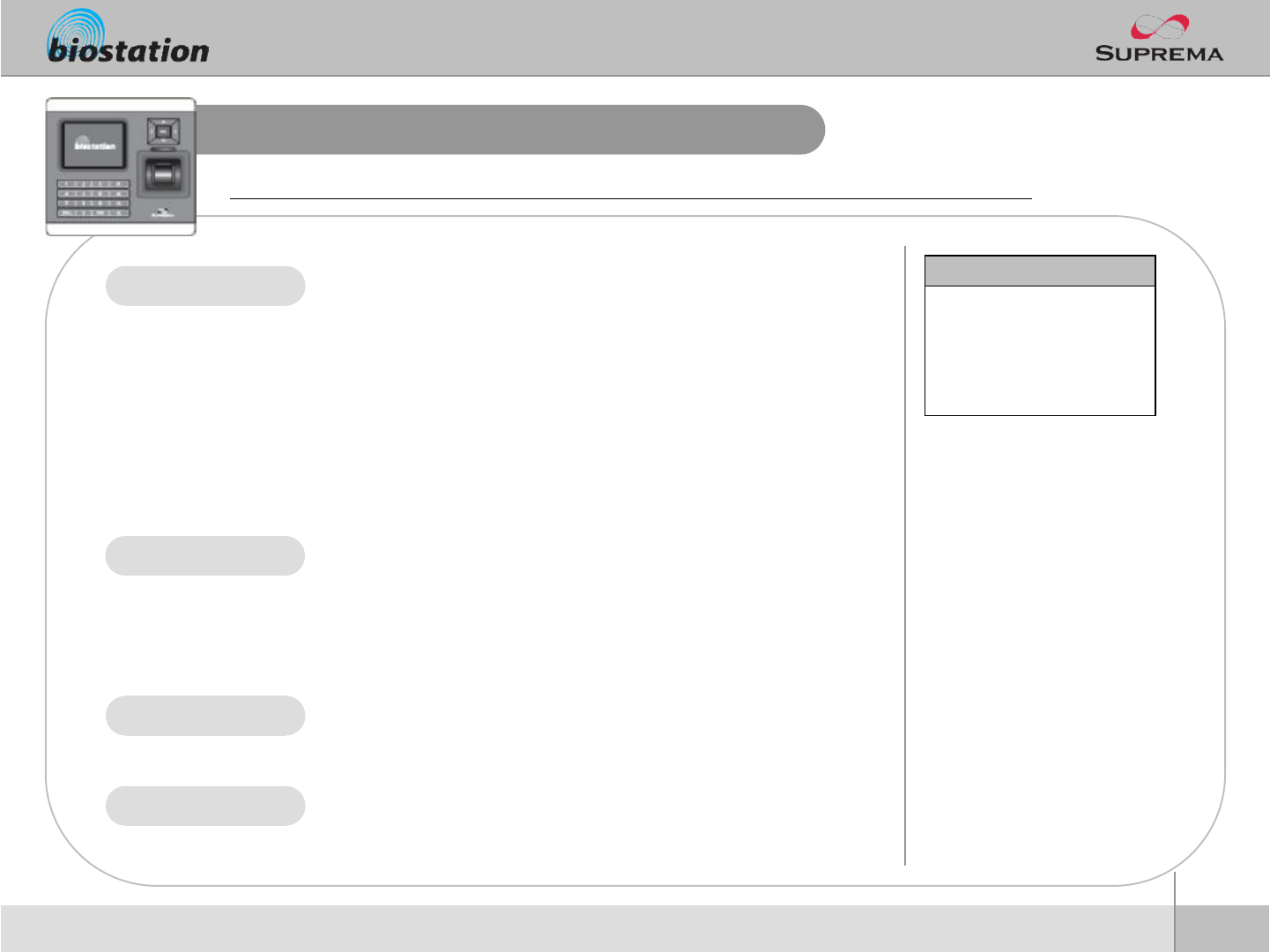
59
ⒸCopyright 2006 Suprema Inc.
USB Memory
How to use USB memory to transfer user information, log data, and various settings of device.
For Administrators -Advanced Functions
lApply the user information and various settings in USB memory to
the connected device.
lImport starts by selecting the an ID of the virtual terminals onUSB
memory.
l[Note] This menu erases the current user information and various
settings of the device and overwrite with the information and
settings on USB memory.
lUsed to transfer the user information and various settings from one
device to another.
lUseful in periodical back up and restoration of device information.
lThis menu is enabled only when the connected USB memory has
a virtual terminal.
lUpgrade the firmware of the connected device with the firmware
file stored on USB memory.
lFirmware upgrade starts by selecting one of the firmware files
stored on the root directory of USB memory.
lUpon finishing the firmware upgrade, device automatically restarts.
lThis menu is enabled only when a firmware file exists in the root
directory of USB memory.
lDelete all virtual terminals on USB memory.
lThis menu is enabled only when a USB memory is connected to
BioStation.
lRefresh the connection of the USB memory and the stored
information on the connected USB memory.
Import Virtual Terminal
Firmware Upgrade
Initialize
Refresh
USB Memory
Synchronize
Export Virtual Terminal
Import Virtual Terminal
Firmware Upgrade
Initialize
Refresh
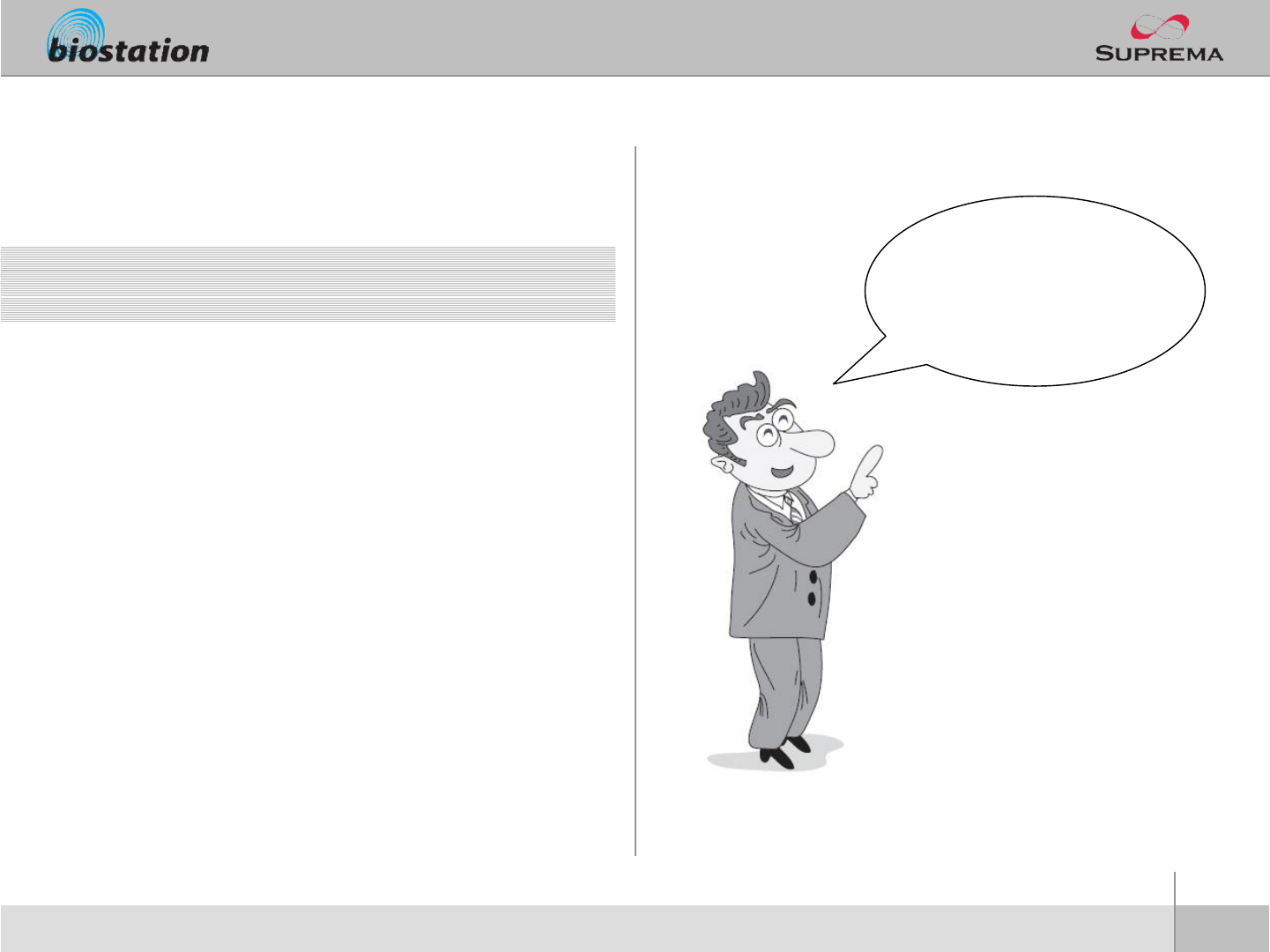
60
ⒸCopyright 2007Suprema Inc.
For General Users
Describes directions for
general users. It explains
how to open a door in each
operation mode and to enter
T&A events.
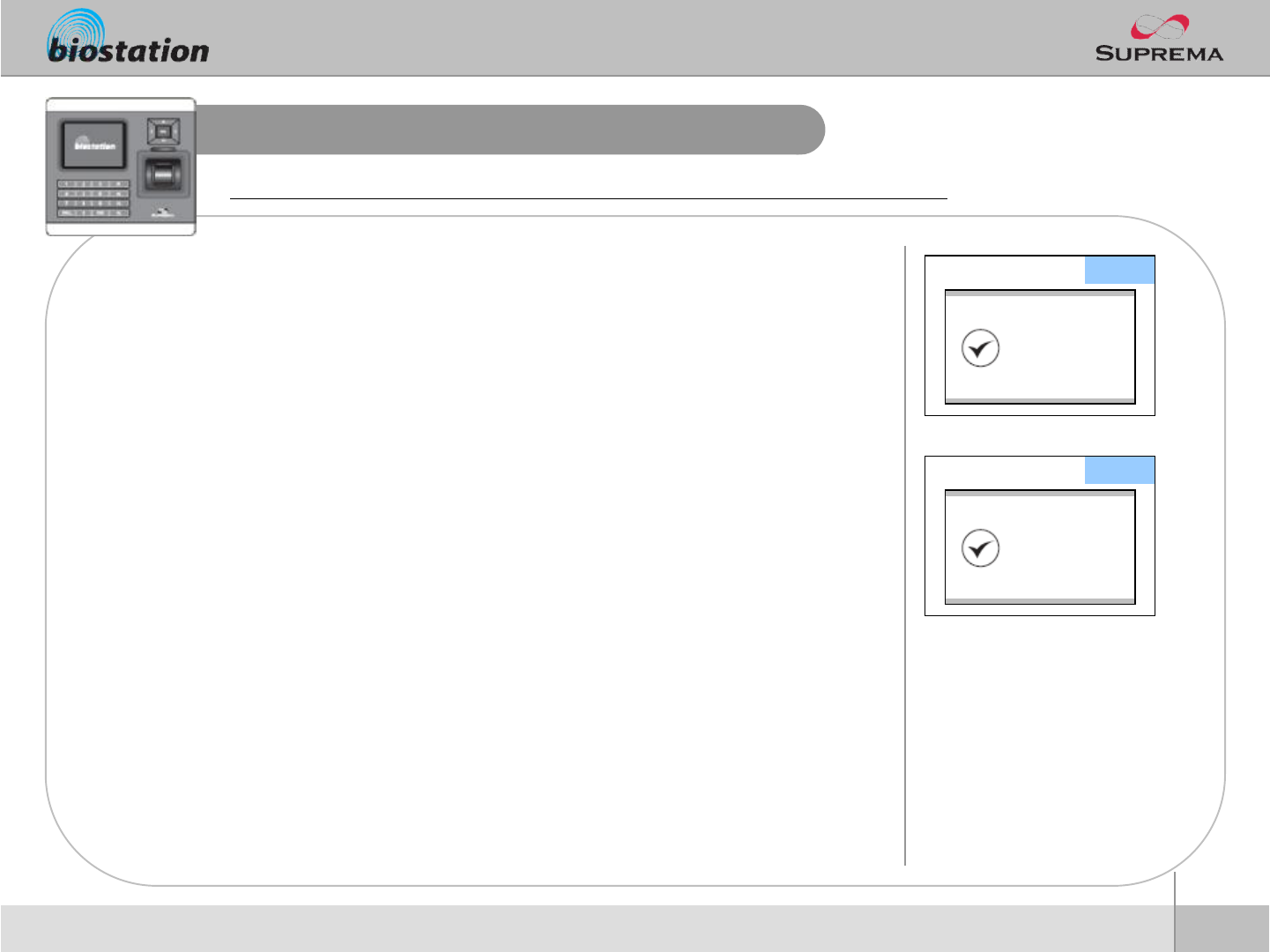
61
ⒸCopyright 2006 Suprema Inc.
Access using 1:N mode
nWhen 1:N mode is set as Auto
lIf you enter a fingerprint without pressing any key, a message
showing the identification result appears and door is opened.
nWhen 1:N mode is set as OK/T&A key
lIf you press OK or T/A key, blue LED flickers and a message
requesting user’s fingerprint appears on the display.
lPlace a finger to open the door.
nUse of personal info
lWhen personal info image and message are set, the set image and
message by successful authentication will be shown.
How to open a door using fingerprint when 1:N mode is set as Auto or OK/T&A key.
▼T&A
Welcome!
Tommy
▼T&A
Authentication
Place your finger
For General Users
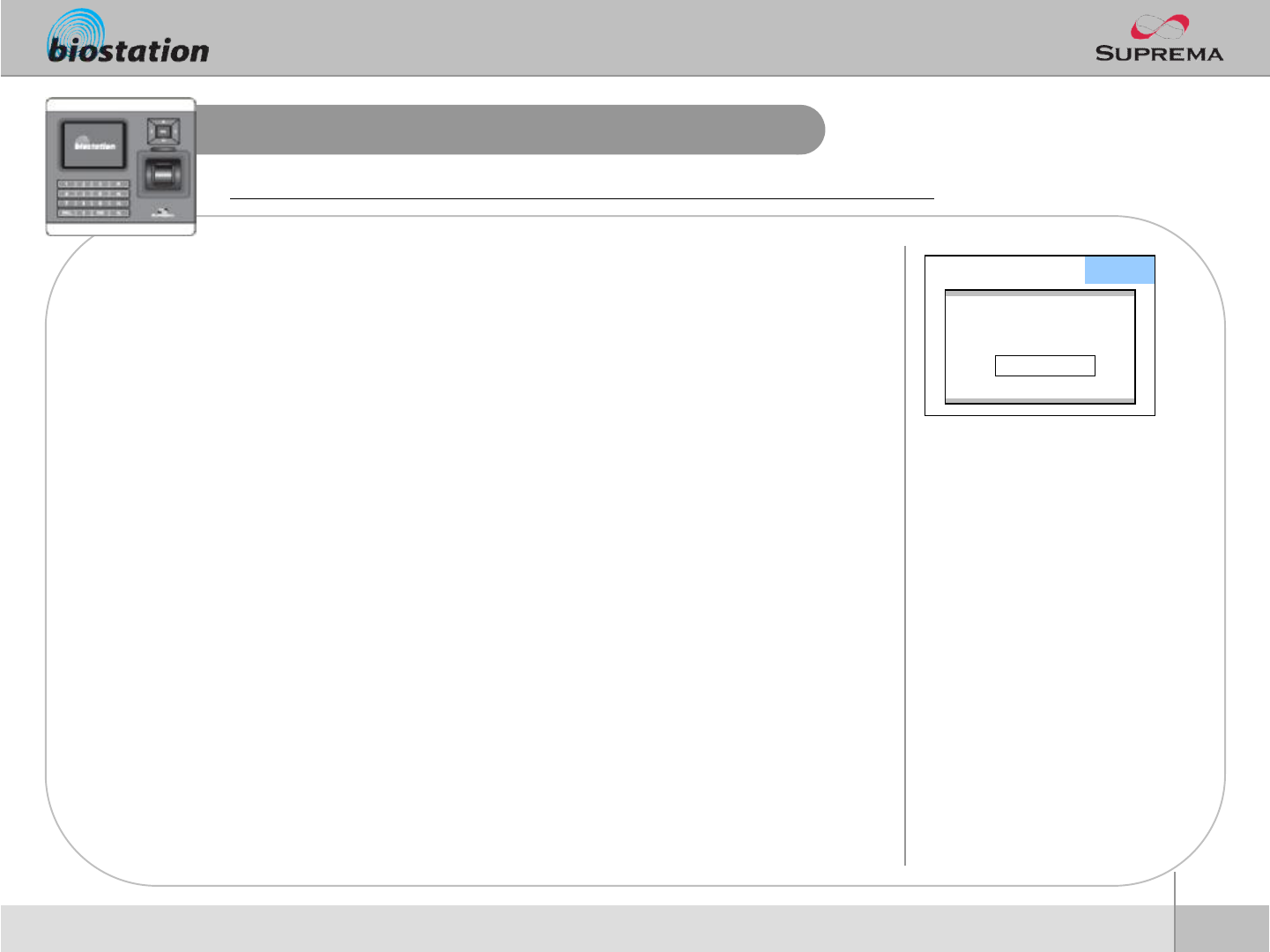
62
ⒸCopyright 2006 Suprema Inc.
Access using 1:1 mode
nIf you press a numeric key, ID input window appears.
nEnter your ID and press OK key.
nIn case 1:1 mode is set as Fingerprint Only
lEnter a fingerprint to open the door.
nIn case 1:1 mode is PIN Only
lEnter your password and press OK key to open the door.
nIn case 1:1 mode is set as Fingerprint or PIN
lYou can either enter a fingerprint or enter password and press OK
key.
nIn case 1:1 mode is set as RF Card
lIf the 1:1 mode is set as Card Only, user can access just by placing
the card to BioStation without any additional procedure.
lIf the 1:1 mode is not set as Card Only, card is used to suggestthe
user’s ID. After putting the card, user should verify himself with
fingerprint or password.
How to open a door by entering ID first and then entering fingerprint or password.
▼T&A
User ID
1234
For General Users
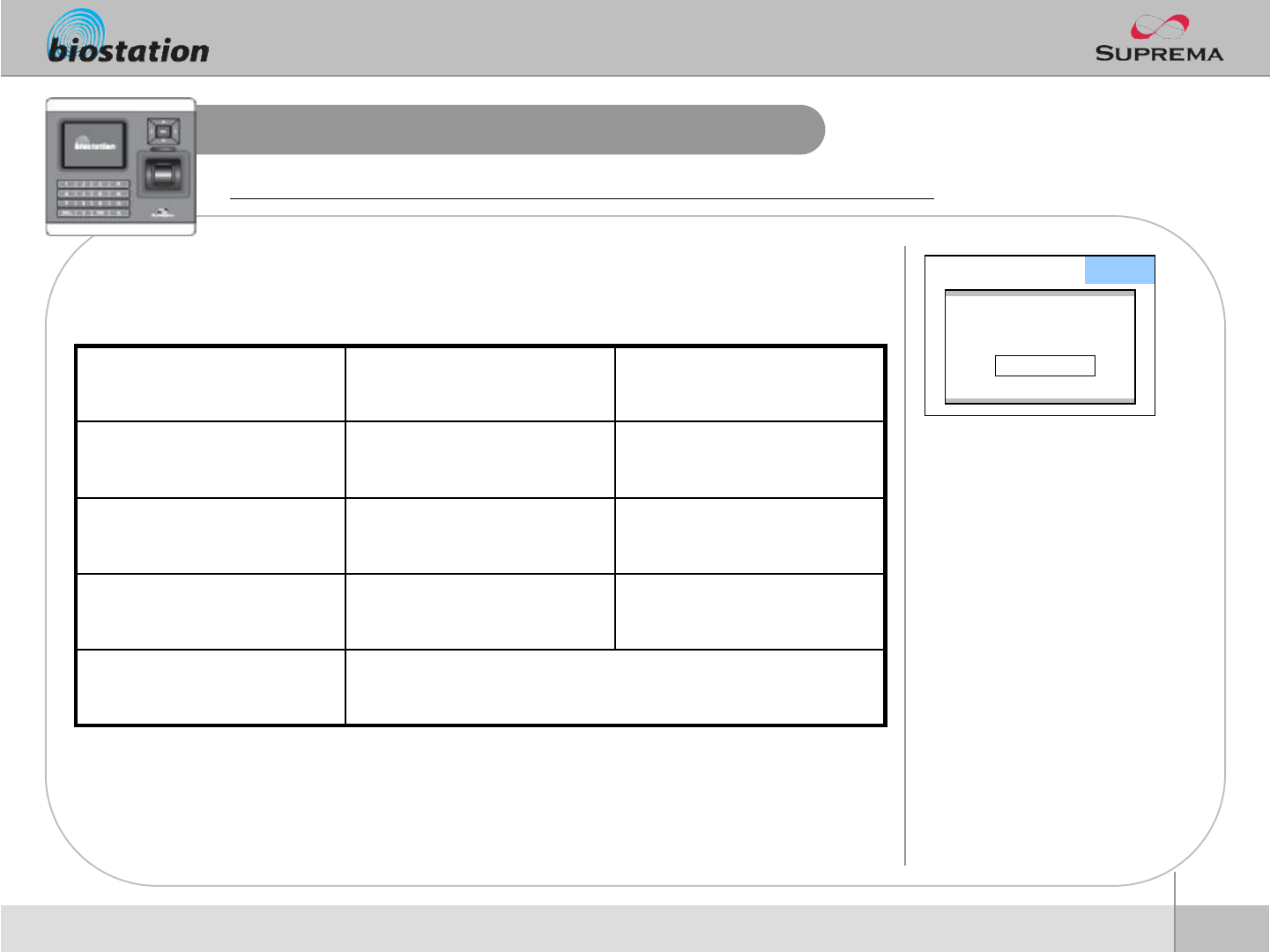
63
ⒸCopyright 2006 Suprema Inc.
Access using 1:1 mode
How to open a door by entering ID first and then entering fingerprint or password.
▼T&A
User ID
1234
For General Users
Put the CardCard Only
Enter passwordEnter user ID or
put the card
Password Only
Put fingerEnter user ID or
put the card
Fingerprint Only
Put finger or
enter password
Enter user ID or
put the card
Fingerprint or password
How to authorizeHow to suggest user ID1:1 verification
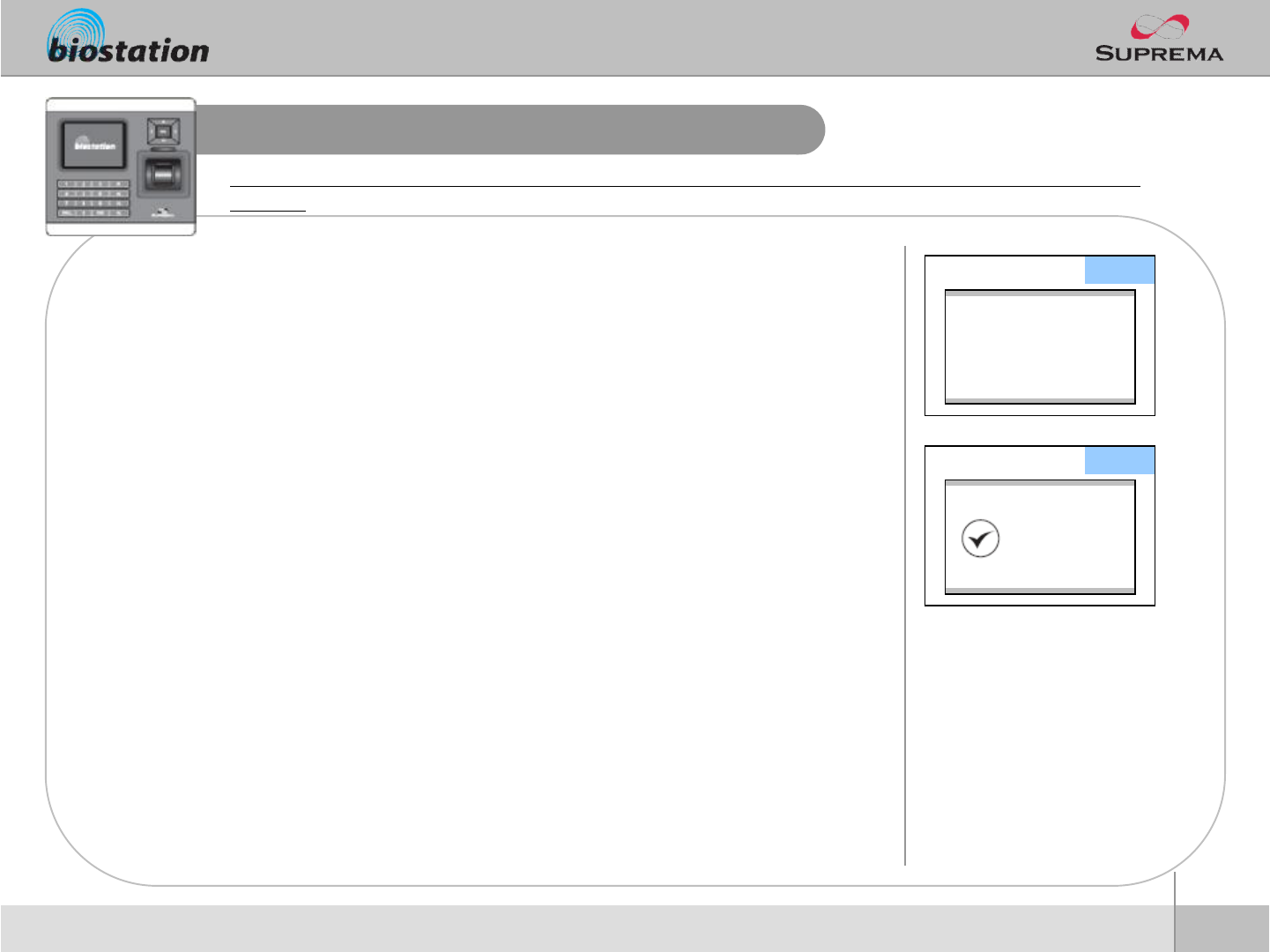
64
ⒸCopyright 2006 Suprema Inc.
T&A event using 1:N mode
nIf you press F1~F4 key, blue LED flickers and a message
requesting user’s fingerprint appears on the display.
nIf you place a finger, designated T/A event appears on the
display and applies to the user.
nIn case that ‘Driven by’on the door relay menu is set as
‘Selected T&A’and that ‘Activate Relay by this Event’is
checked on the BioAdmin program, a door opens upon the
occurrence of the T&A events.
nYou can check on ‘Activate Relay by this Event’in T&A event
with BioAdmin program on your PC.
How to enter T&A events with fingerprint when 1:N mode is set asAuto or OK/T&A key, and T&A is set as
Enabled.
▼T&A
T&A: In
Place your finger
▼T&A
In: Tommy
8/1(Tue) AM 8:00
For General Users
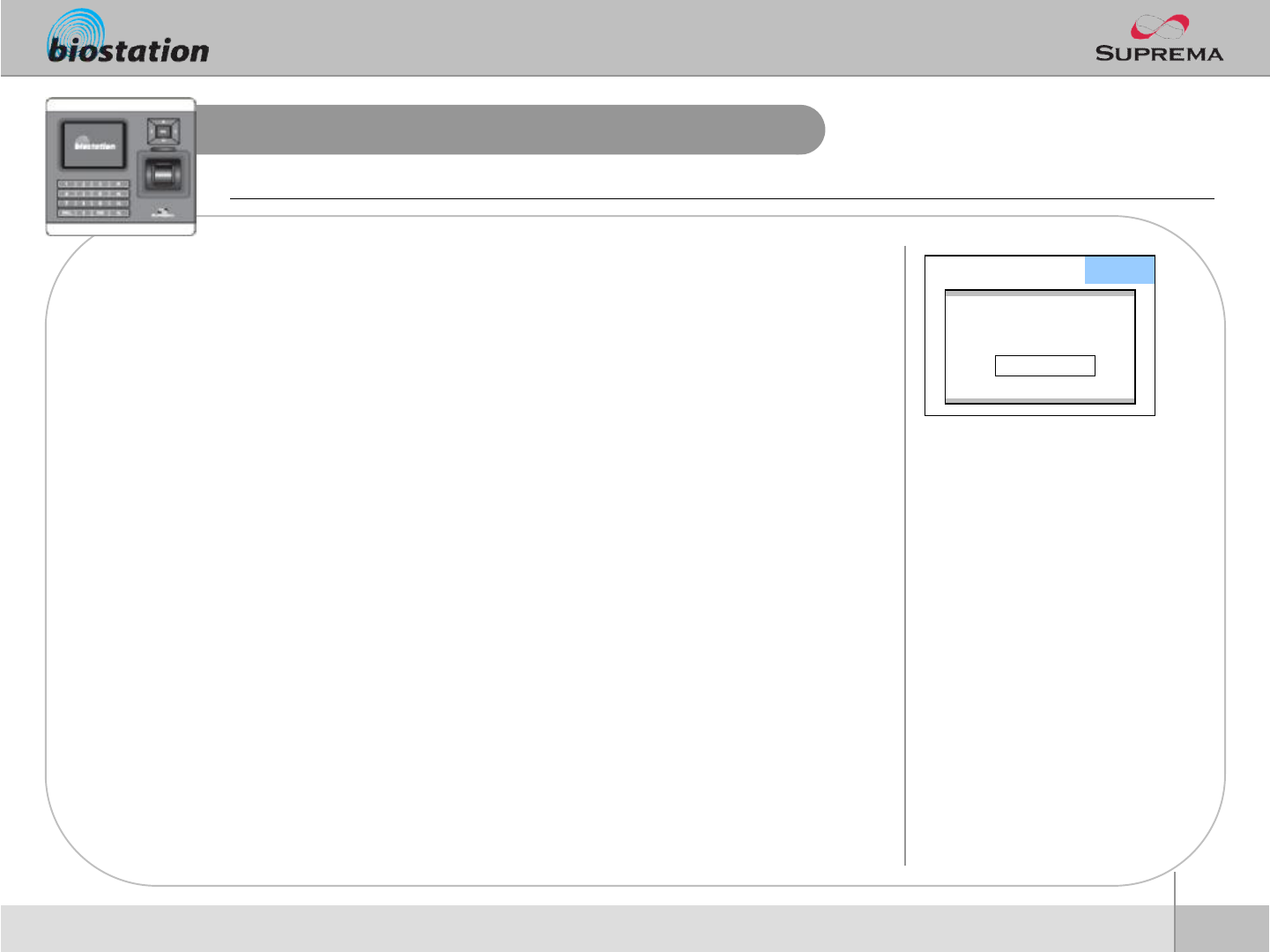
65
ⒸCopyright 2006 Suprema Inc.
T&A event using 1:1 mode
nIf you press a numeric key, ID input window appears on the
display.
nEnter your ID and press F1~F4.
nIn case 1:1 mode is set as Fingerprint Only
lEnter fingerprint to apply applicable T&A event.
nIn case 1:1 mode is set as PIN Only
lEnter your PW and press OK key to apply applicable T&A event.
nIn case 1:1 mode is set as Fingerprint or PIN
lYou can either enter fingerprint or enter password and press OK
key.
How to enter T&A event by first entering ID and then entering fingerprint or password when T&A is set as enabled.
▼T&A
User ID
1234
For General Users
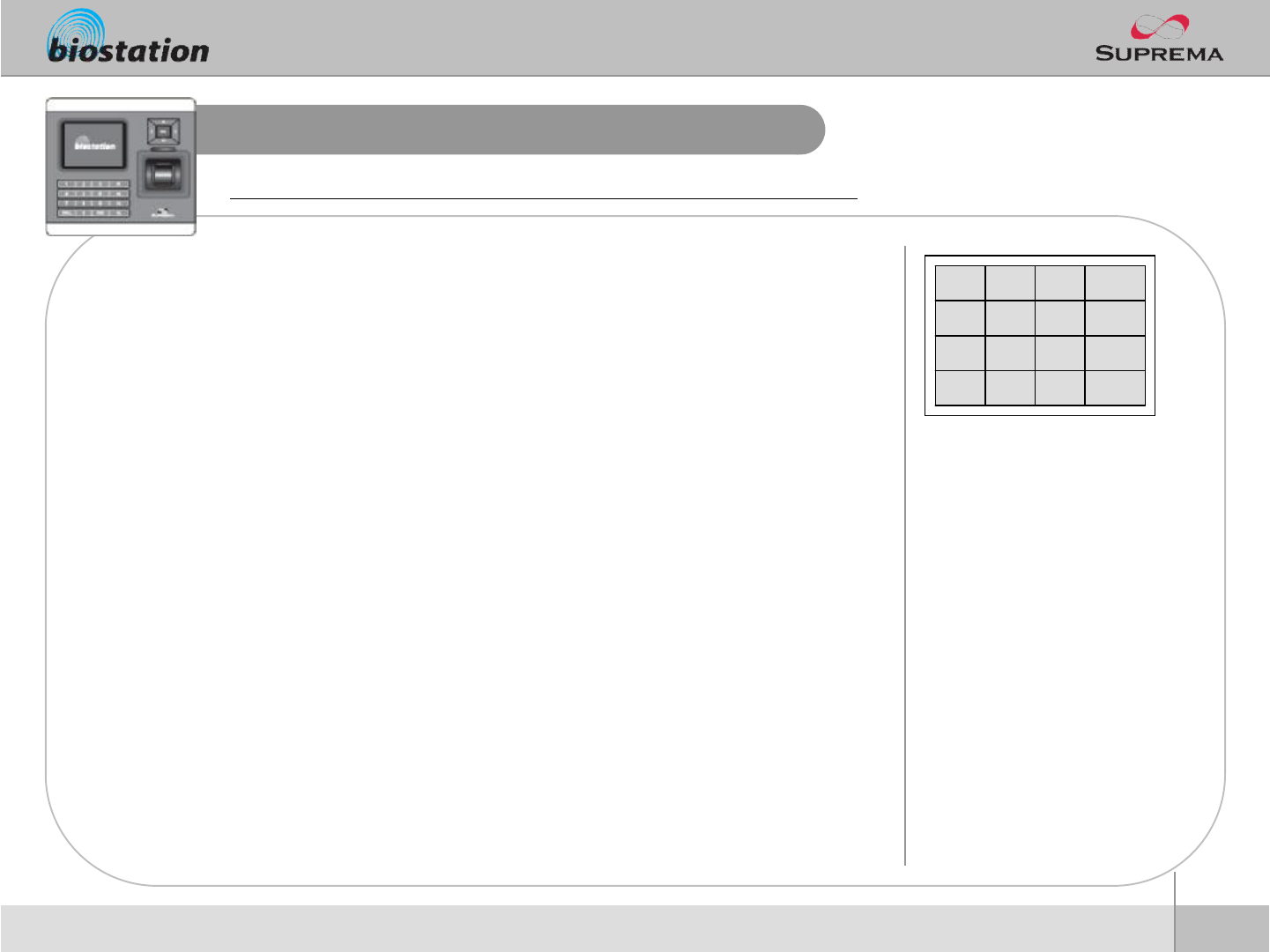
66
ⒸCopyright 2006 Suprema Inc.
Using extended T&A events
nIf you press down navigation key, extended T&A events info
appears on the display.
nIf you press one of 16keys corresponding to the desired T&A
event, next operation starts for the extended T&A event.
nFactory default T&A events are defined as below.
lF1 (In), F2 (Out), F3 (In duty), F4 (Out duty)
nYou can edit the default T&A events and extended T&A events
with BioAdmin program on your PC.
In case of using 4 or more T&A events, you can use extended T&A events.
F4ESC0CALL
F3987
F2654
F1321 In
Out
In duty
Out duty
For General Users
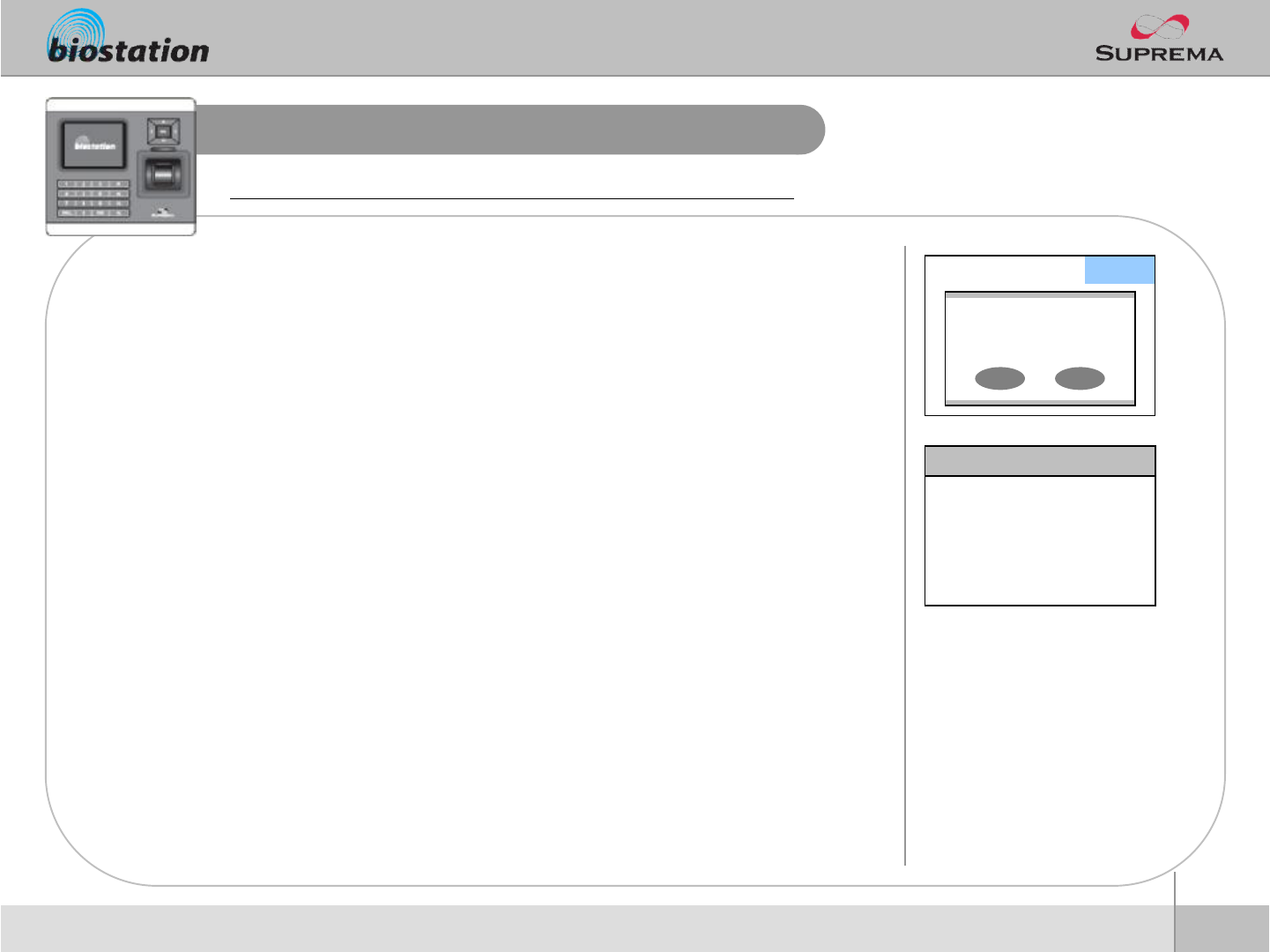
67
ⒸCopyright 2006 Suprema Inc.
View user’s Access/T&A event records
nIf you press ESC key on initial screen, a message requesting
user fingerprint or password appears on the display.
nIf user enter his/her fingerprint or password, access and T&A
event records displays as below.
nPress up/down navigation key to scroll a log one by one.
nPress left/right navigation key to scroll a log page by page
(8 logs).
nPress OK key to display the latest log.
General users can check their own access and T&A event records.
Admin fingerprint or
master password
OK ESC
▼T&A
User Log: 123456
9/14 13:39 Duress (Menu) 123456
9/14 13:30 Identify OK (Menu) 1111
9/14 13:25 Duress (Menu) 123456
9/14 12:51 Identify OK (Menu) 1111
9/14 12:45 Duress (Menu) 123456
9/14 12:43 Identify OK (Menu) 1111
9/14 12:39 Duress (Menu) 123456
9/14 12:26 Identify OK (Menu) 1111
For General Users
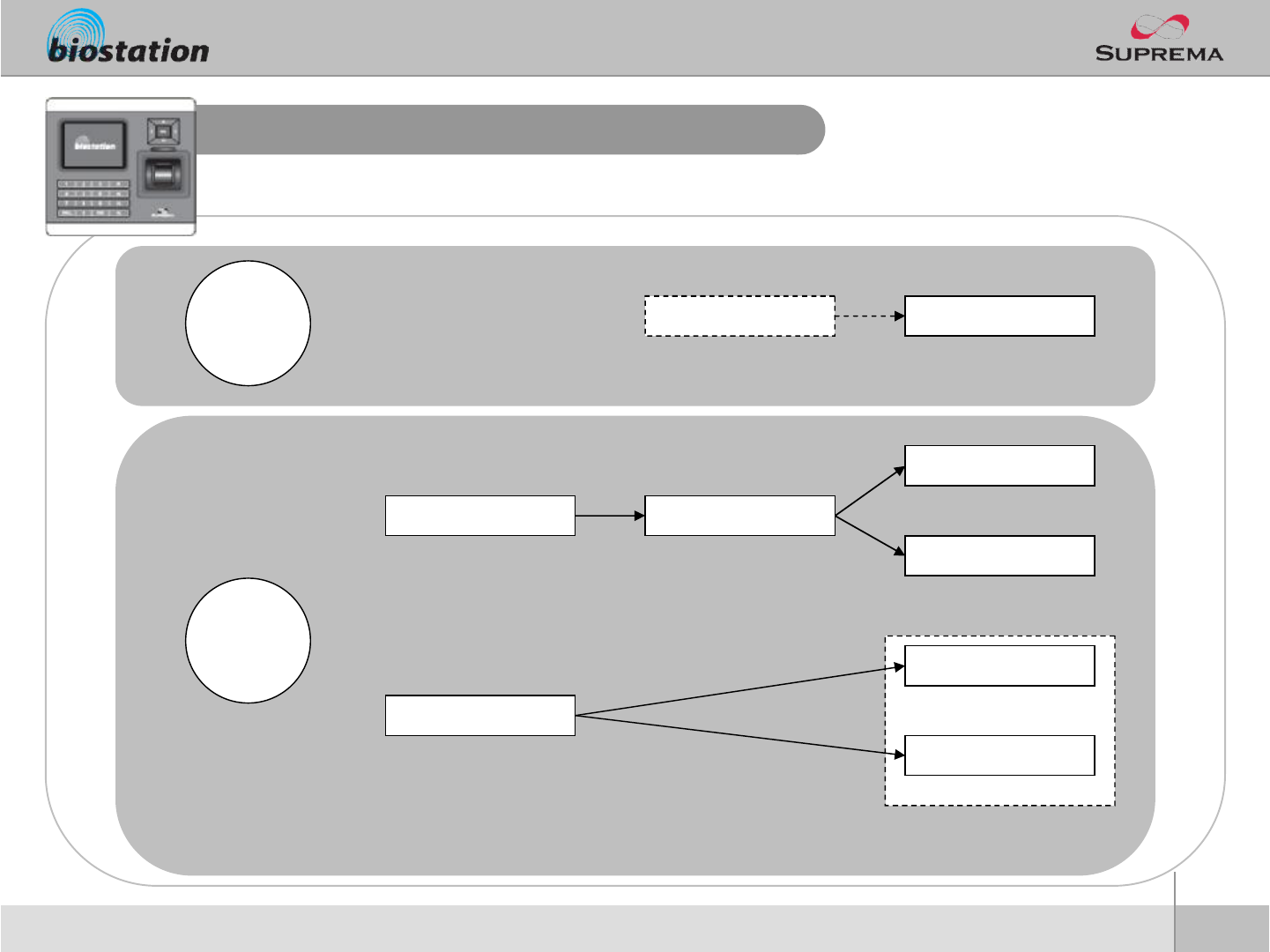
68
ⒸCopyright 2006 Suprema Inc.
1:1 Mode
1:N Mode
Authentication procedure as per operation mode
ID (Key)
fingerprint
OK
(auth. PW)
PW+OK
(finger scan)
fingerprint
(skip in case of Auto setting)
OK
For General Users
Card
(auth. PW)
PW+OK
(finger scan)
fingerprint
(skip in case of card only)
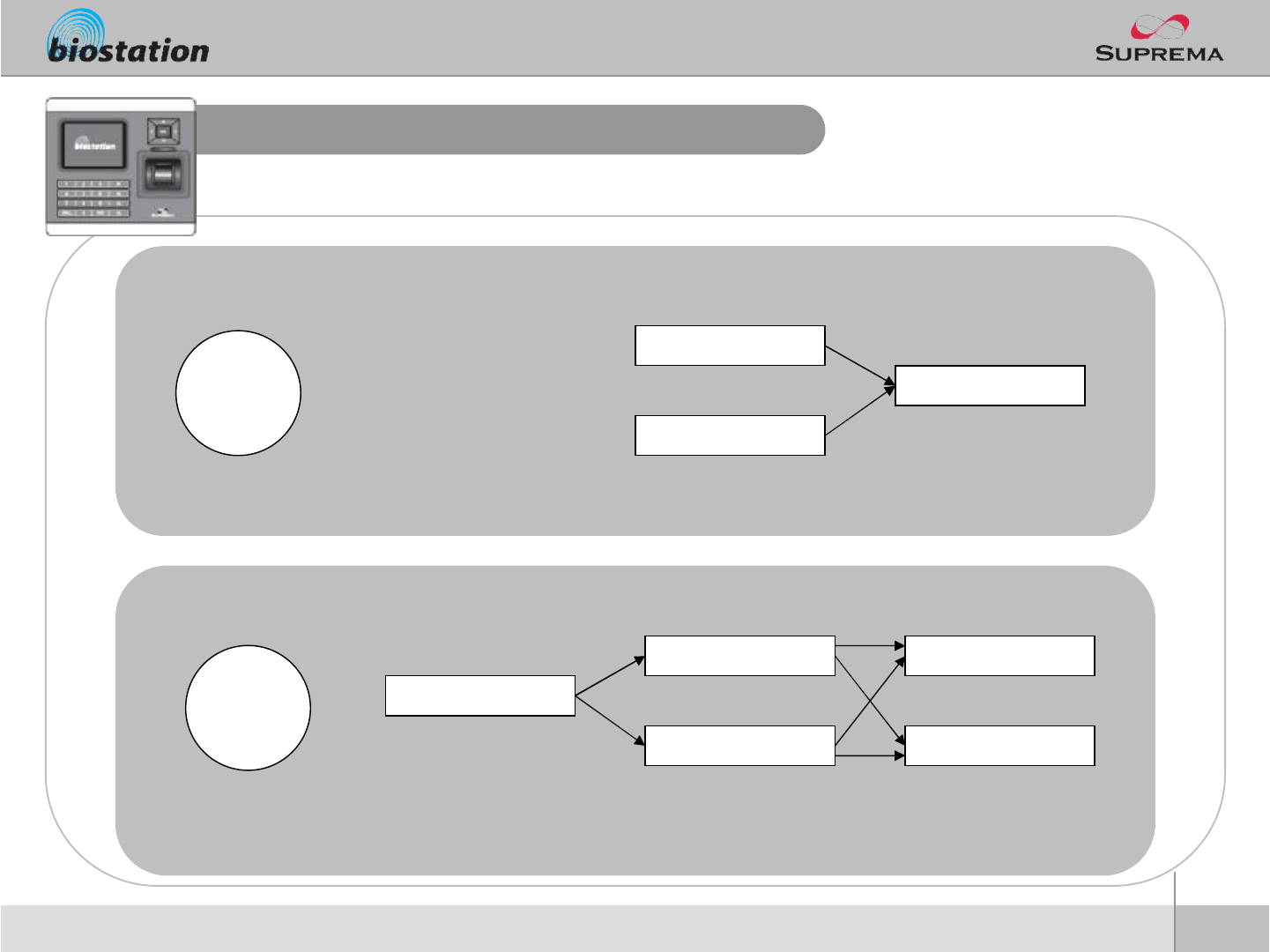
69
ⒸCopyright 2006 Suprema Inc.
1:1 Mode
1:N Mode
Authentication procedure for T&A event
fingerprint
(extended T&A event)
Down key+16key
(default T&A event)
F1~F4
For General Users
ID (Key)
(extended T&A event)
Down key+16key
(default T&A event)
F1~F4
(auth. PW)
PW+OK
(finger scan)
fingerprint
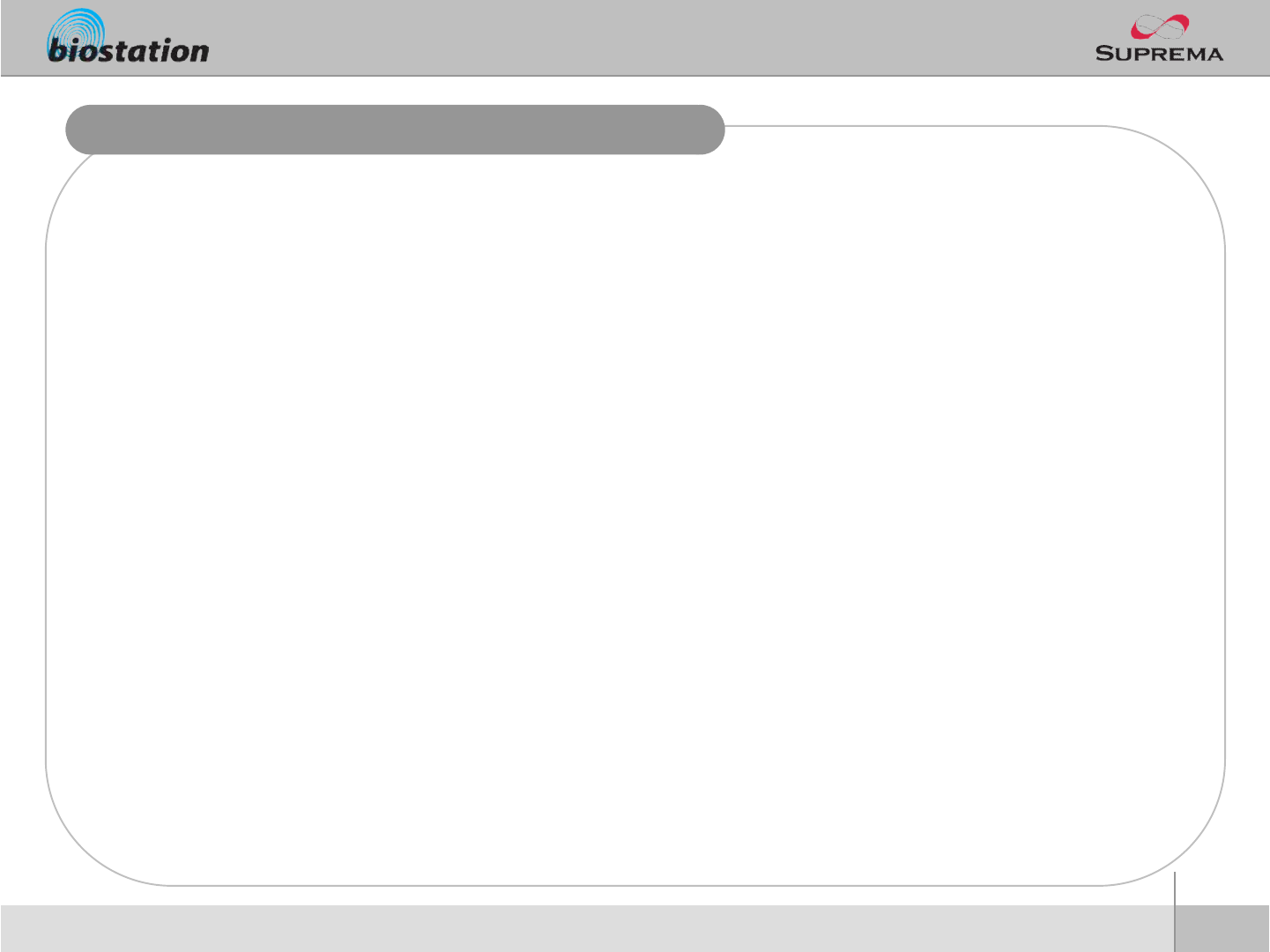
70
ⒸCopyright 2006 Suprema Inc.
Specifications
nCPU : Dual CPU (32 bit RISC + 400MHz DSP)
nMemory : 72MB flash + 34MB RAM
nDisplay : 2.5 inch QVGA 16 million color LCD
nIdentification speed :3,000 fingerprints in 1 second
nFingerprint capacity : 50,000 fingerprint templates
nLog capacity : 500,000 events
nHost interface : Wireless LAN (optional), TCP/IP, RS485
nPC interface : USB, RS232
nUSB memory slot : USB host
n1 relay for deadbolt, EM lock, door strike, or automatic door
nWiegand input/output, 4 TTL input/output
nBuilt-in microphone and speaker supporting door phone
nConvenient menu navigation key
n4 function keys for user defined functions
nOperation mode : Fingerprint, PIN, PIN+Fingerprint,
nCard only*, Card+Fingerprint*, Card+PIN* (*RF model only)
nRF Card : 125KHz proximity (EM, HID model only), 13.56MHz Mifare(Mifaremodel only)
nRTC with backup battery (CR2032)**
nProduct size : 135 x 128 x 50 mm (width x length x depth)
Appendix
** CAUTION : RISK OF EXPLOSION IF BATTERY IS REPLACED BY AN INCORRECT TYPE. DISPOSE OF USED BATTERY ACCORDING TO THE INSTRUCTIONS
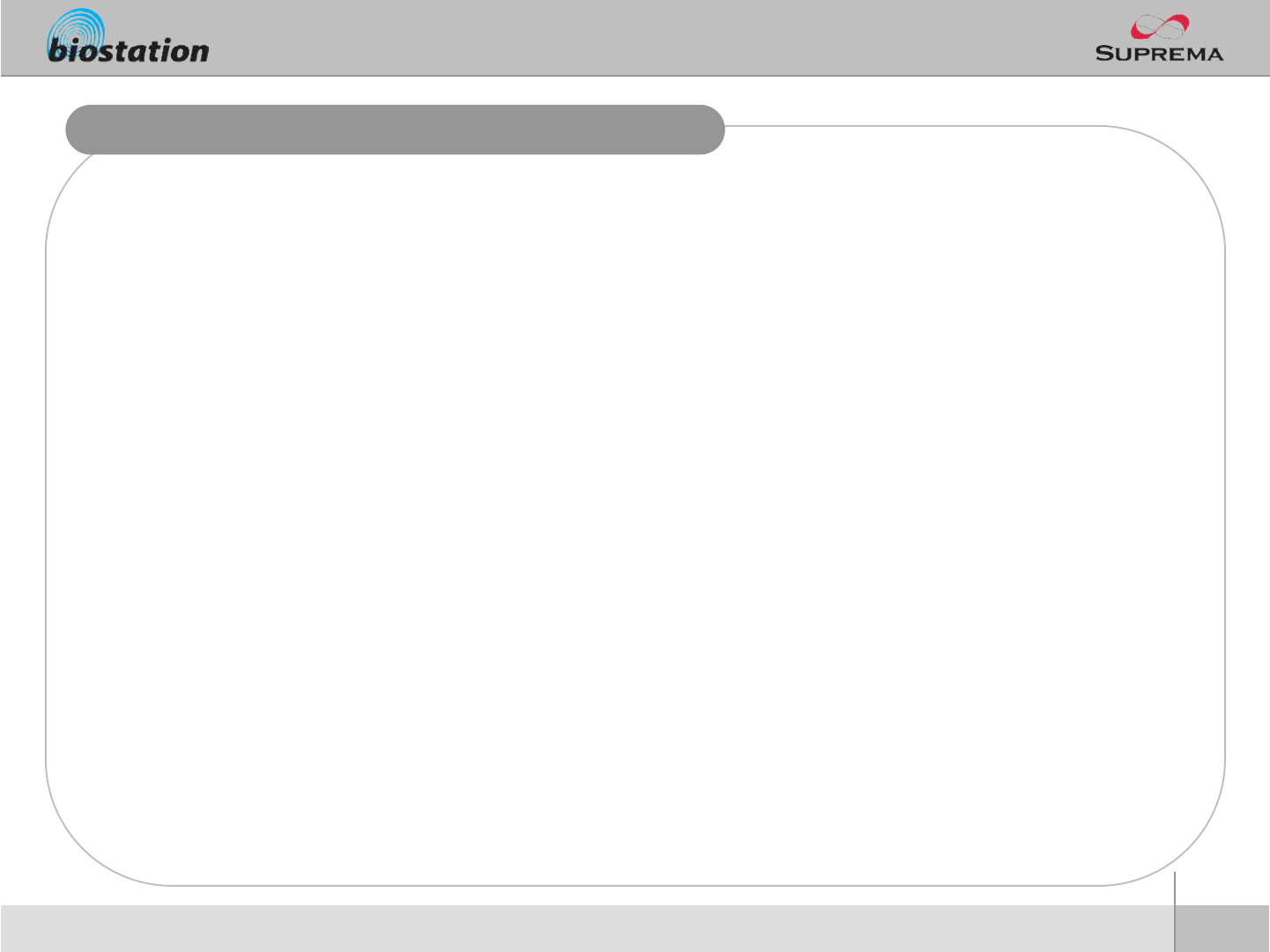
71
ⒸCopyright 2006 Suprema Inc.
Troubleshooting
nFingerprint can not be read well or it takes too long.
lCheck whether a finger or fingerprint sensor is stained with sweat, water, or dust
lRetry after wiping off finger and fingerprint sensor with dry towel.
lIf a fingerprint is way too dry, blow on the finger and retry.
nFingerprint is entered but authorization keeps failing.
lCheck whether the user is restricted by door zone or time zone.
lInquire of administrator whether the enrolled fingerprint has been deleted frin the device for some
reason.
lIf message ‘not enrolled ID’appears after ID is entered and OK is pressed, it means that the
fingerprint has not been enrolled.
nAuthorized but door is not opened.
lCheck whether the time is set as lock time.
lCheck ‘driven by’on Admin menu.
lIn case it is set as disabled or selected T/A events, door may not open.
nPartial key can’t be entered or device is unstable.
lIn case device is unstable for any reason, enter Admin menu and reset device.
nAll keys are not entered
lIf LCD display and blue LED are off, it is possible that power is off. Check power condition such as
blackout.
lIf LCD display and blue LED are on, something is wrong with machine. In such a case, contact A/S
center.
Appendix
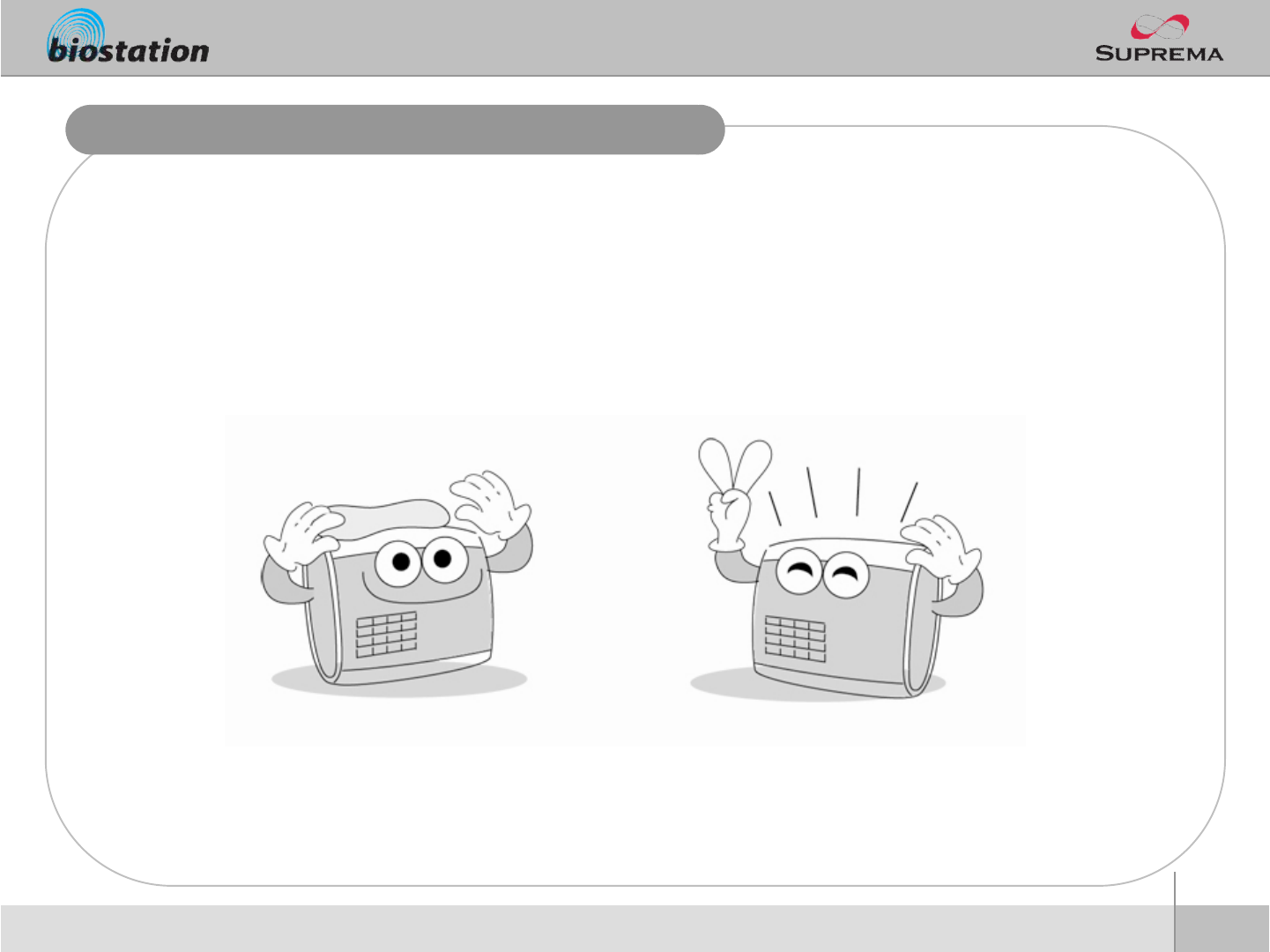
72
ⒸCopyright 2006 Suprema Inc.
Device cleaning
nWipe out machine surface with dry towel or cloth.
nIn case there is dust or impurities on the sensor of the BioStation, wipe off the surface with
dry towel.
nNote that if the sensor is cleaned by detergent, benzene or thinner, surface is damaged and
fingerprint can’t be entered.
Appendix
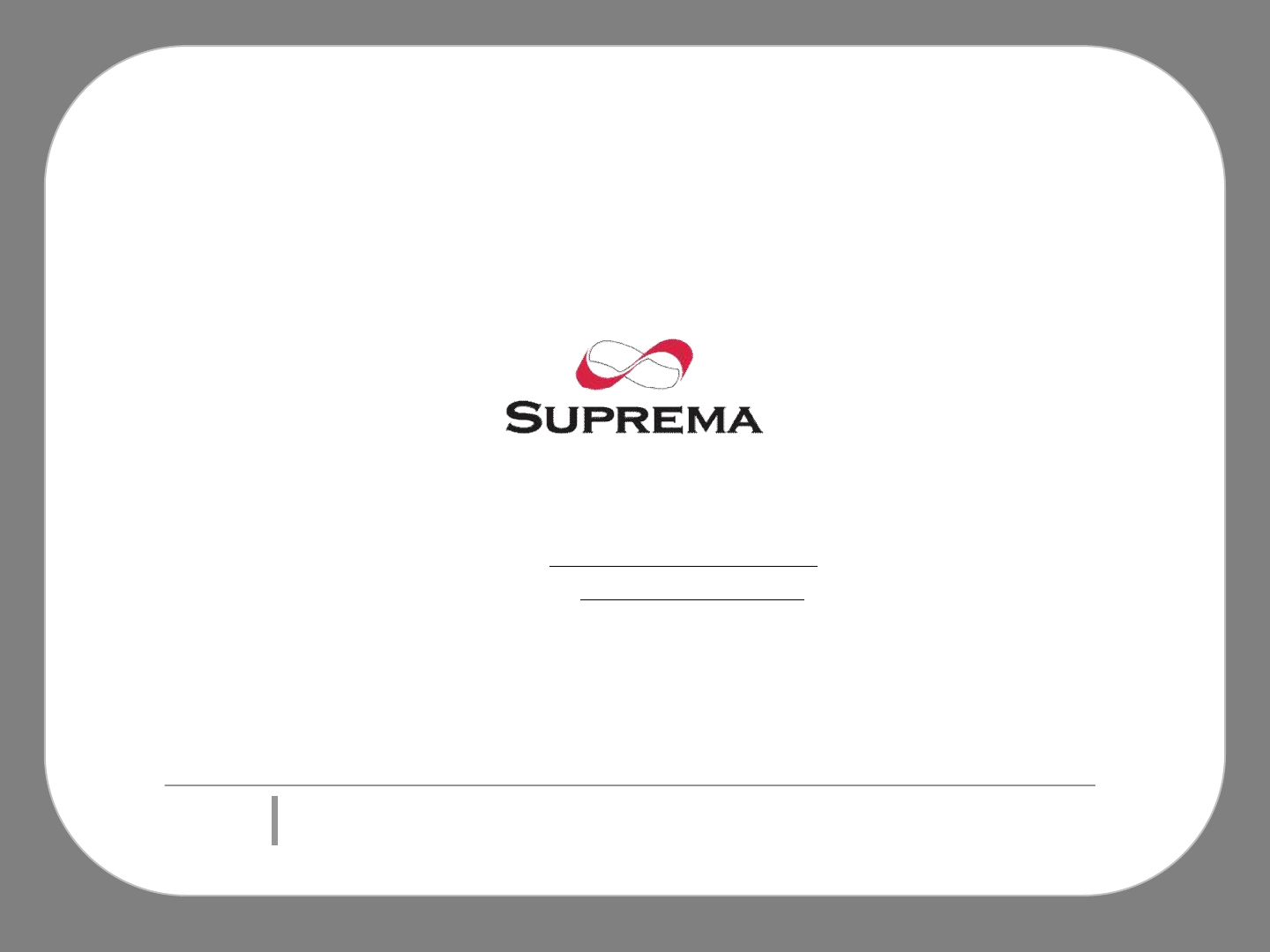
Technical Support & Inquiry
Suprema Inc.
16F Parkview Office Tower, Jeongja-dong, Bundang-gu,
Seongnam, Gyeonggi, 463-863 Korea
E-mail : support@supremainc.com
Website : www.supremainc.com
Functions and specifications of the product are subject to changes without notice due to quality
enhancement or function update. For any inquiry on the product, please contact Suprema Inc.
